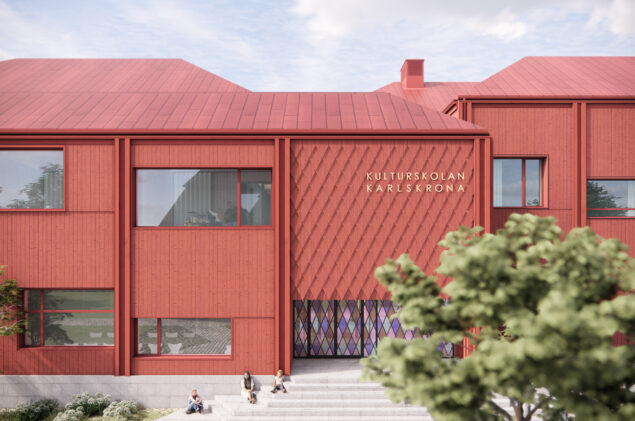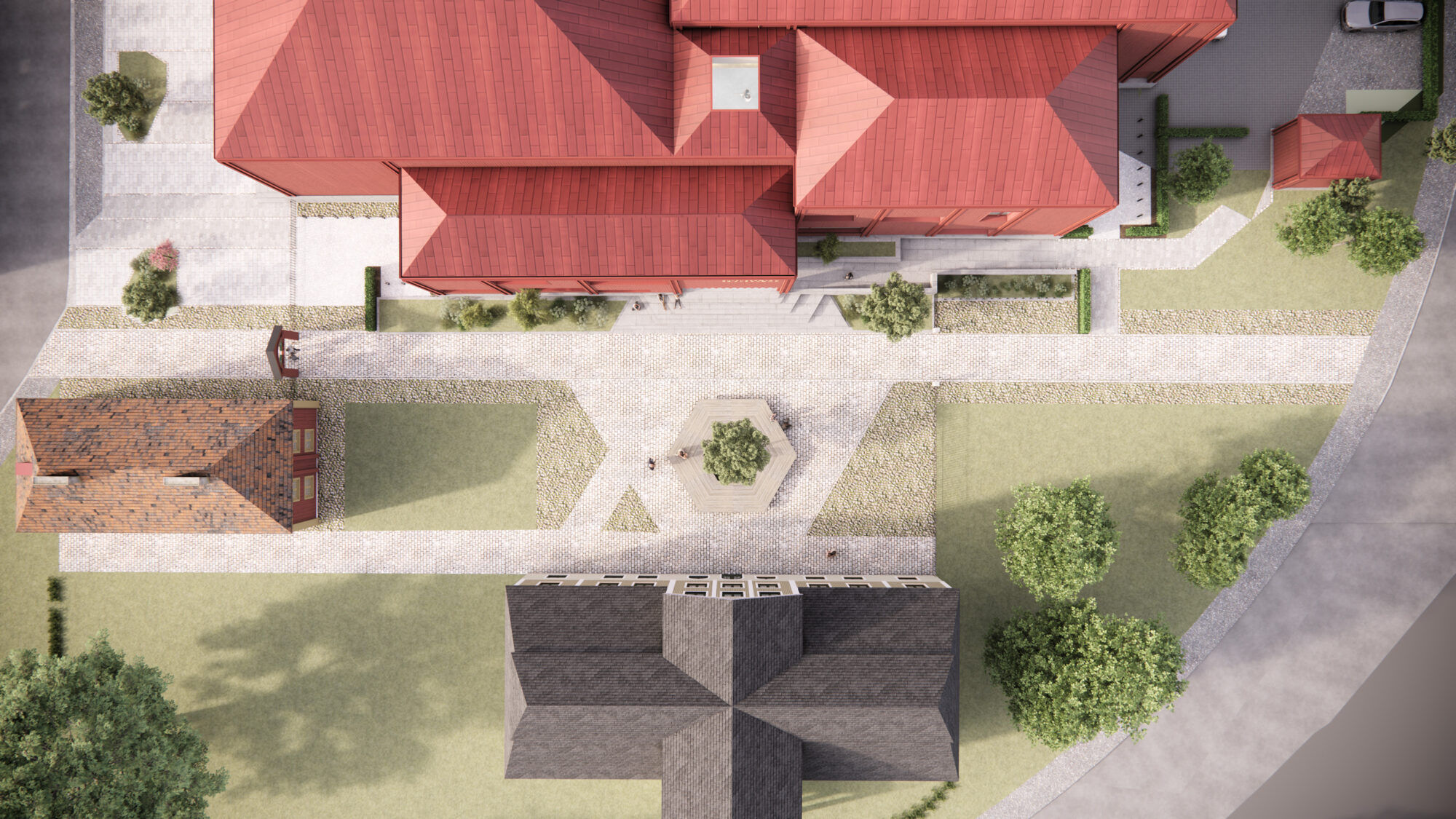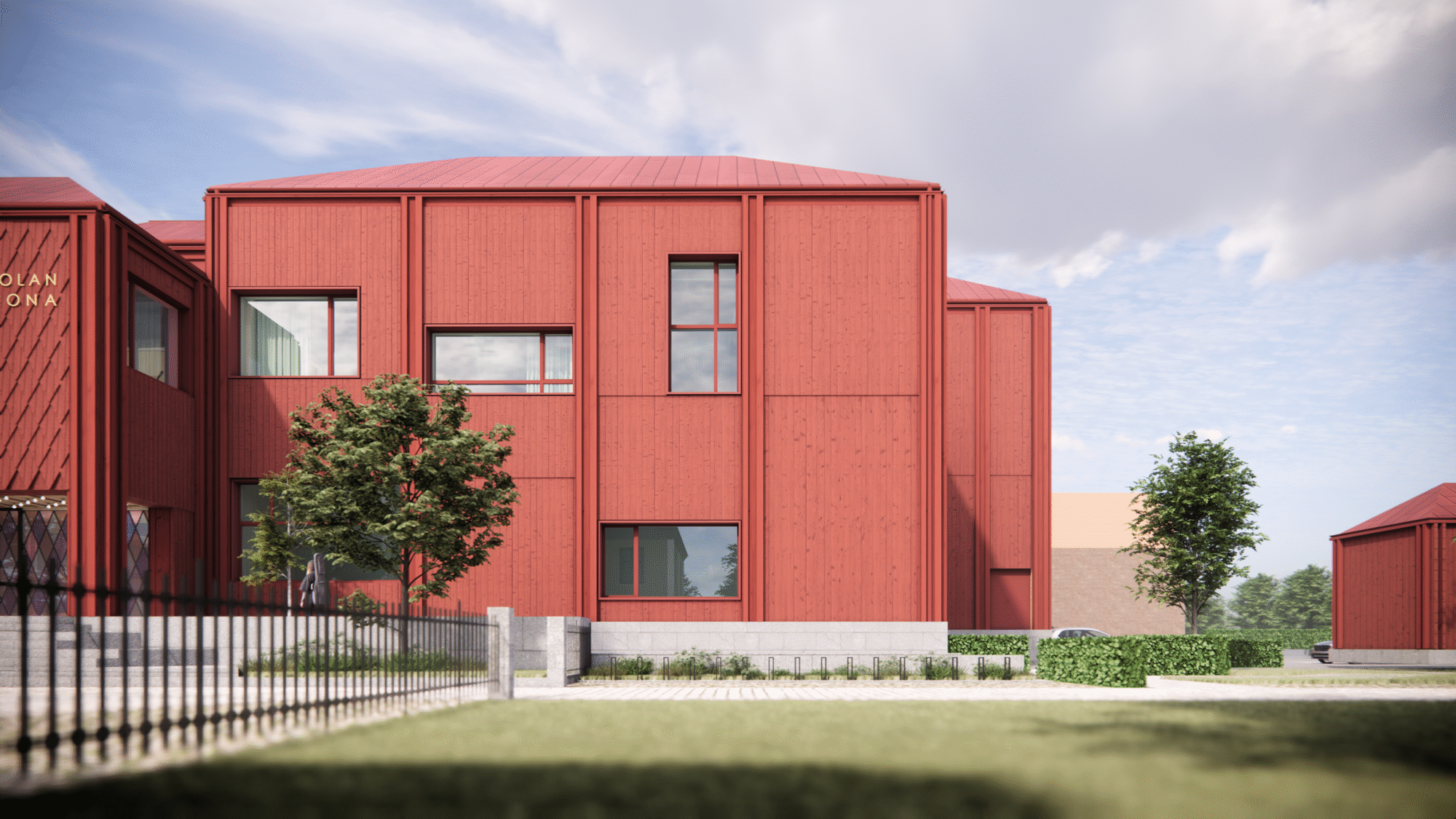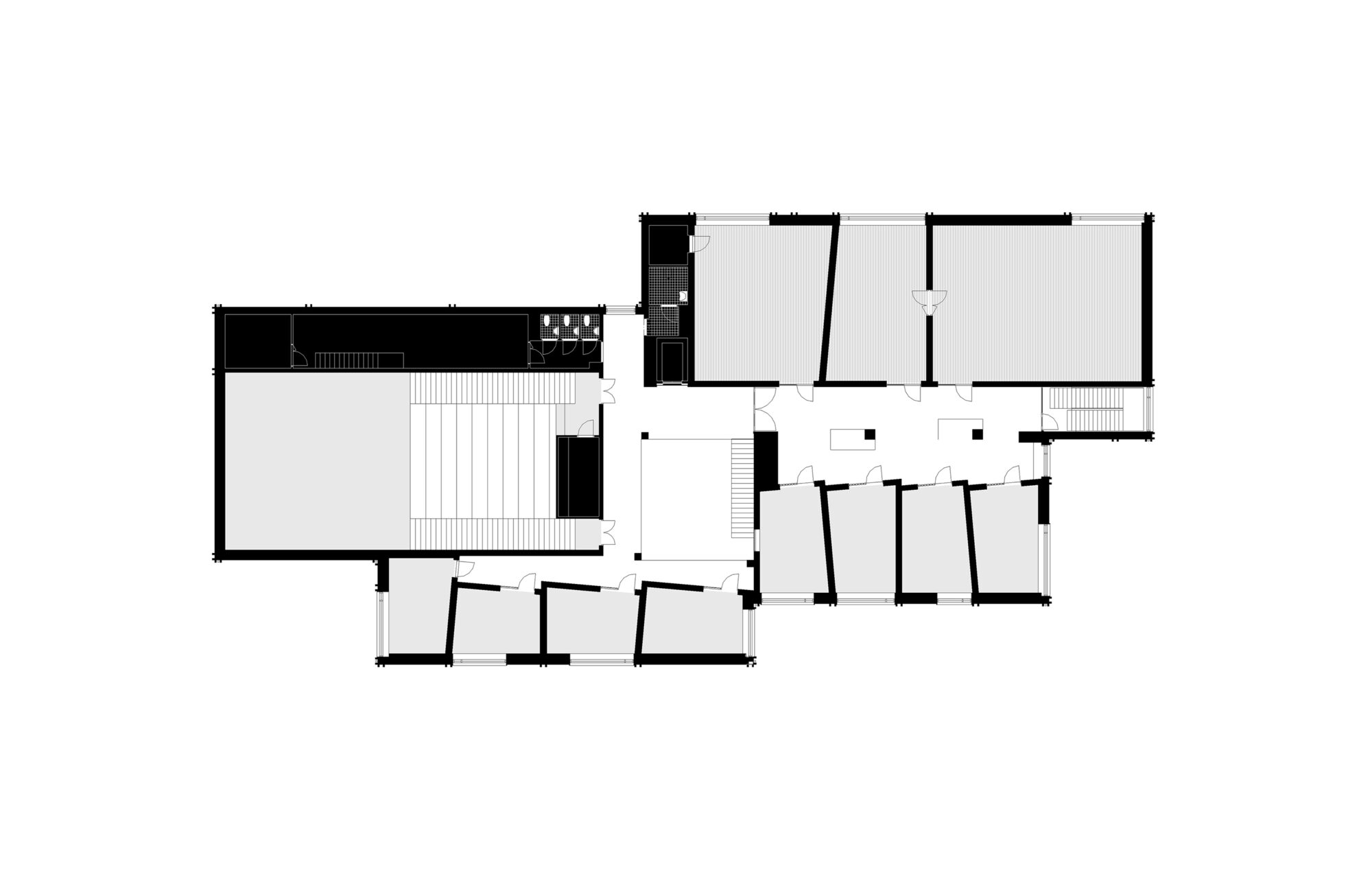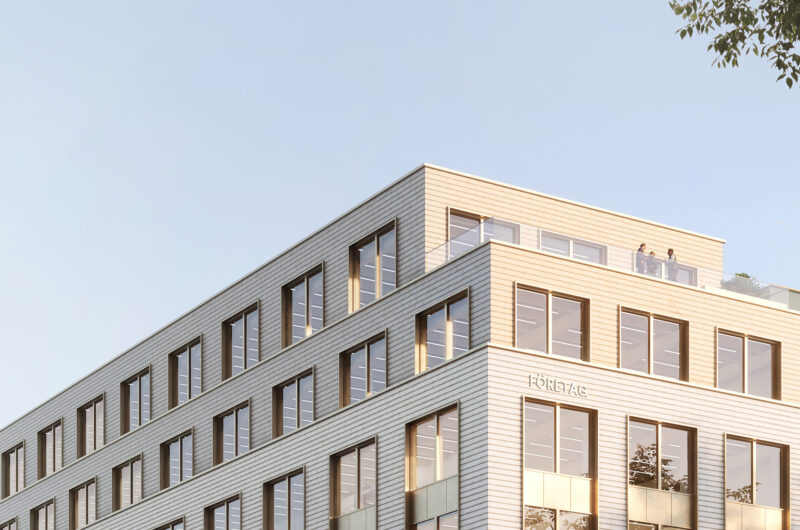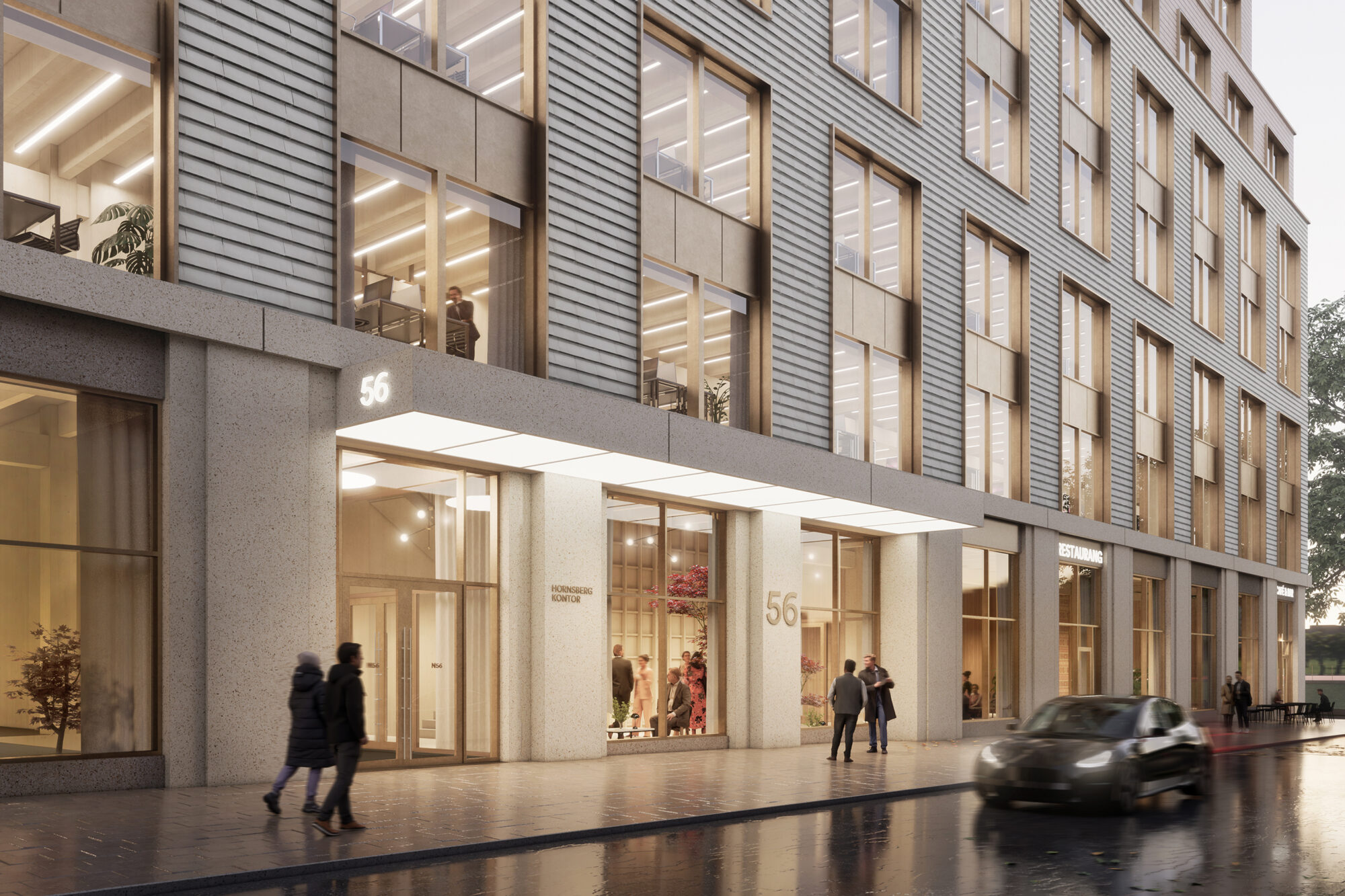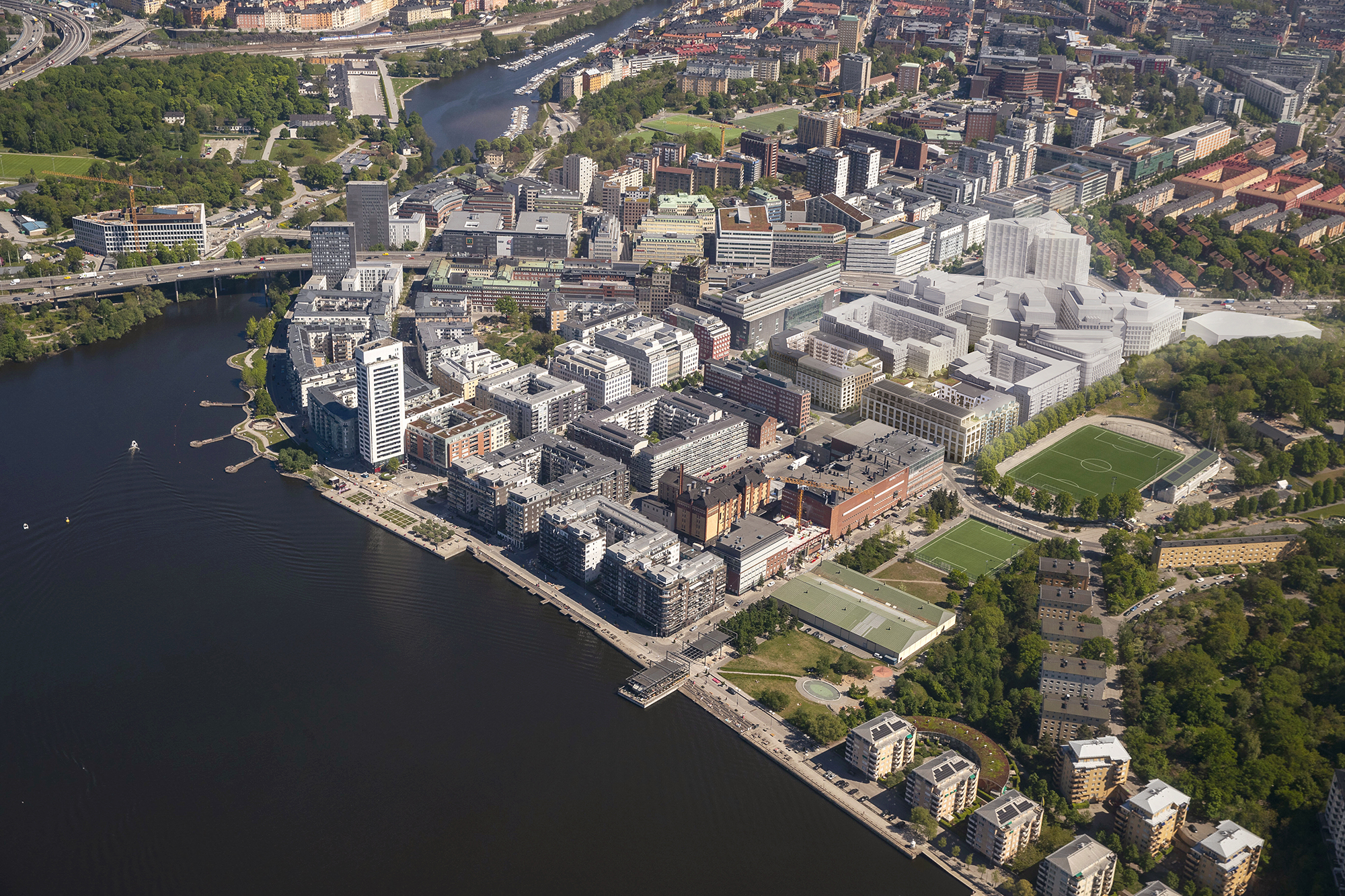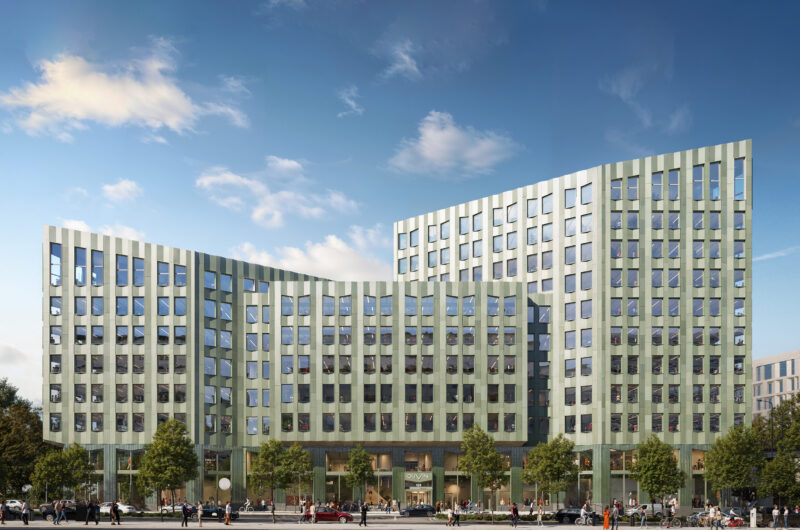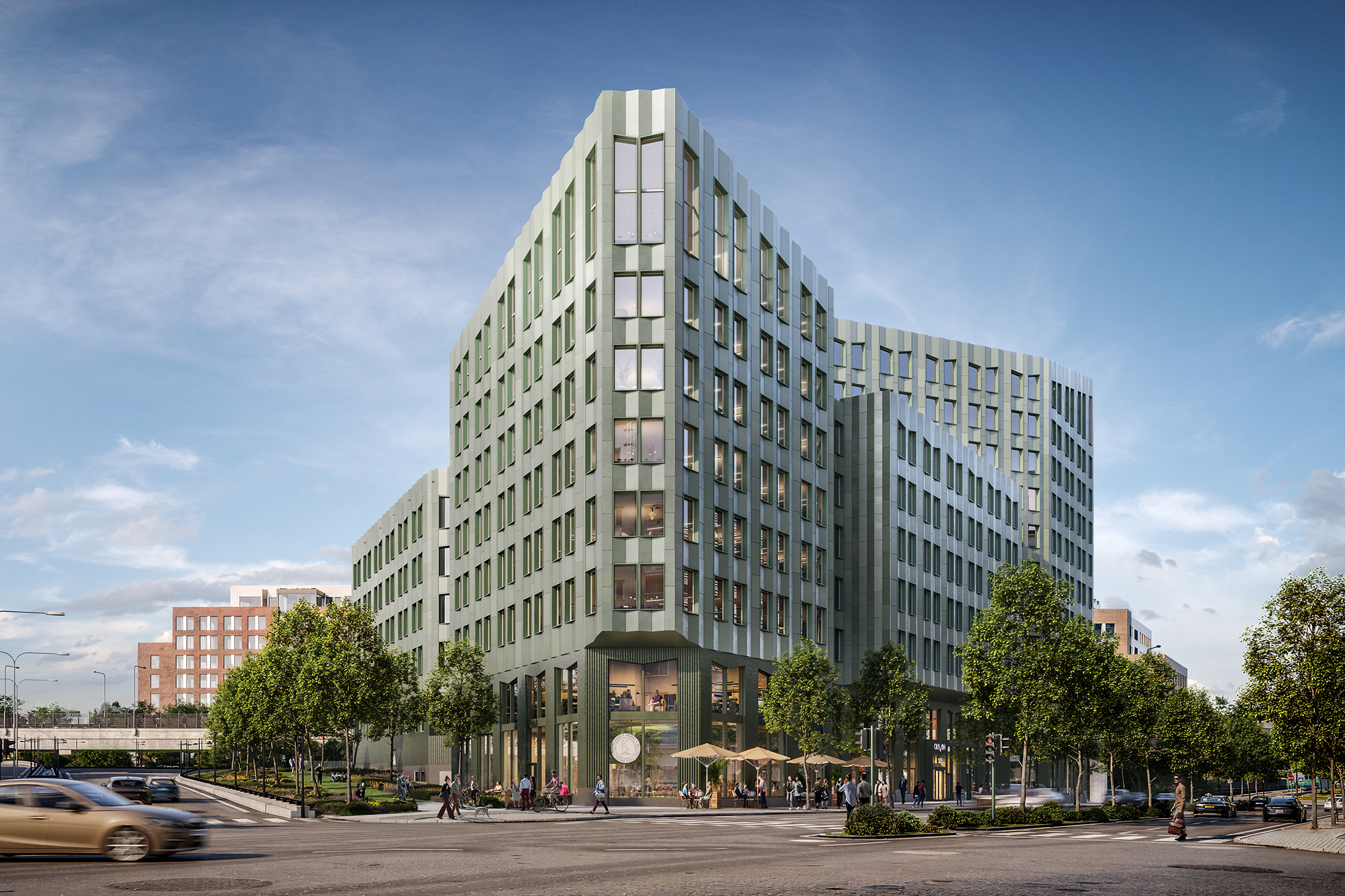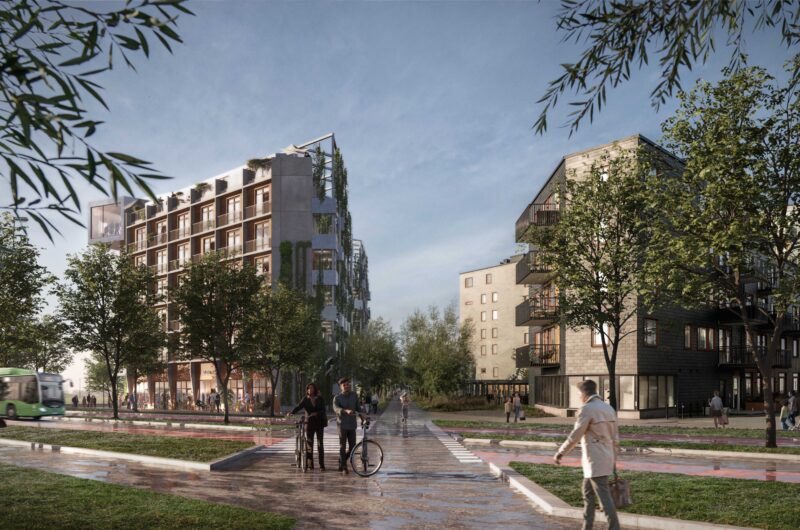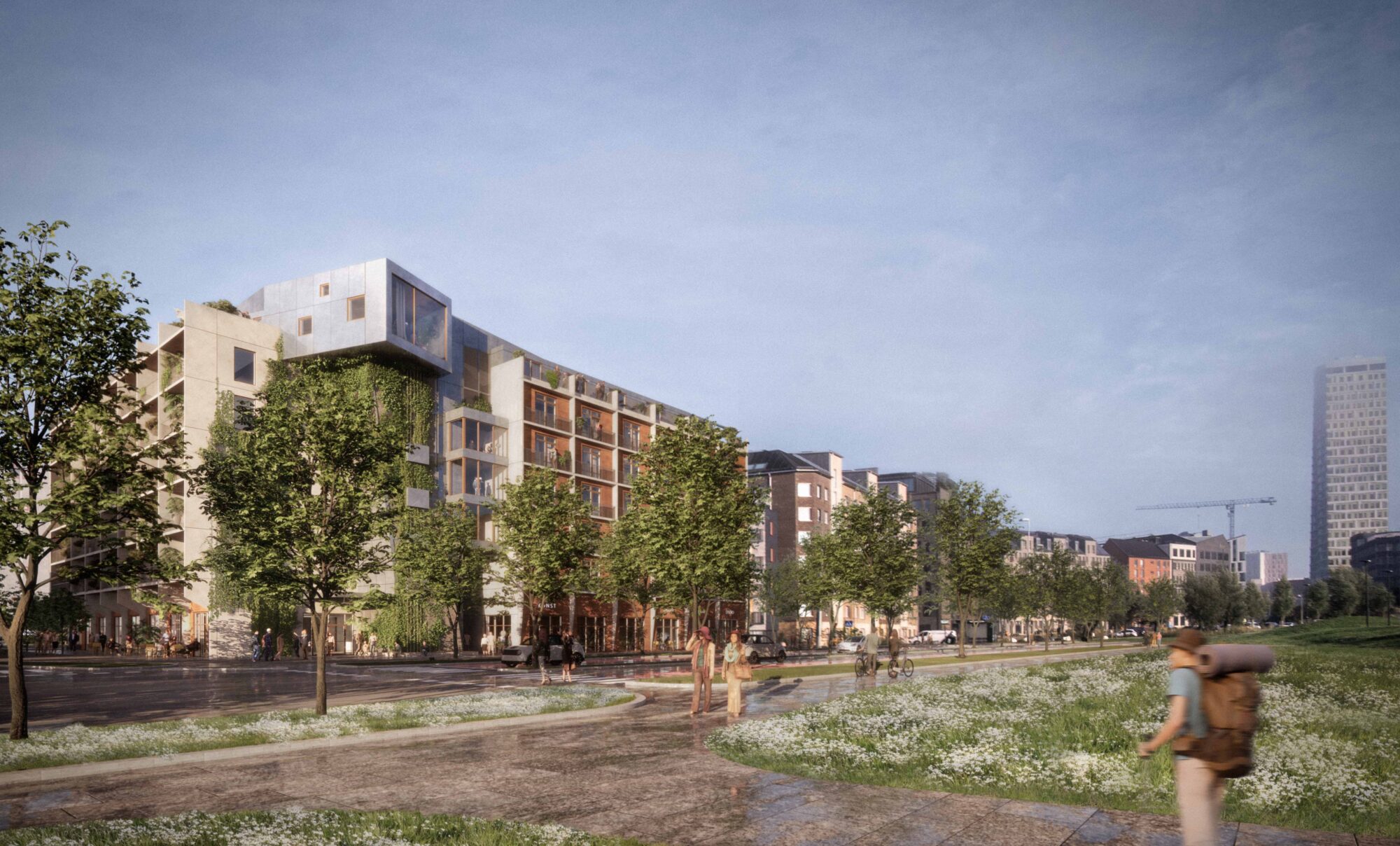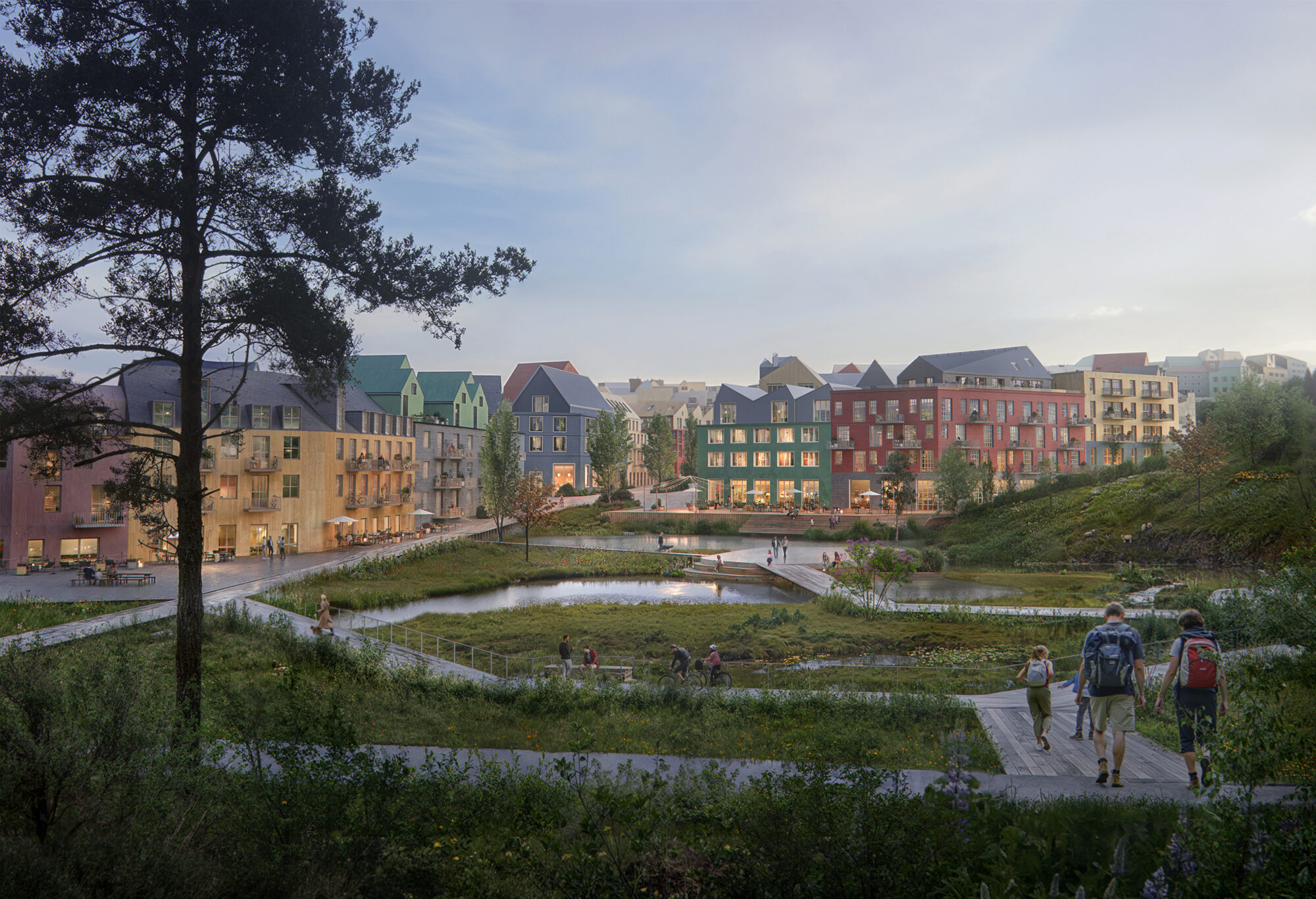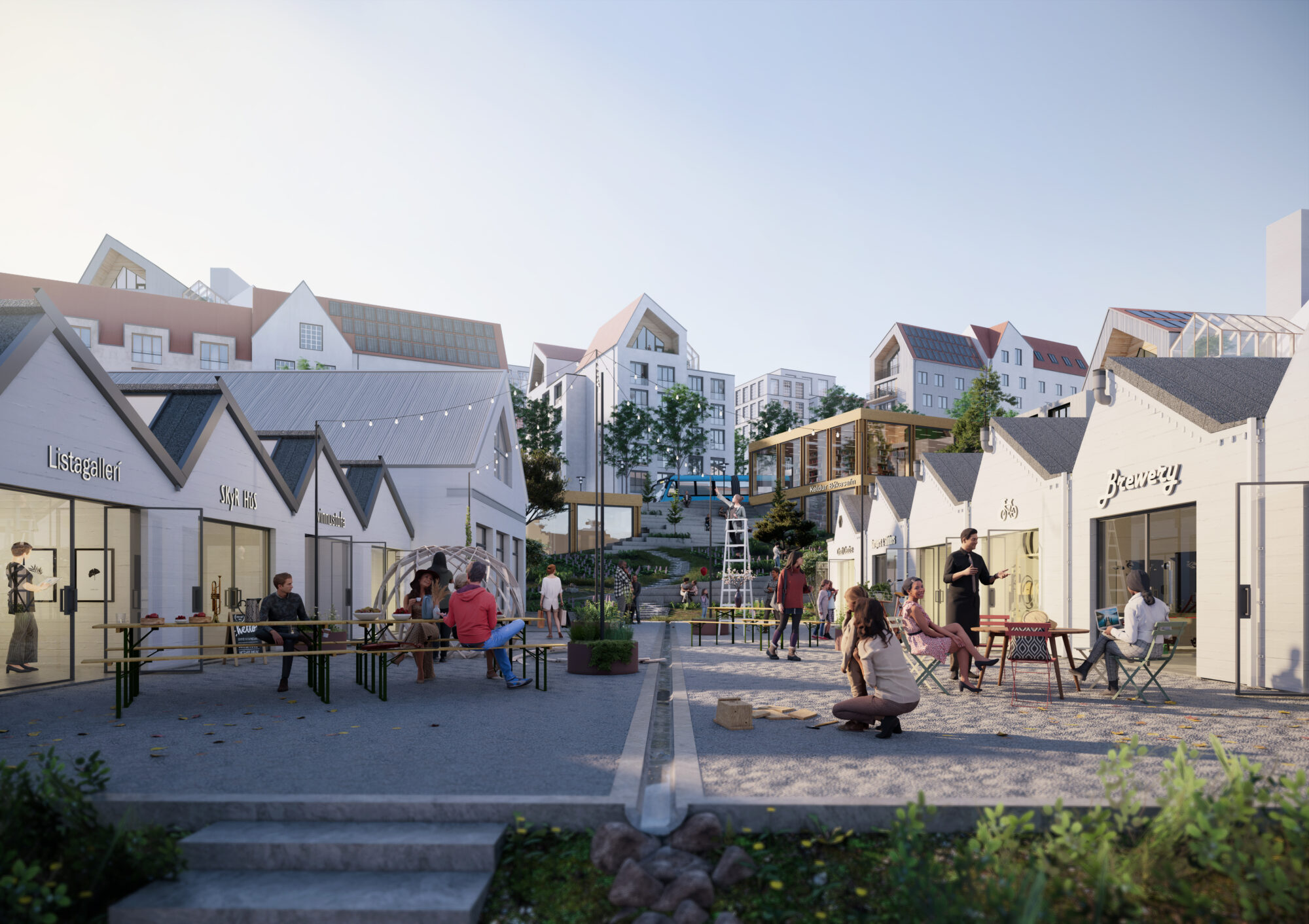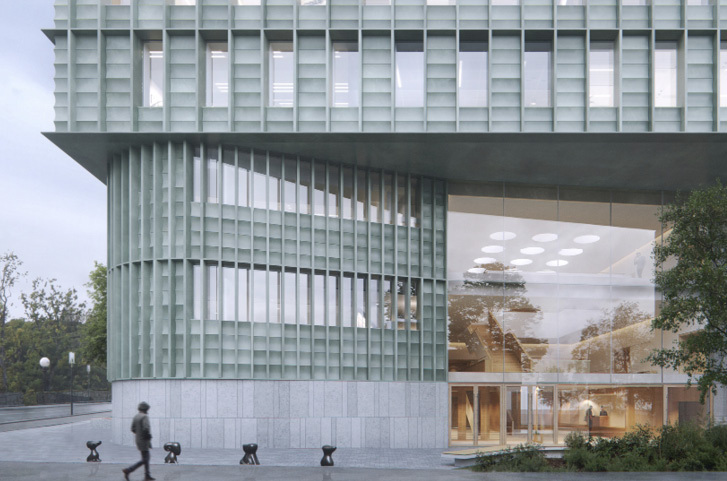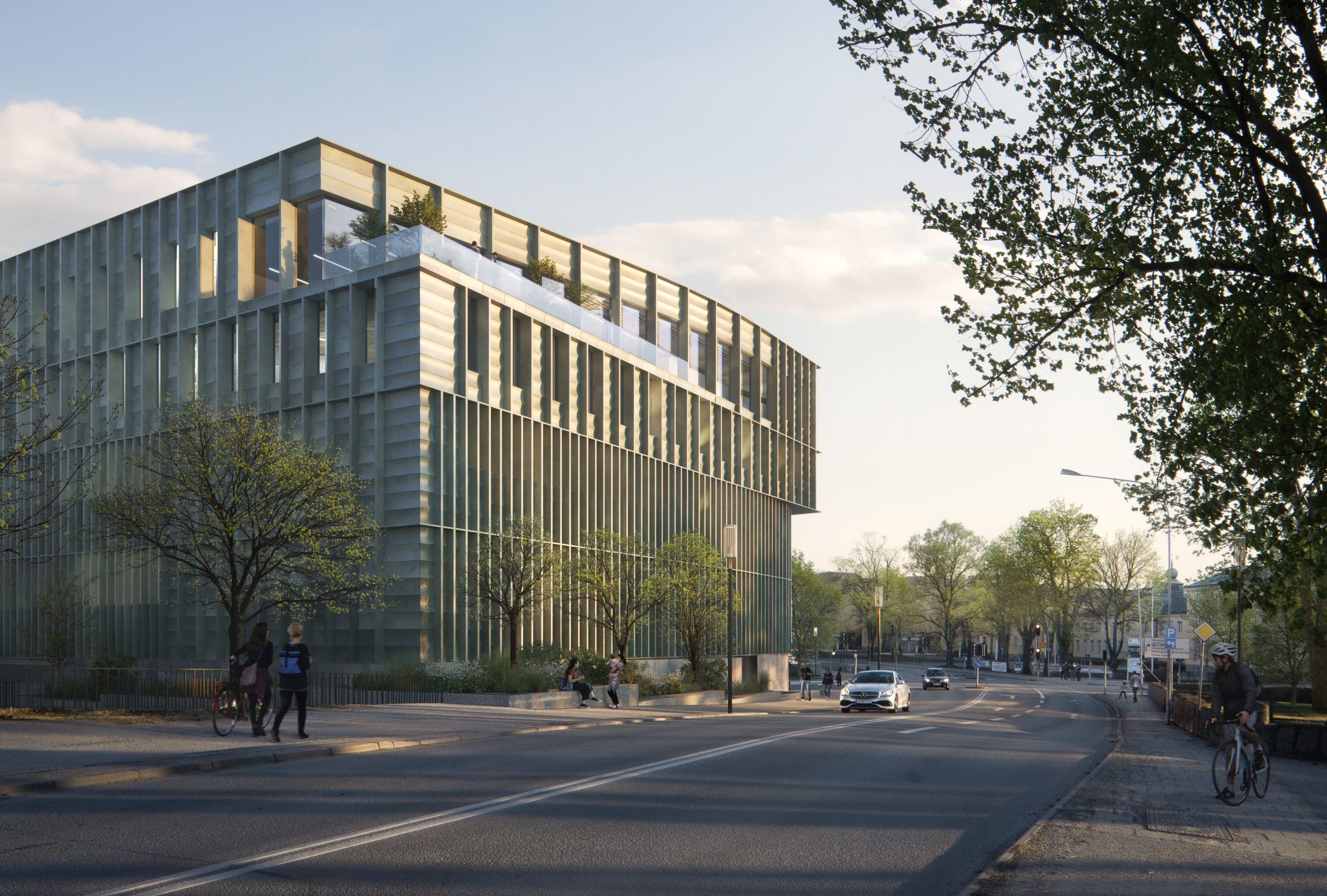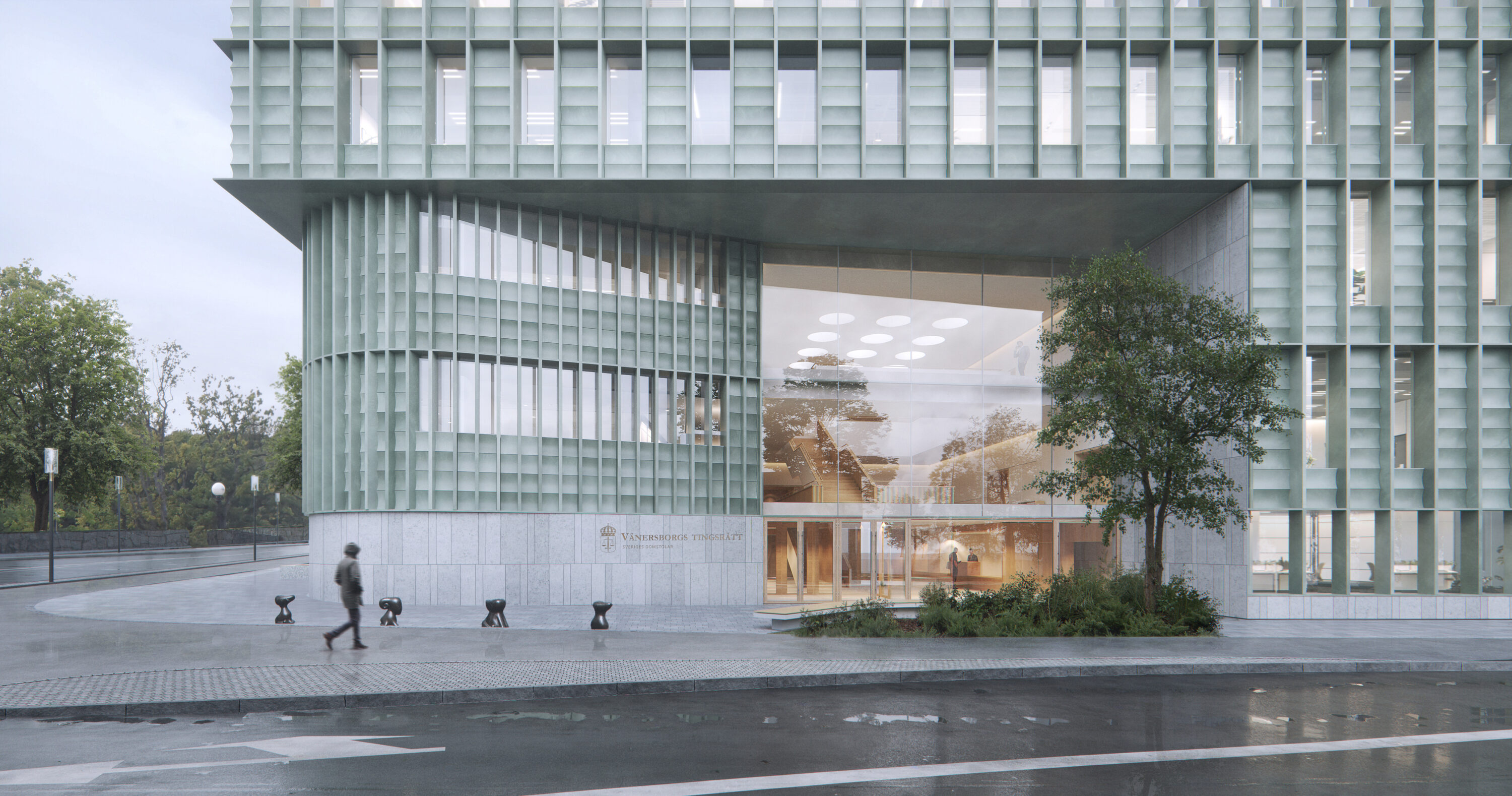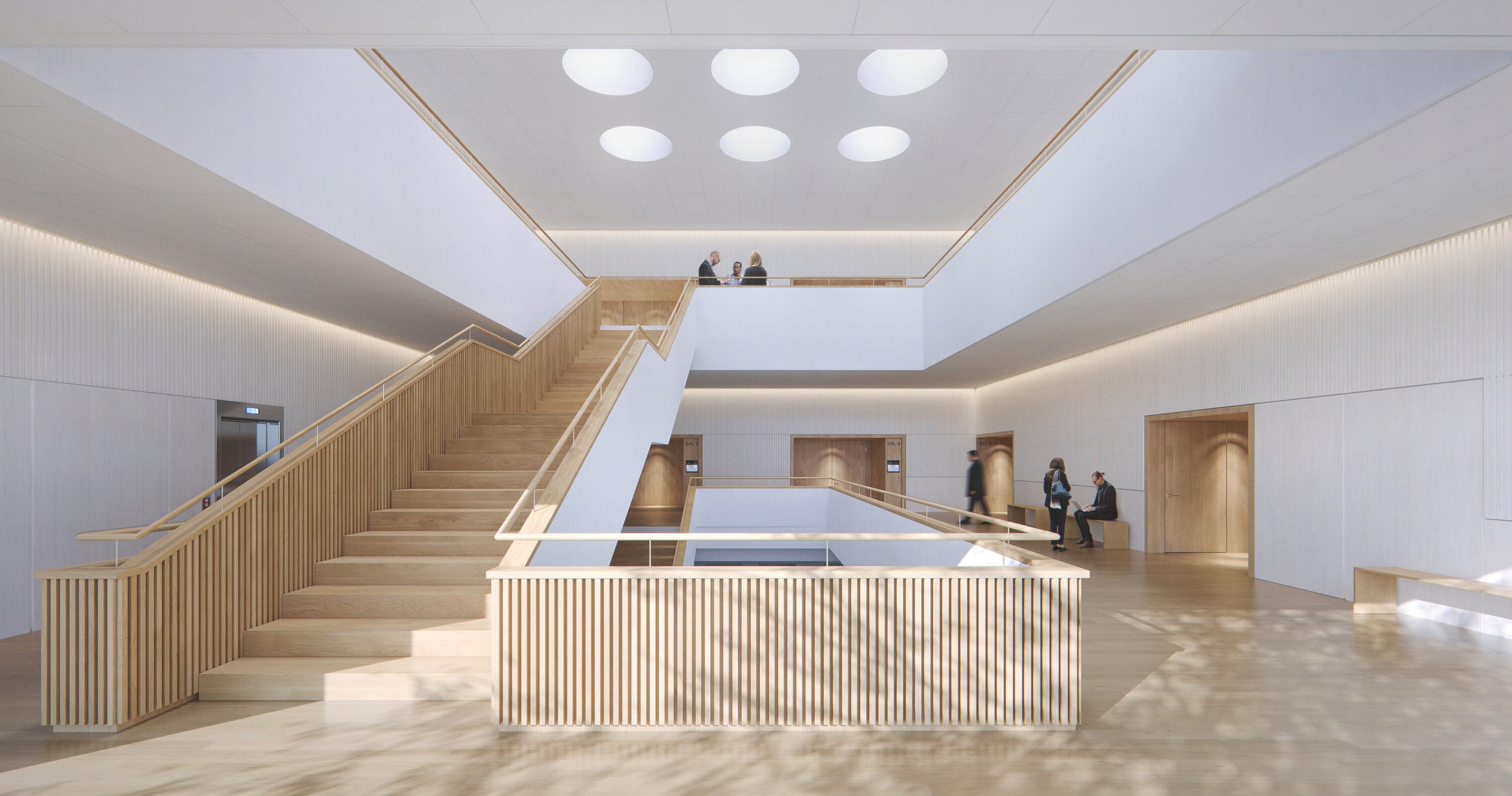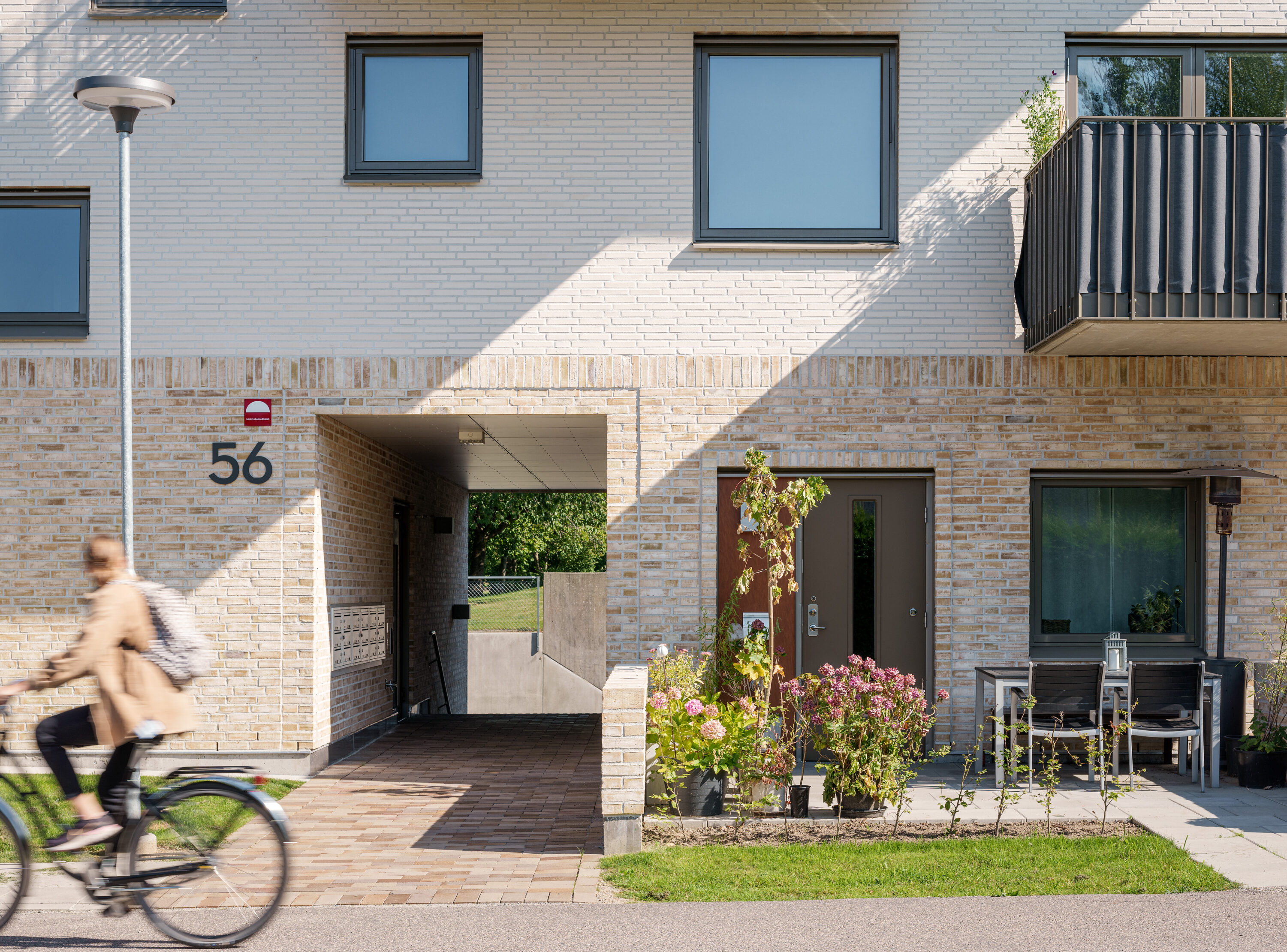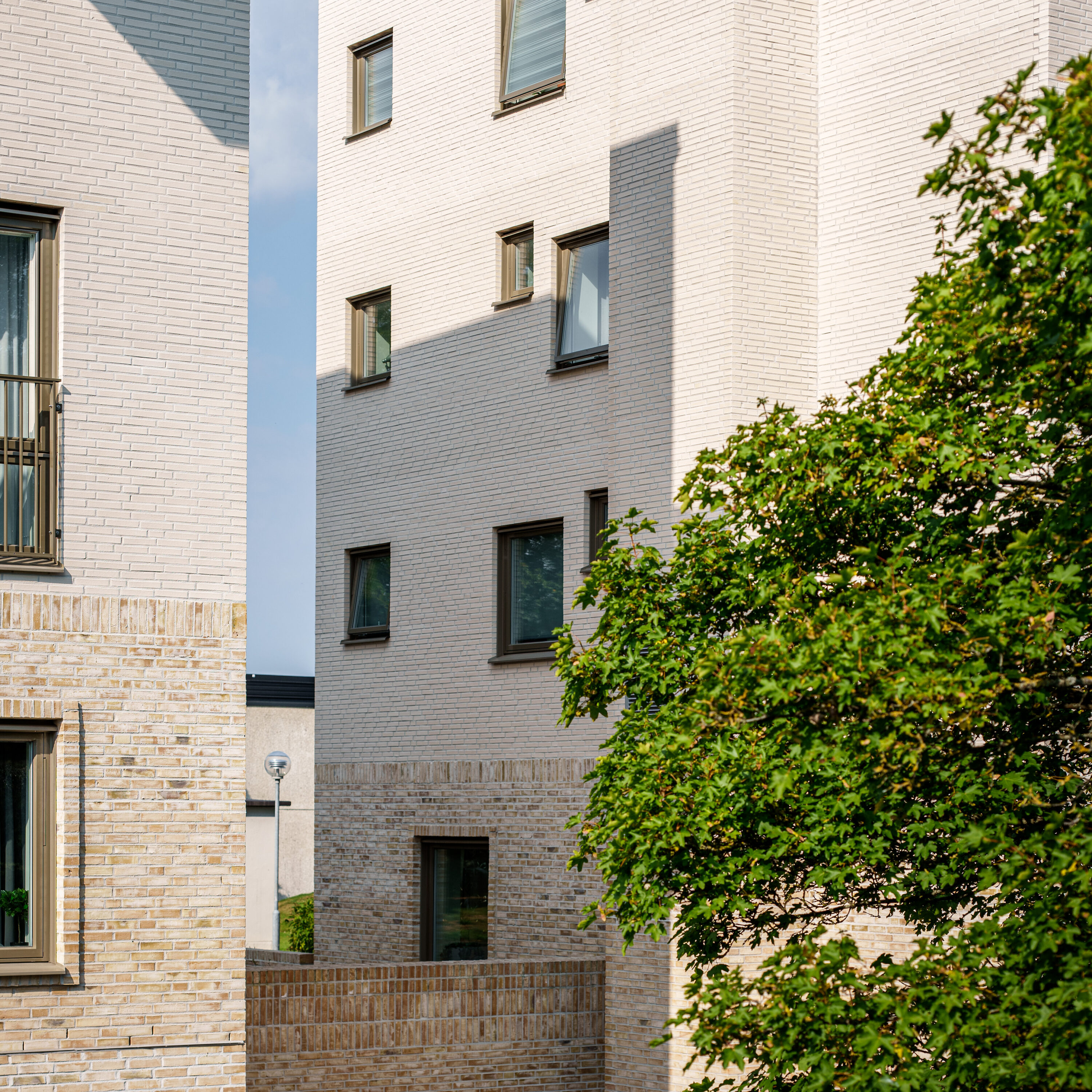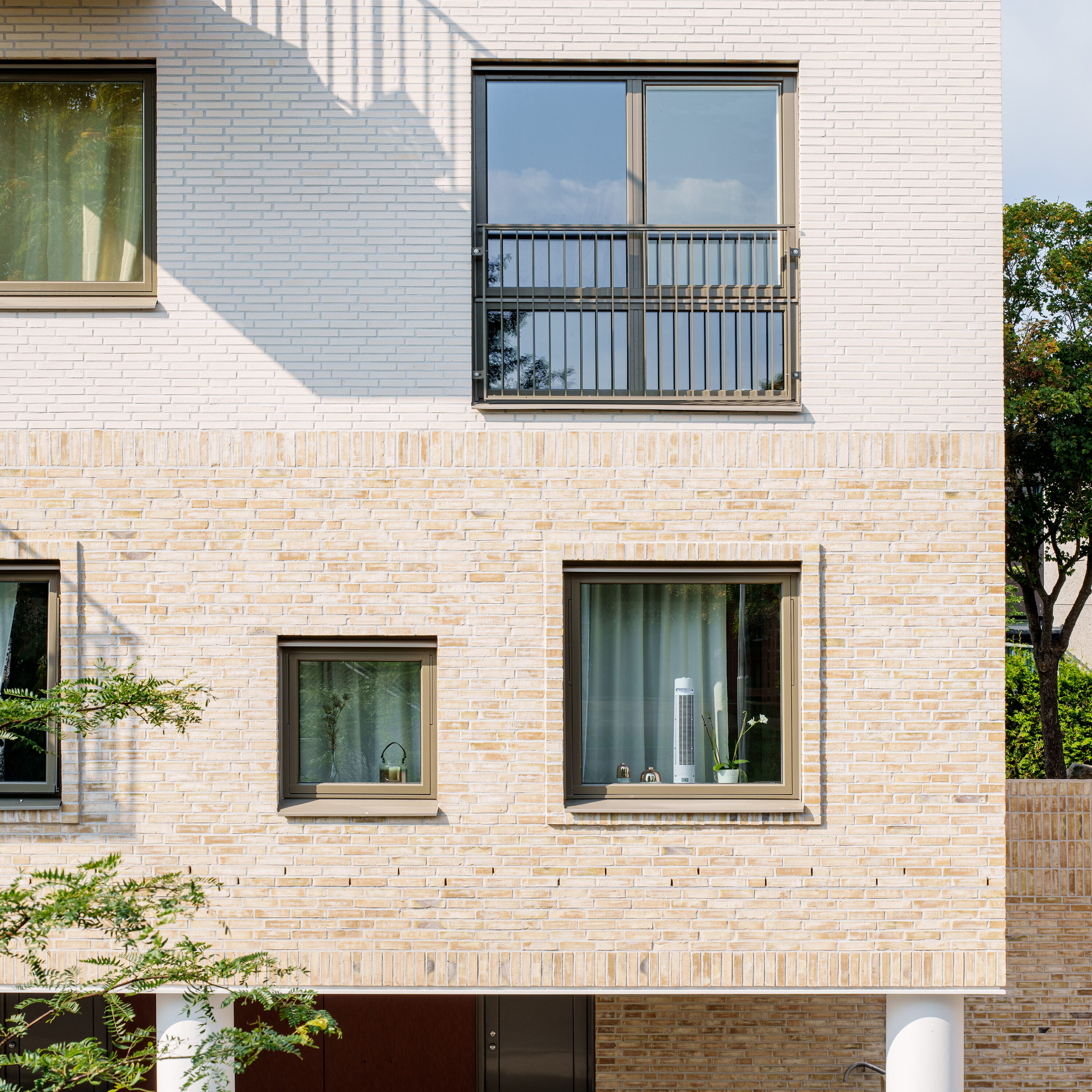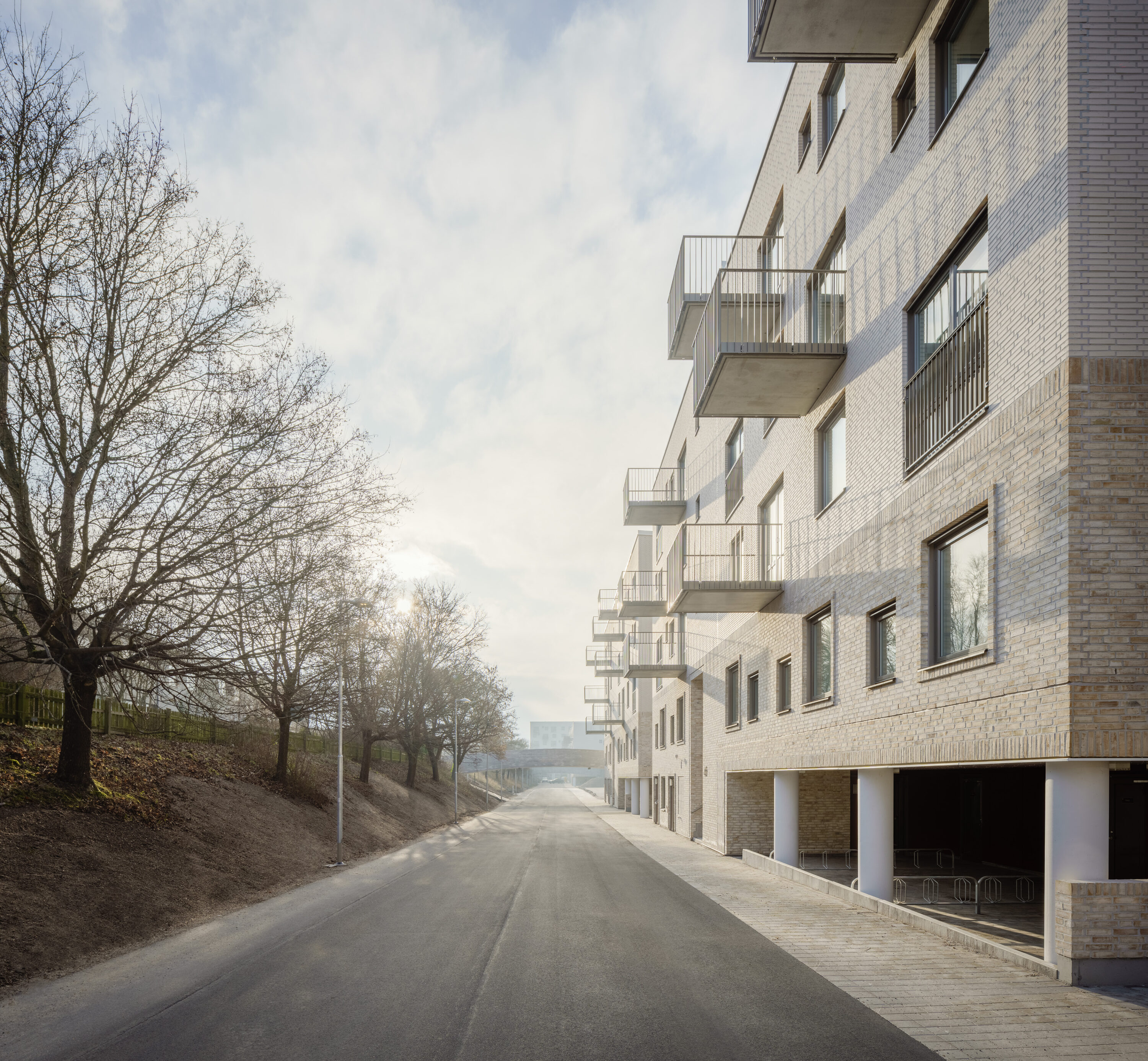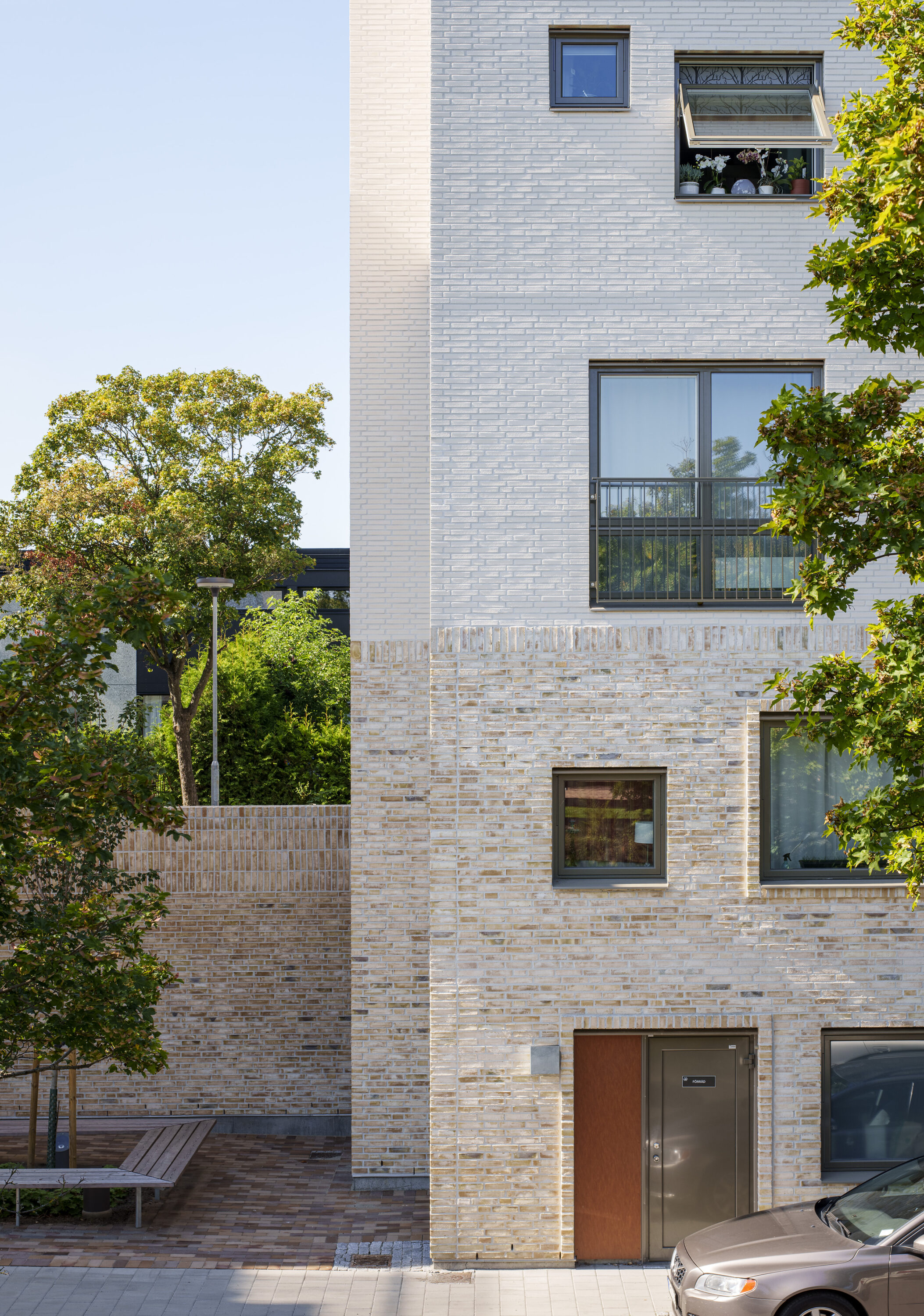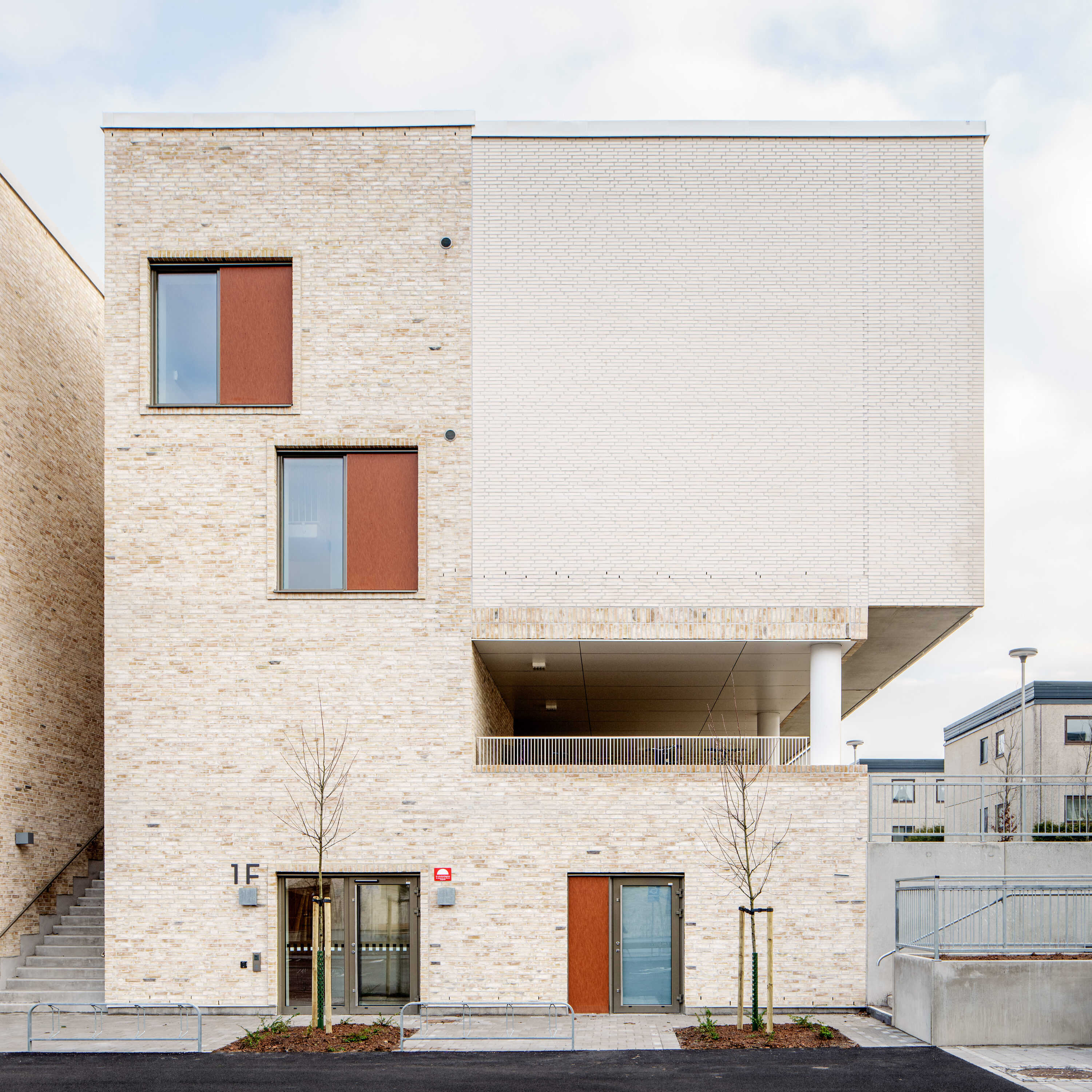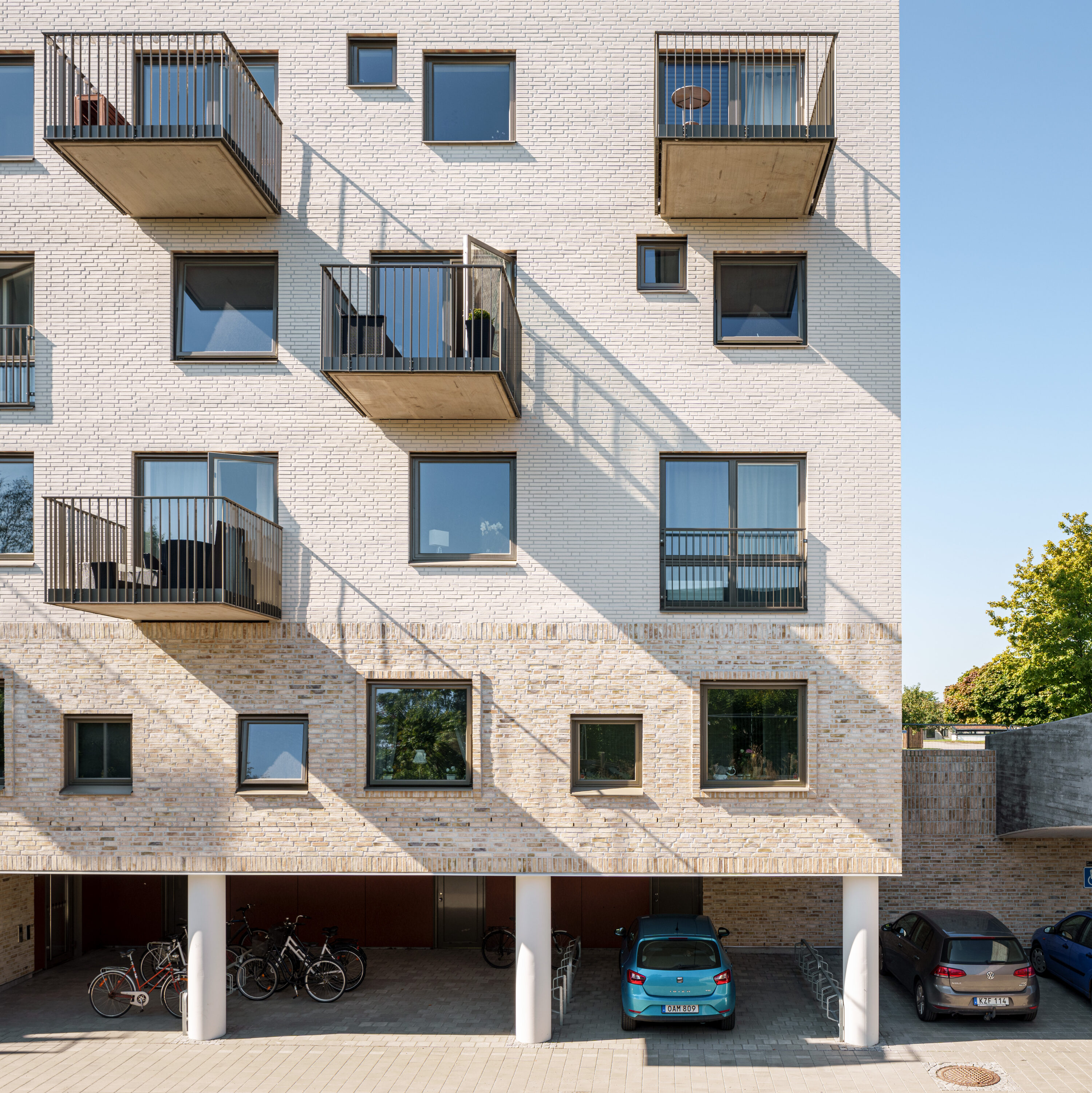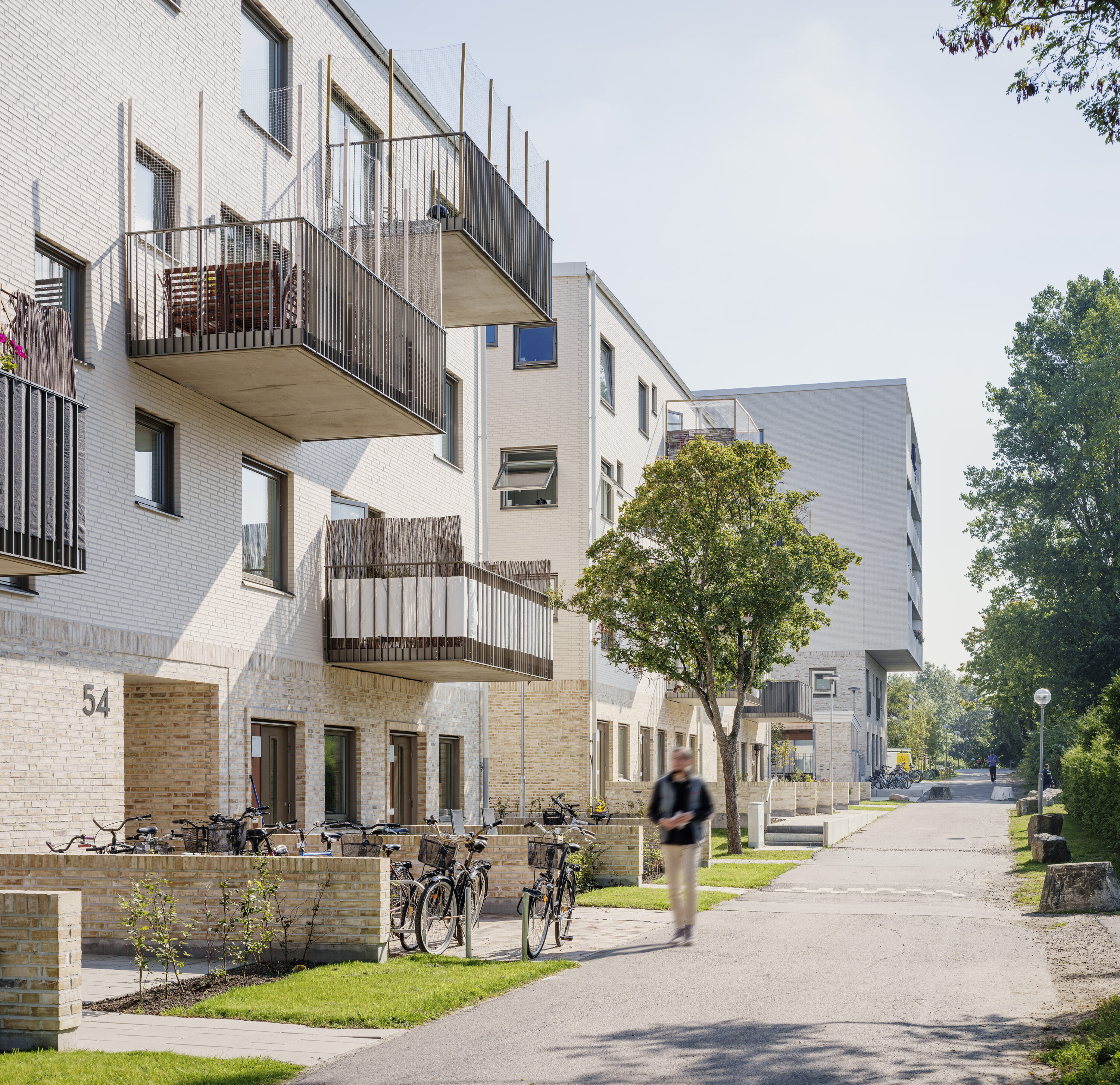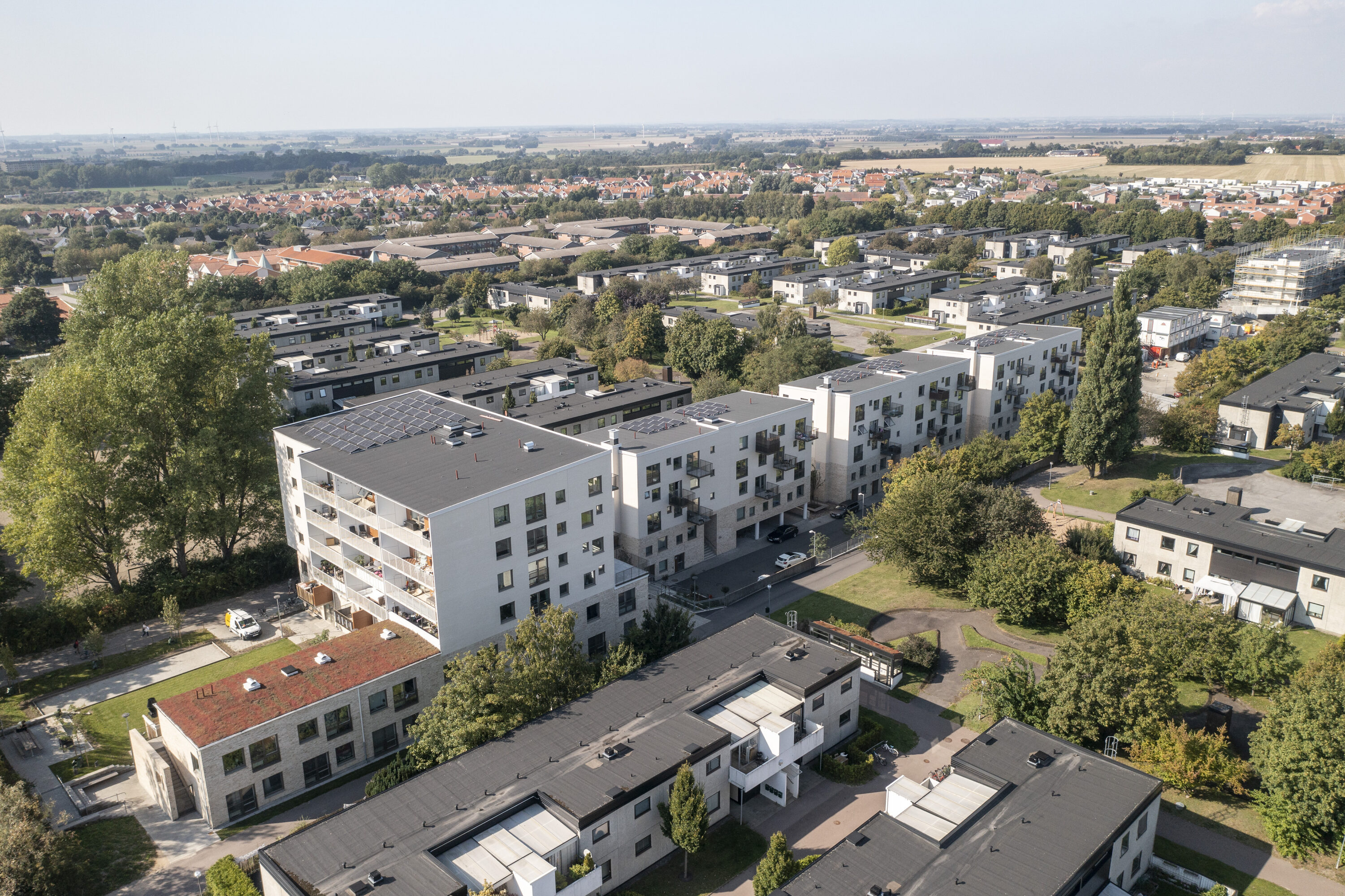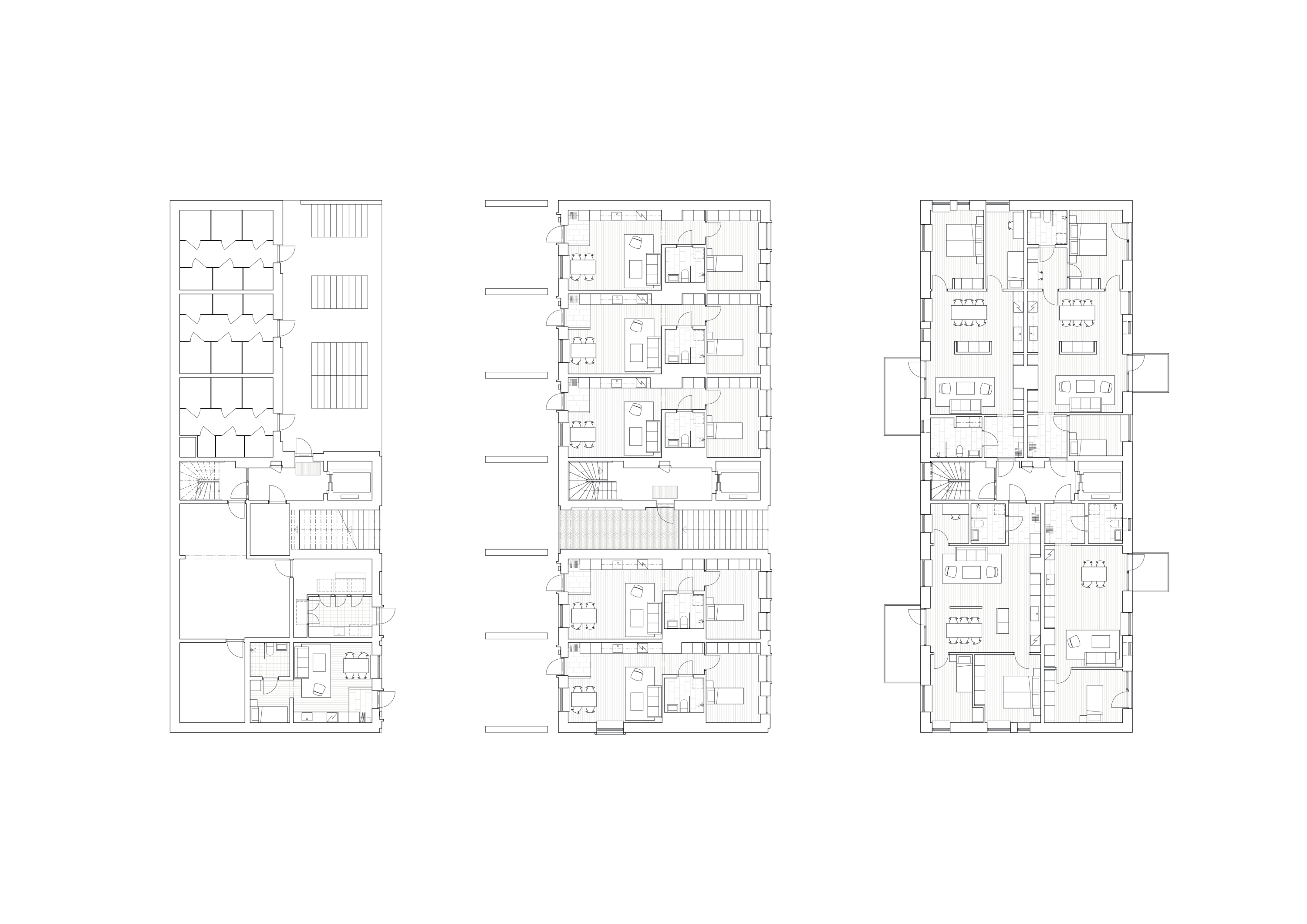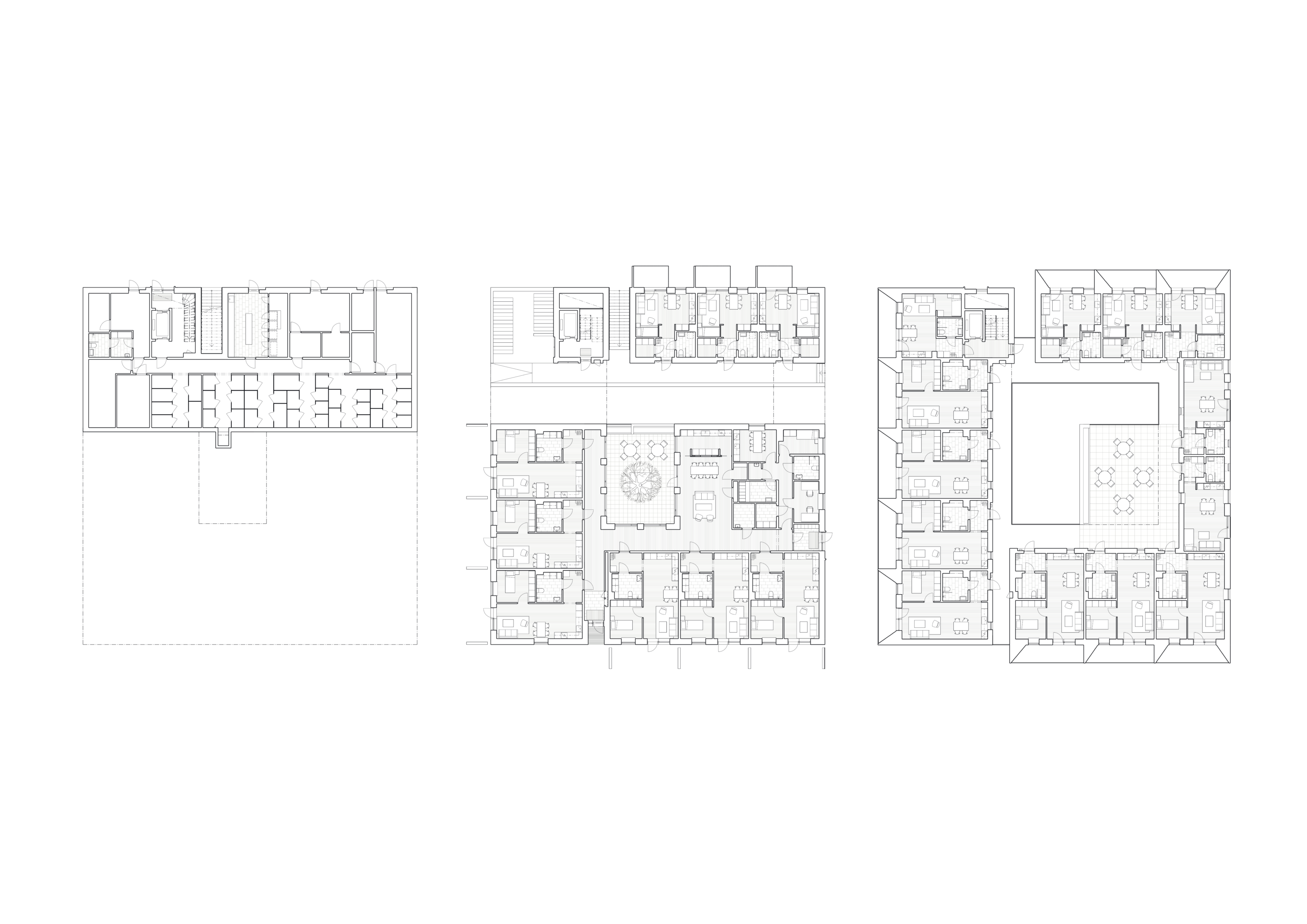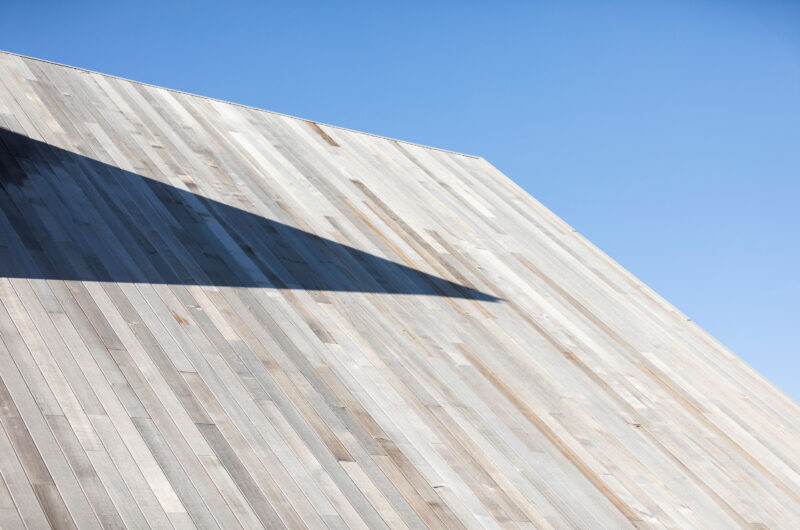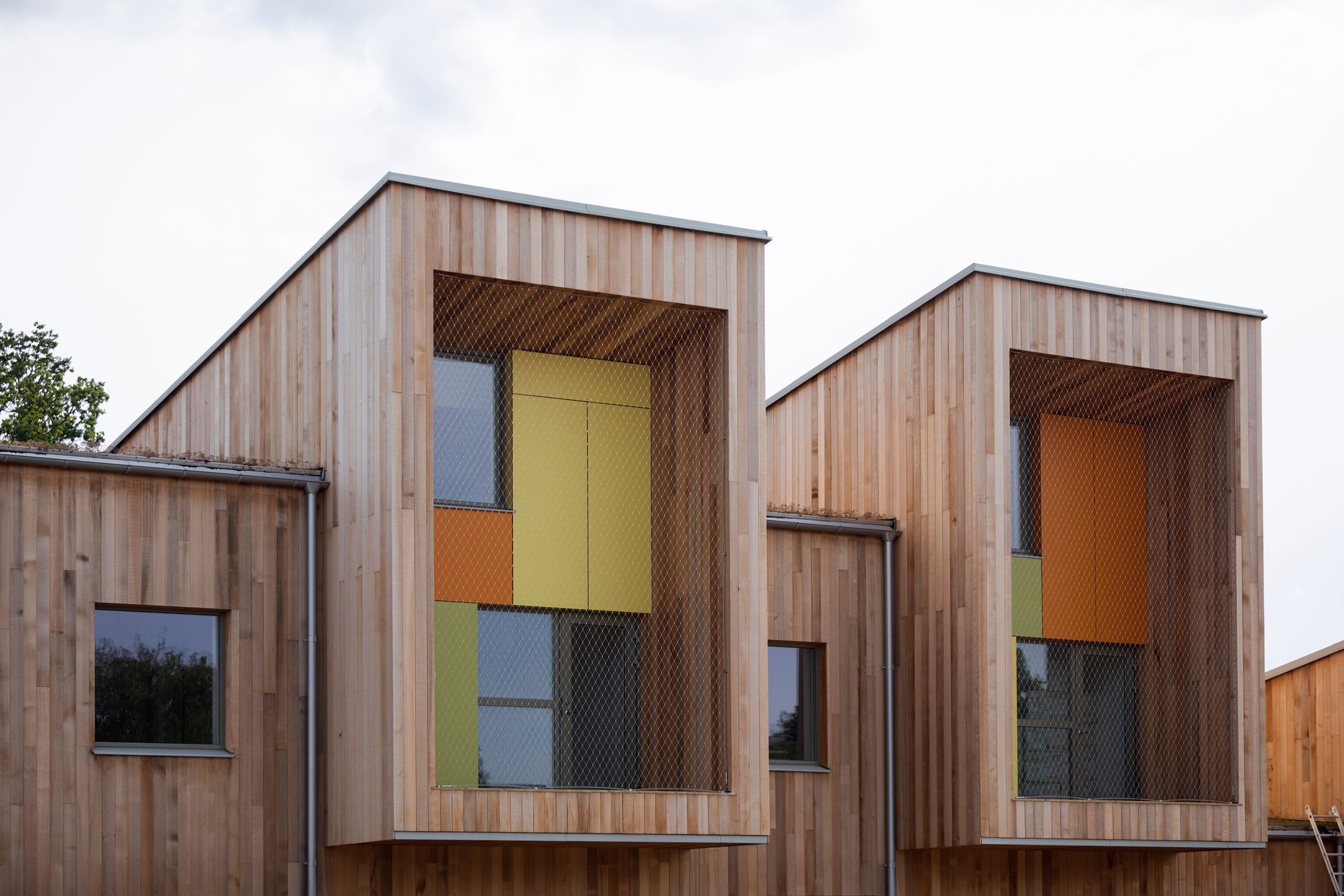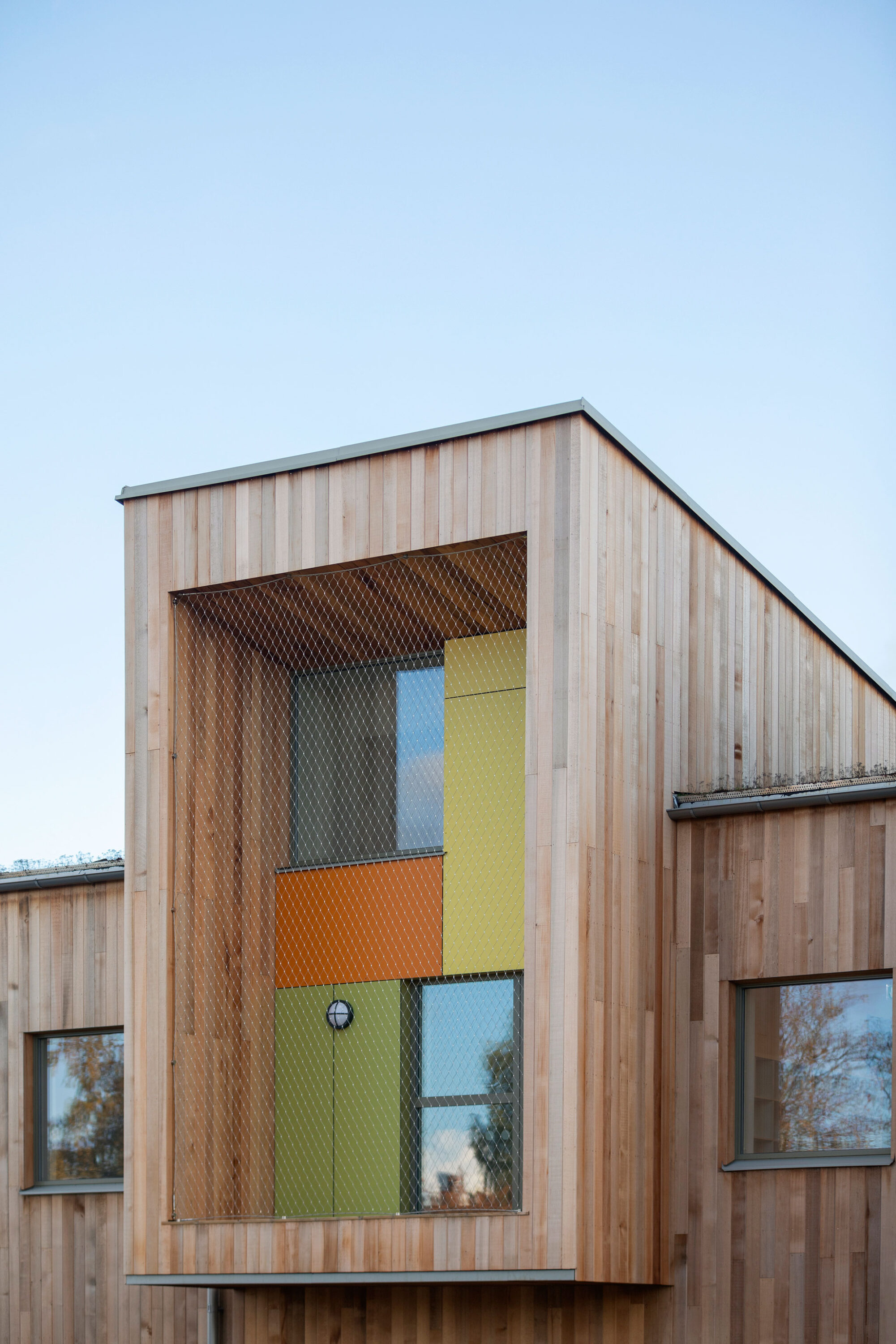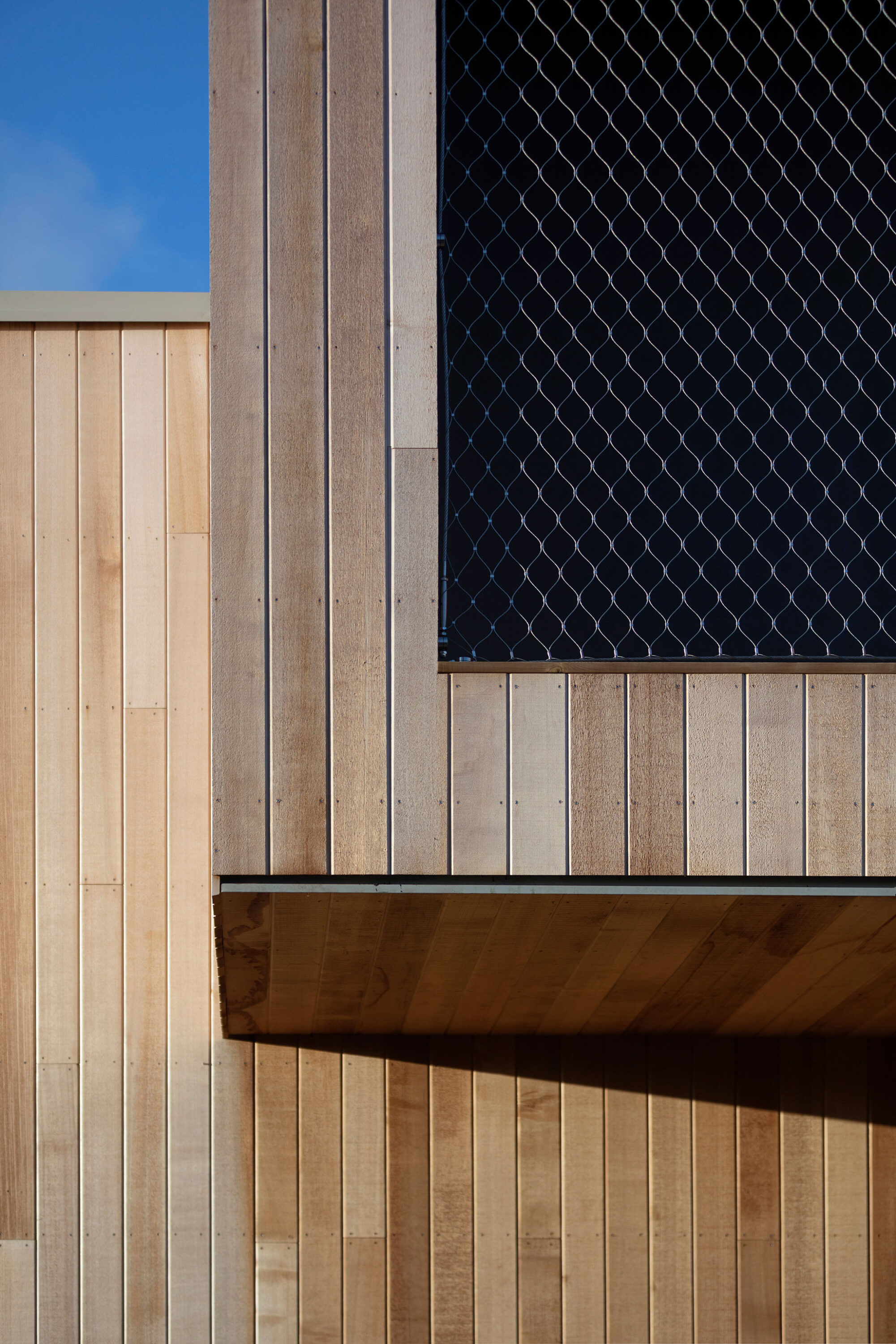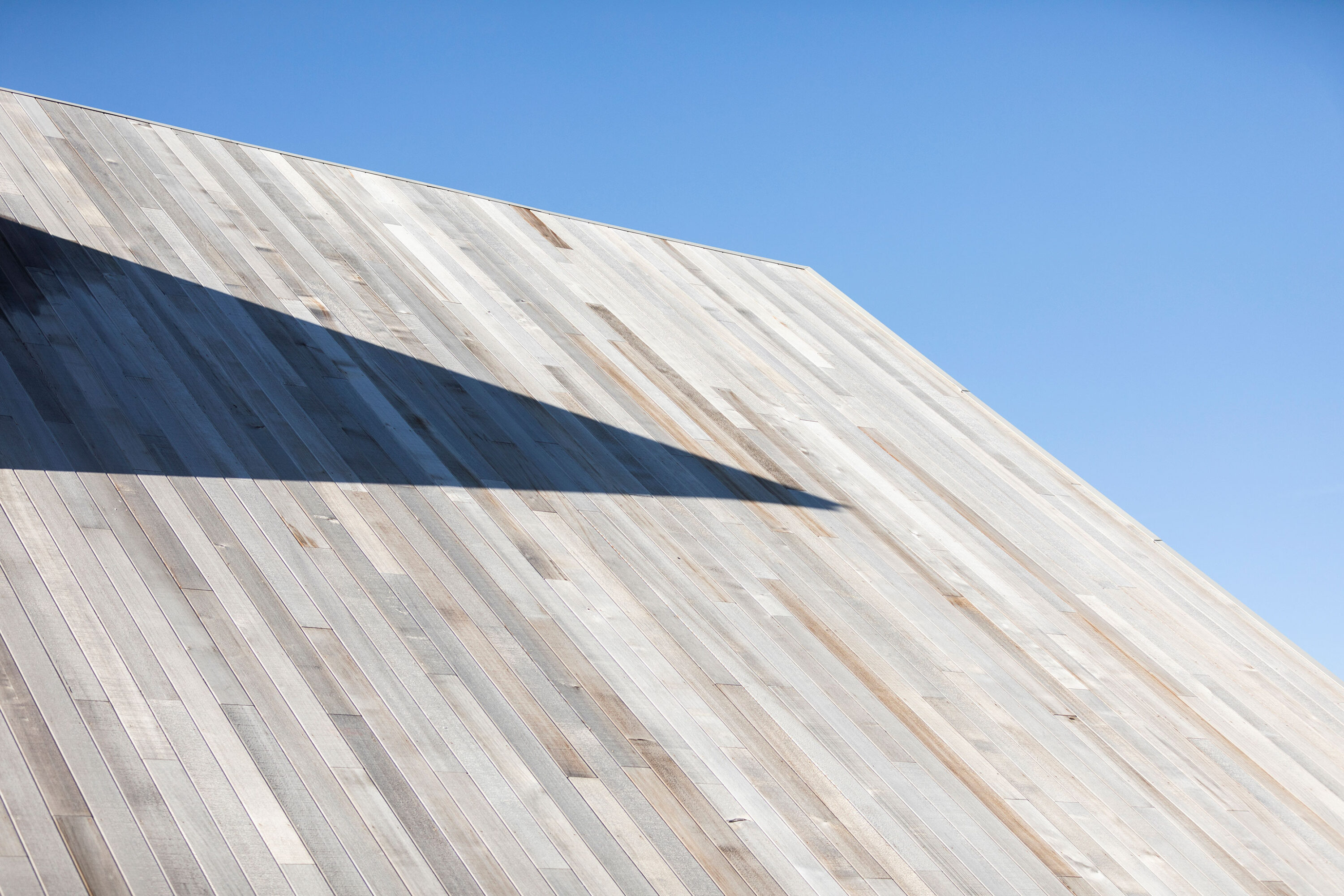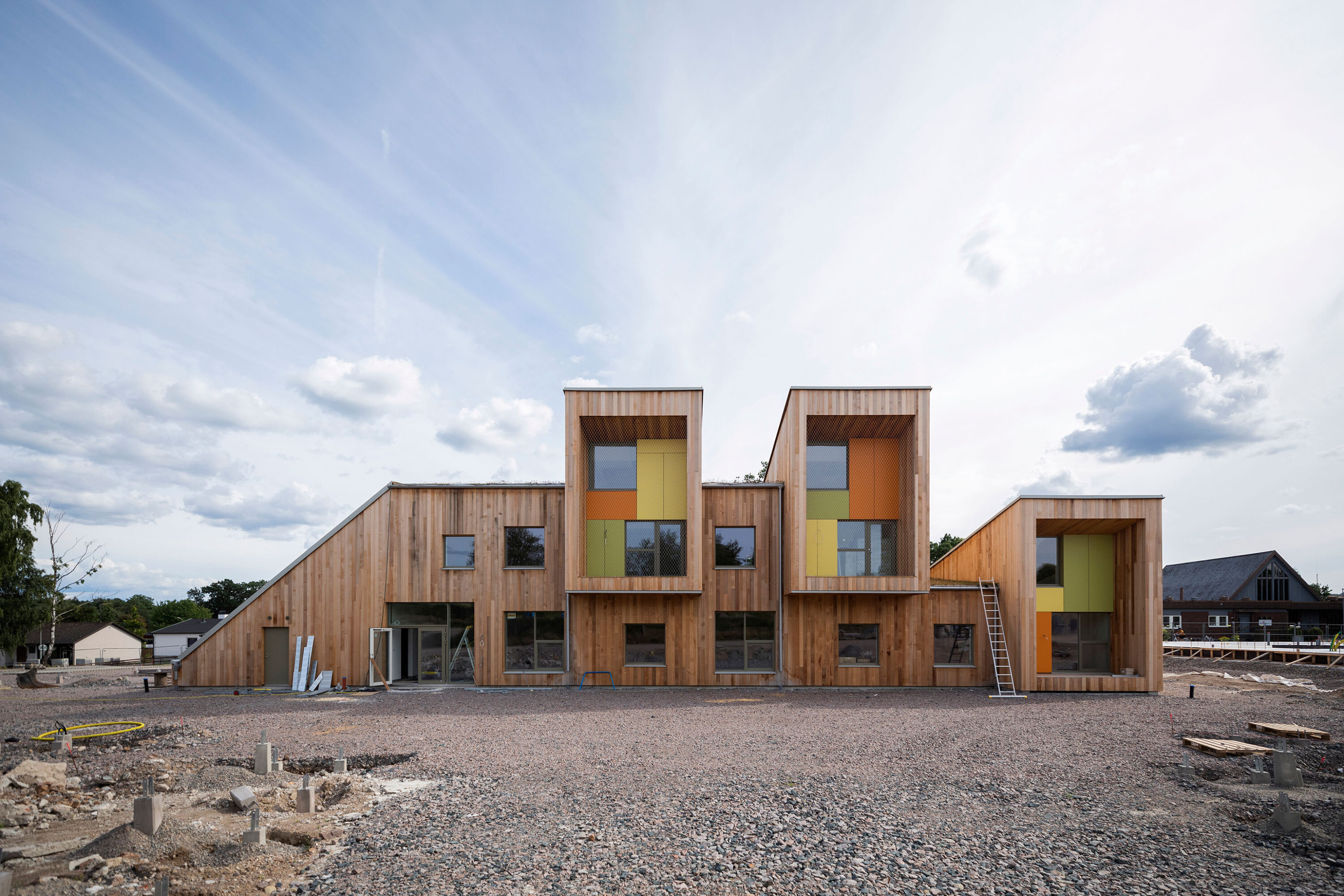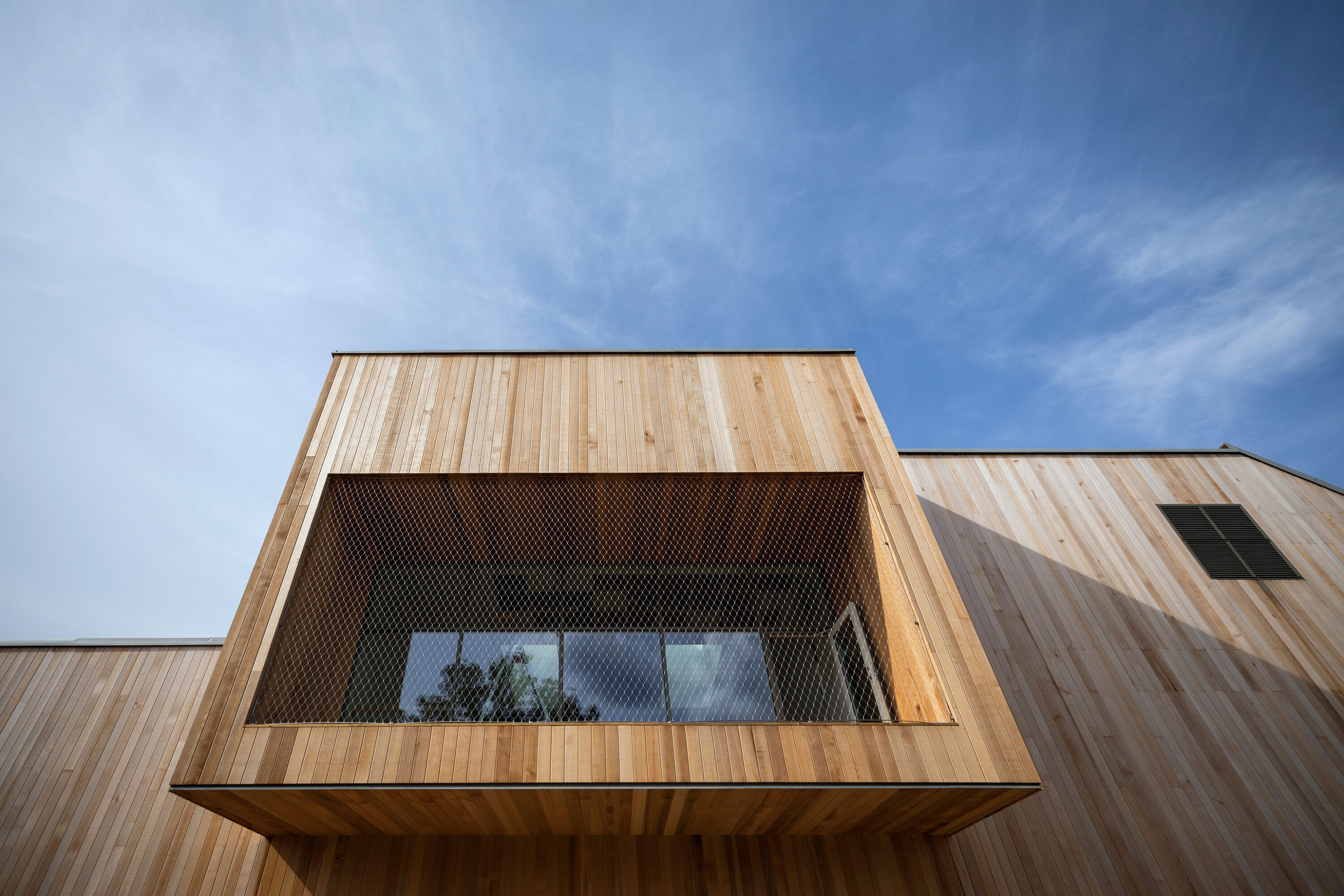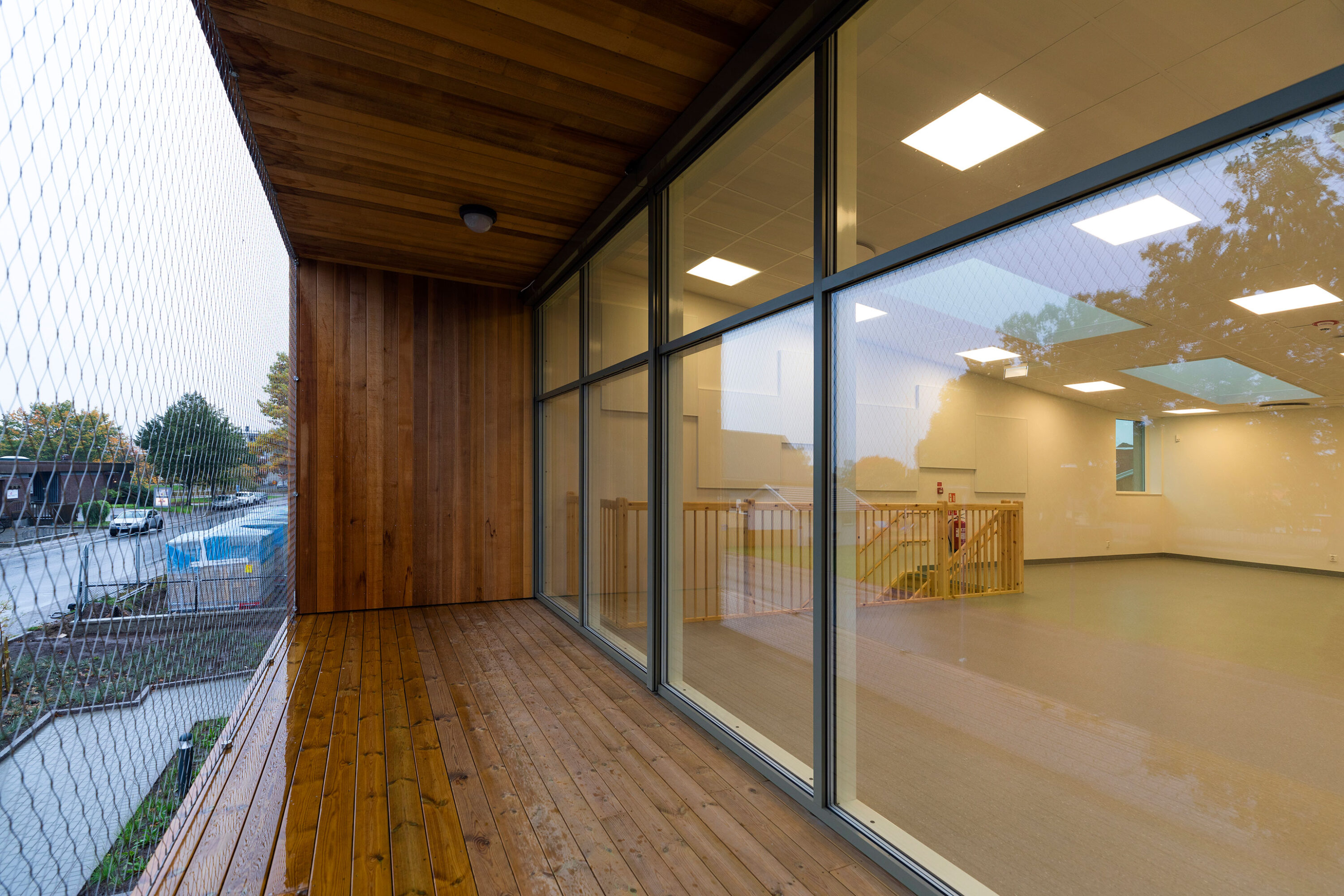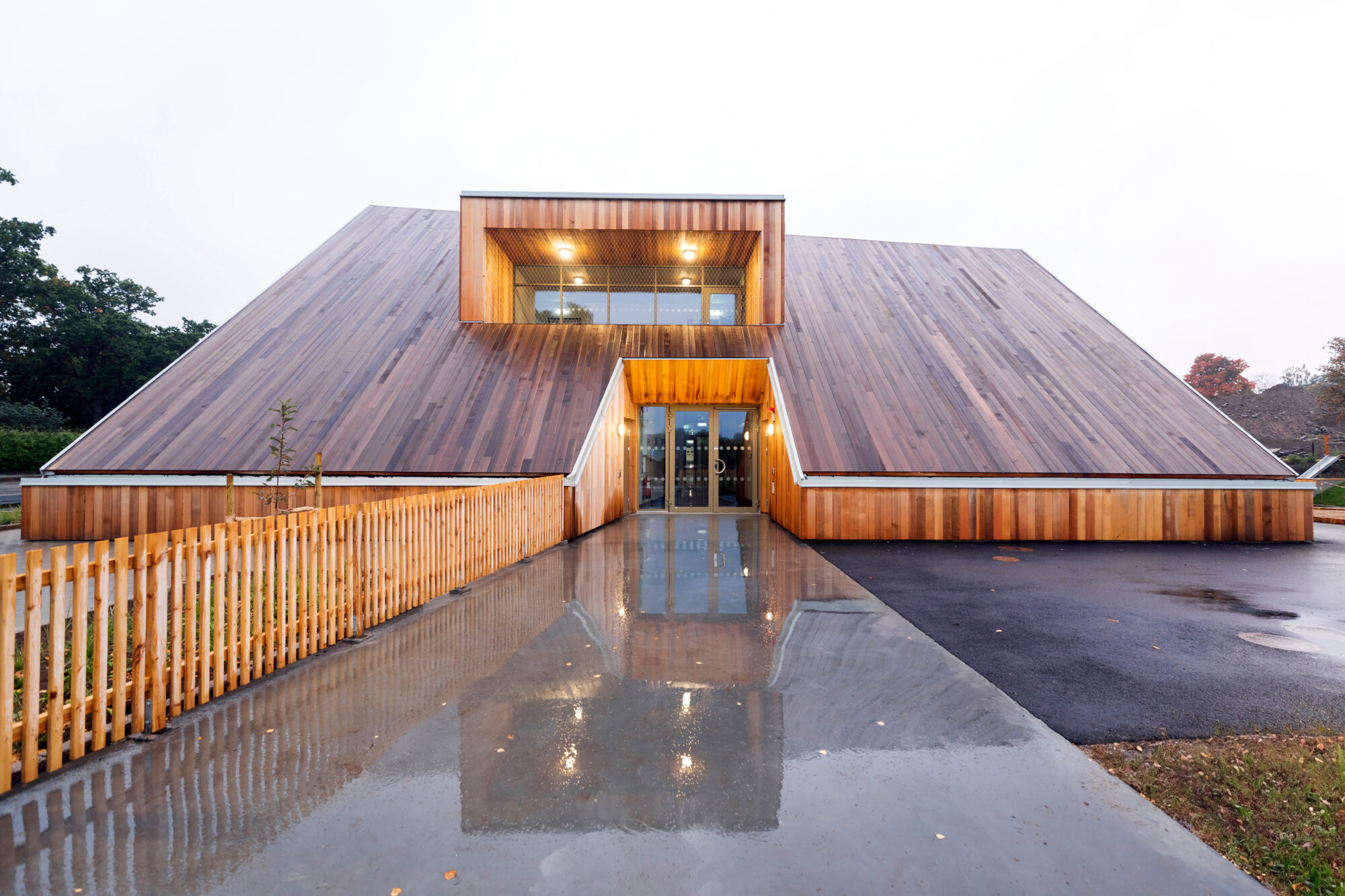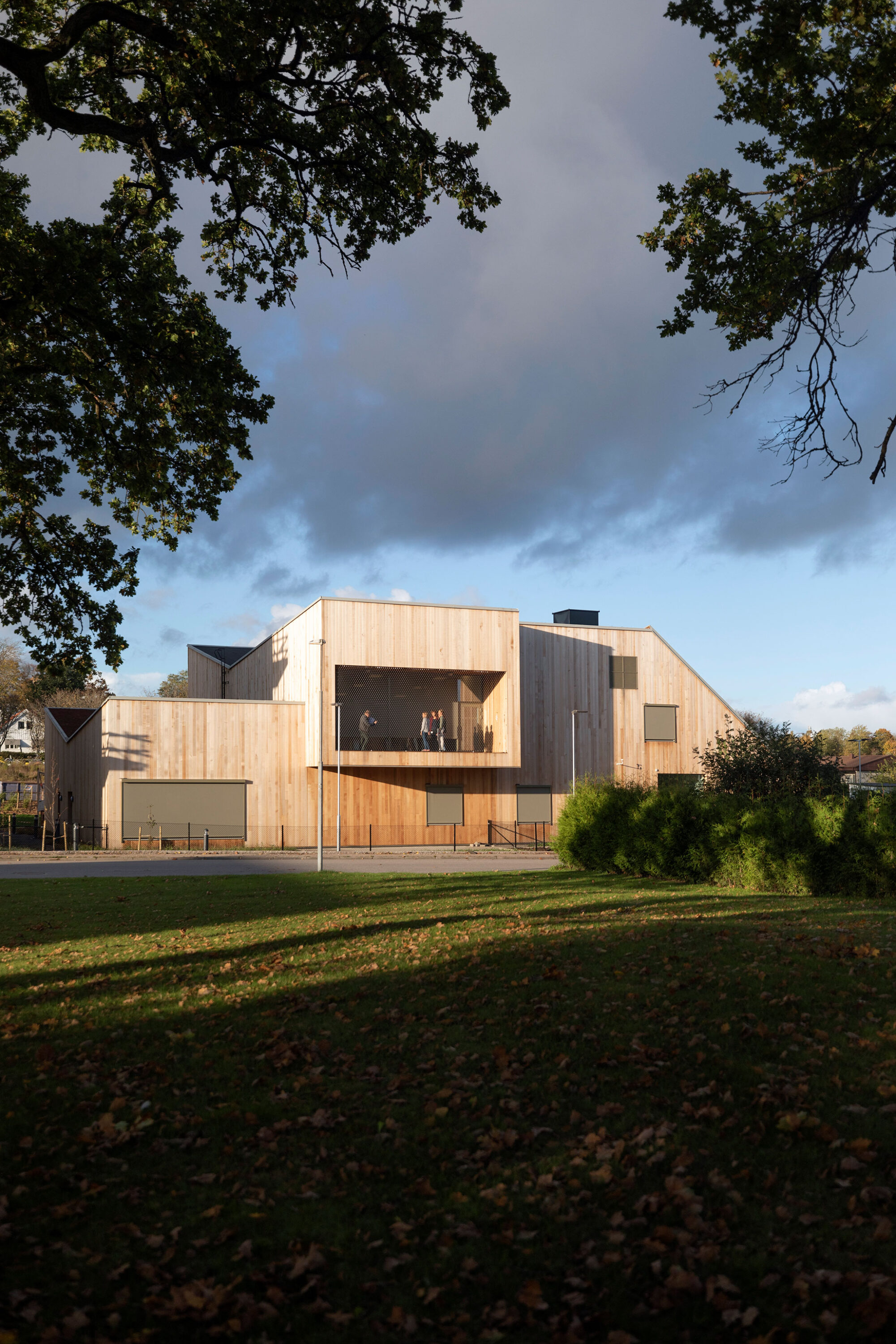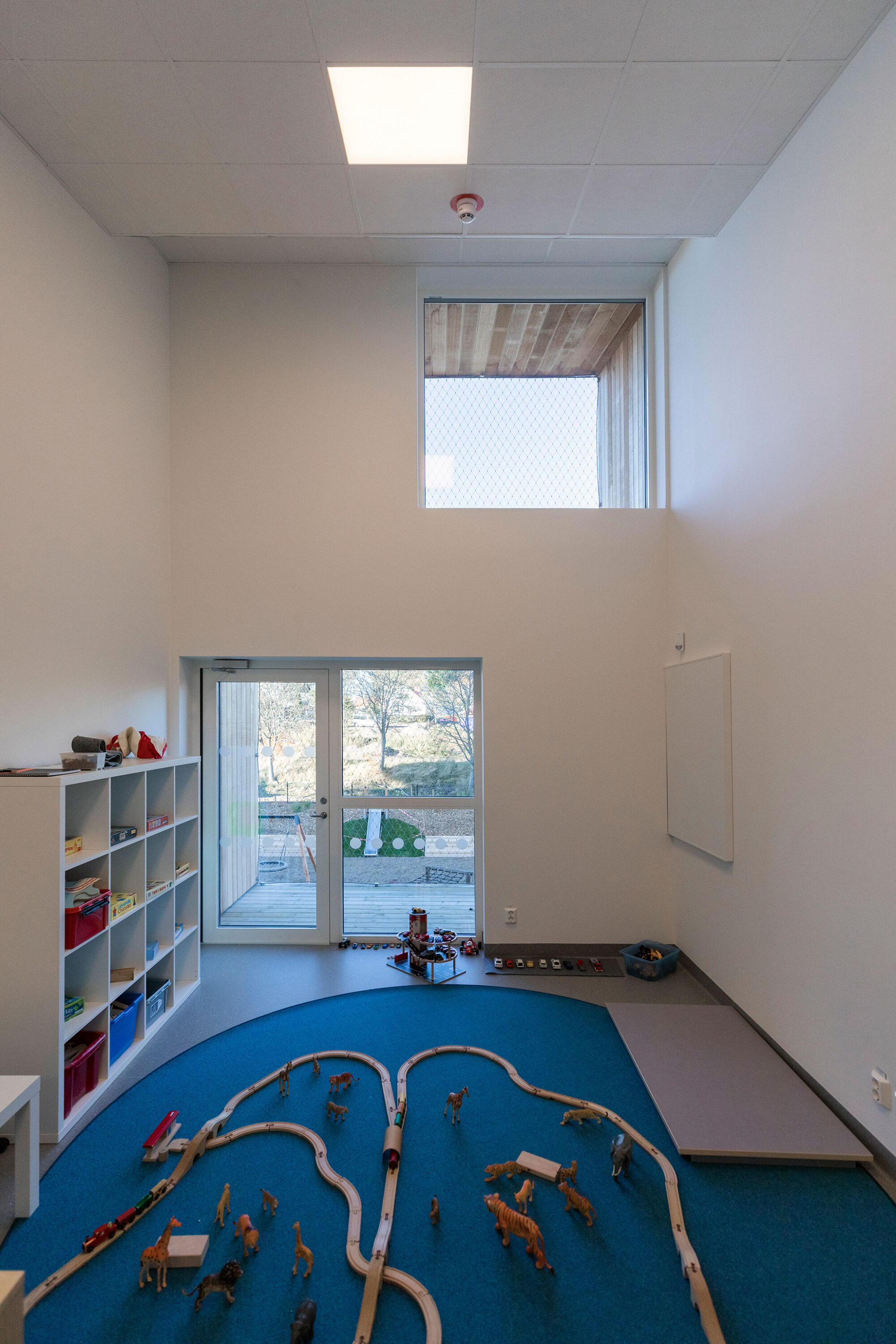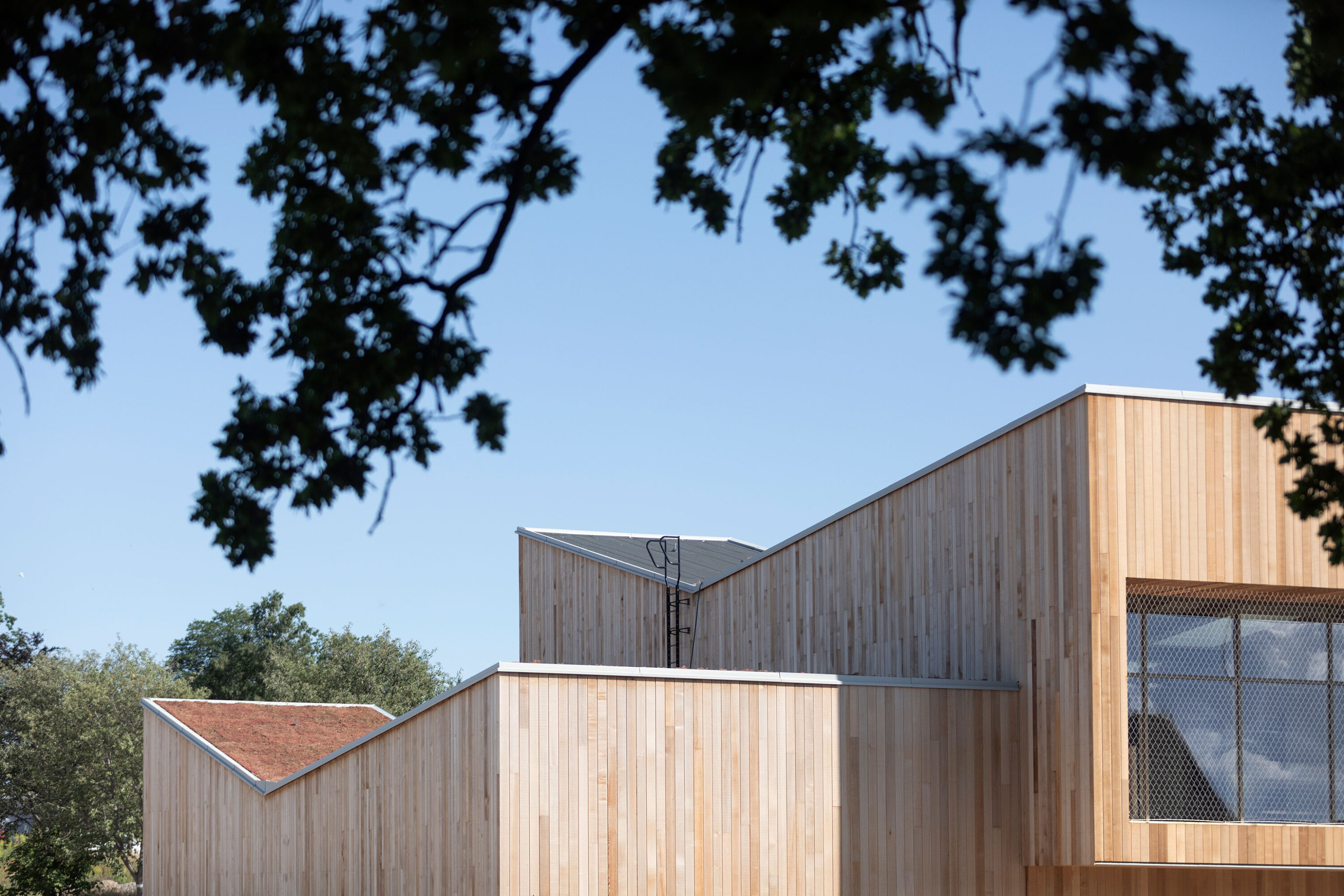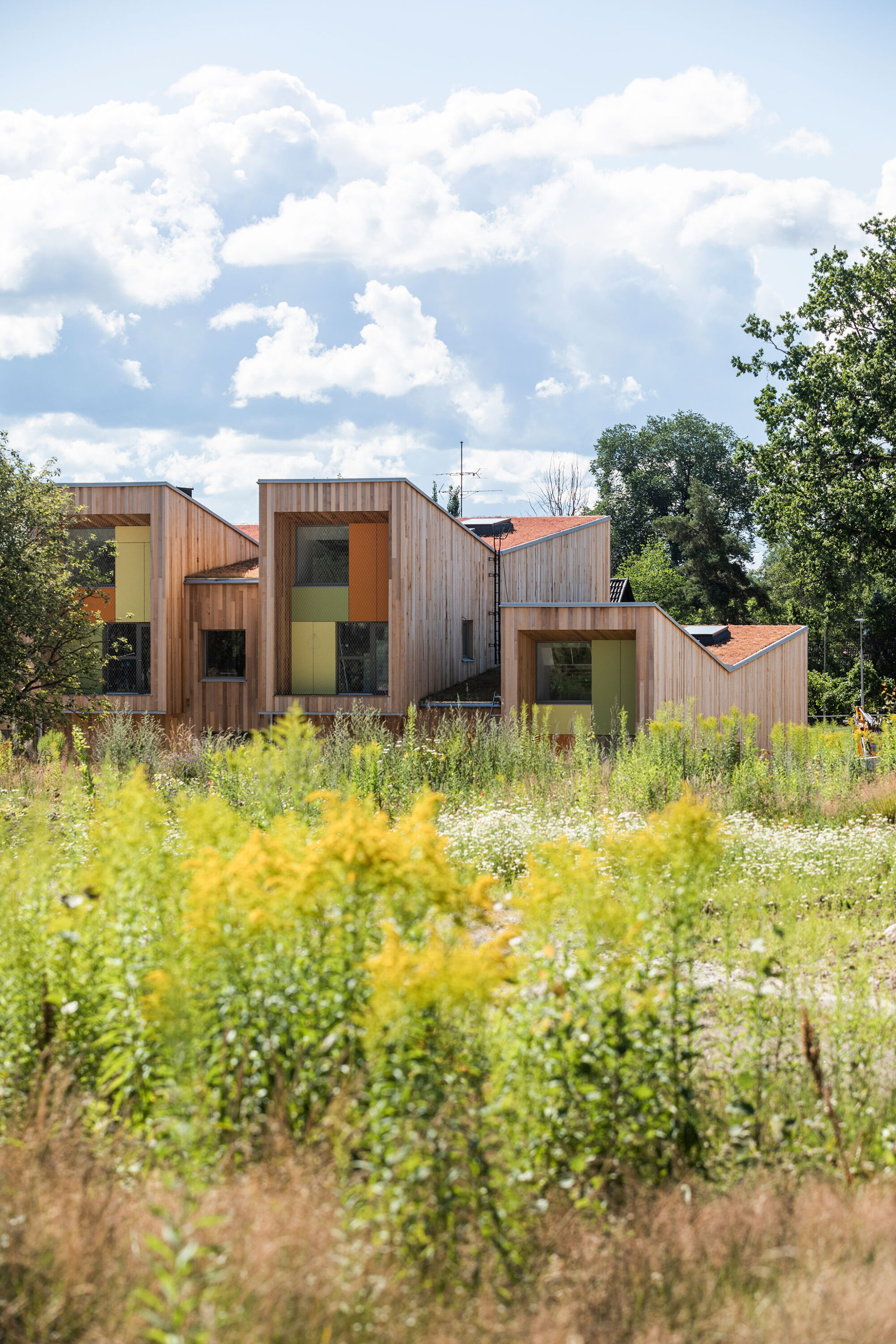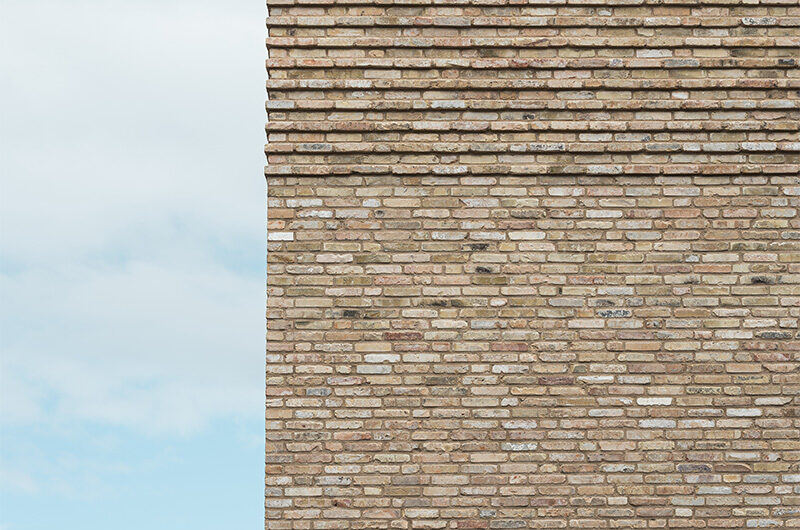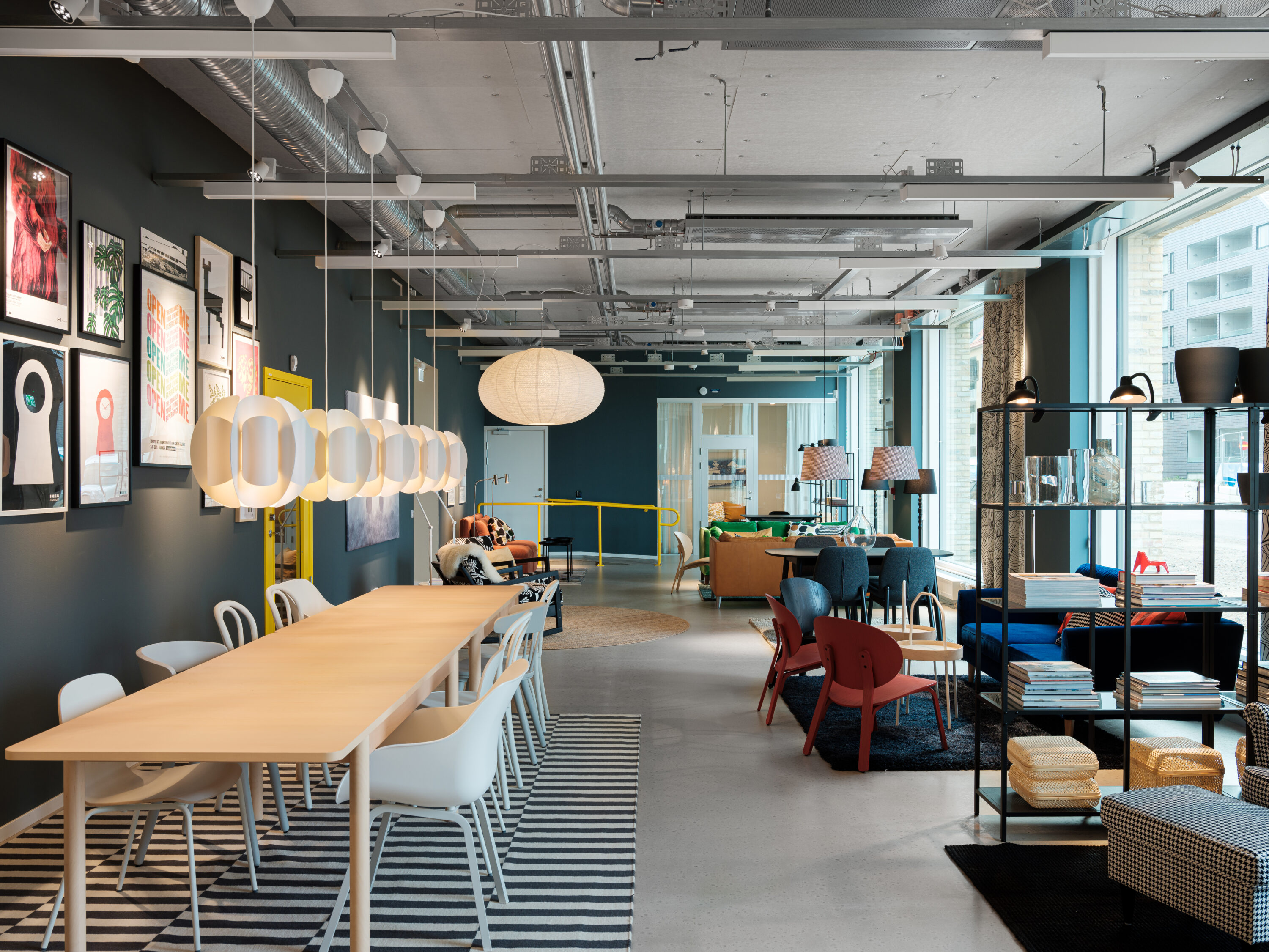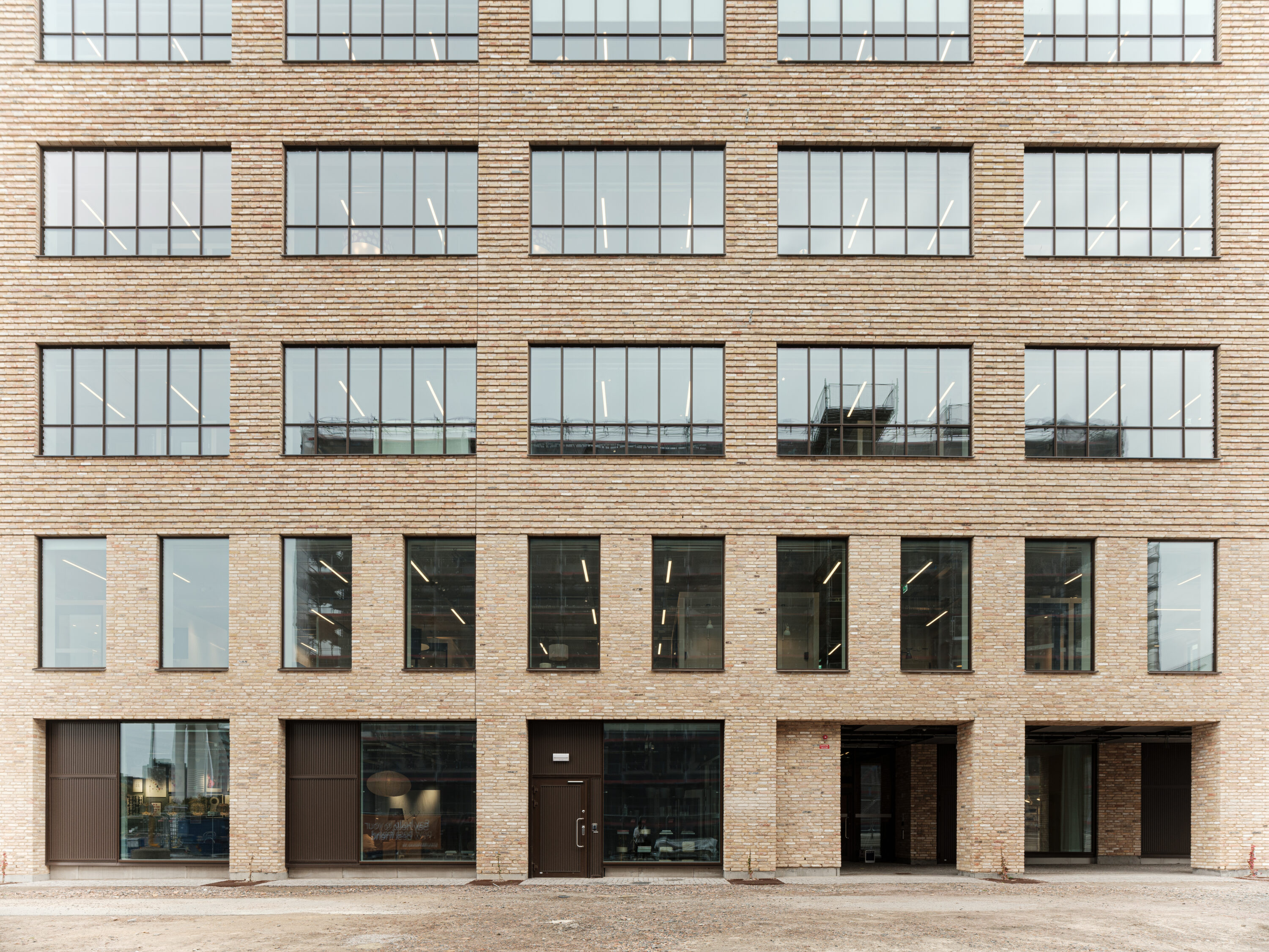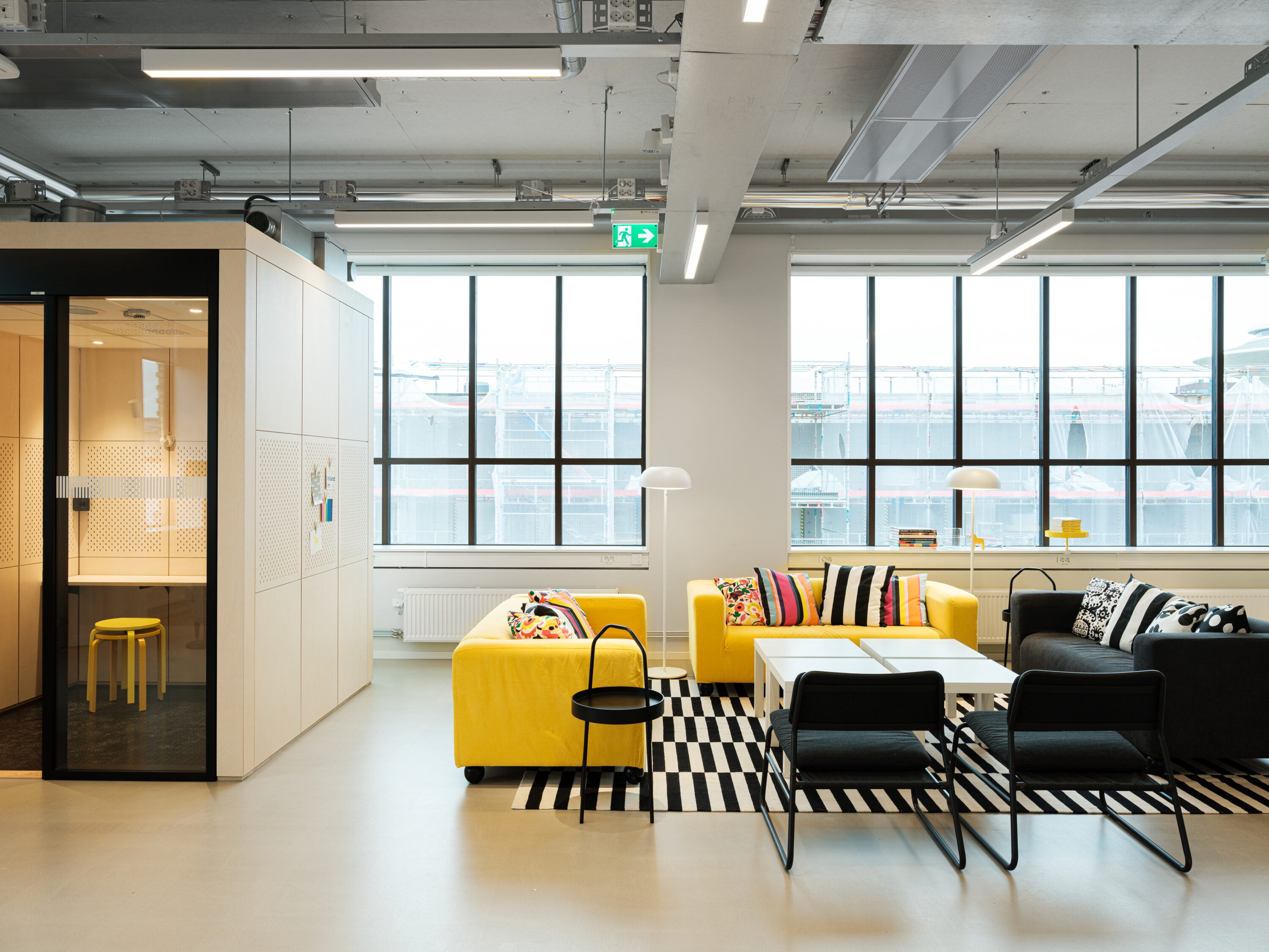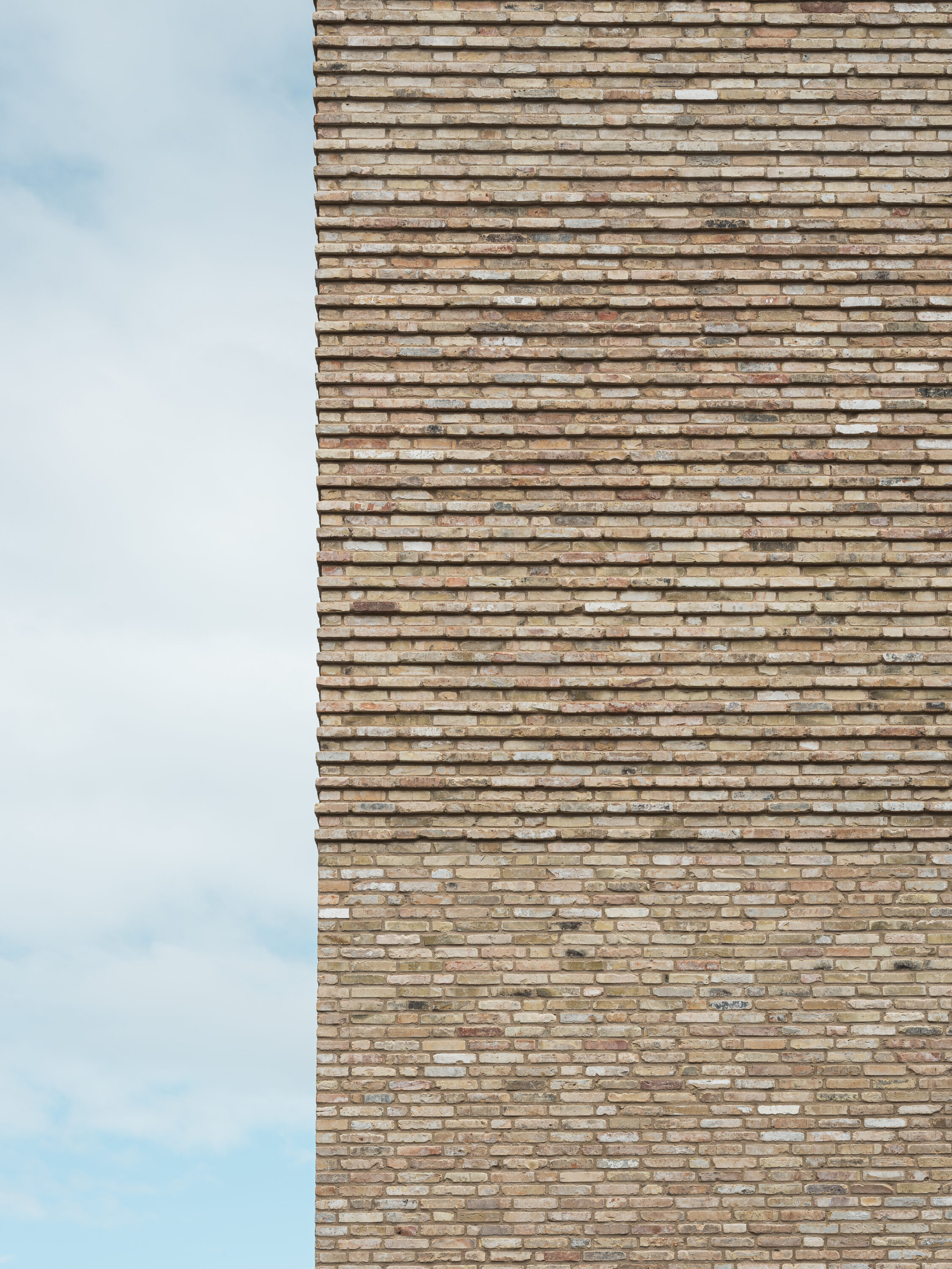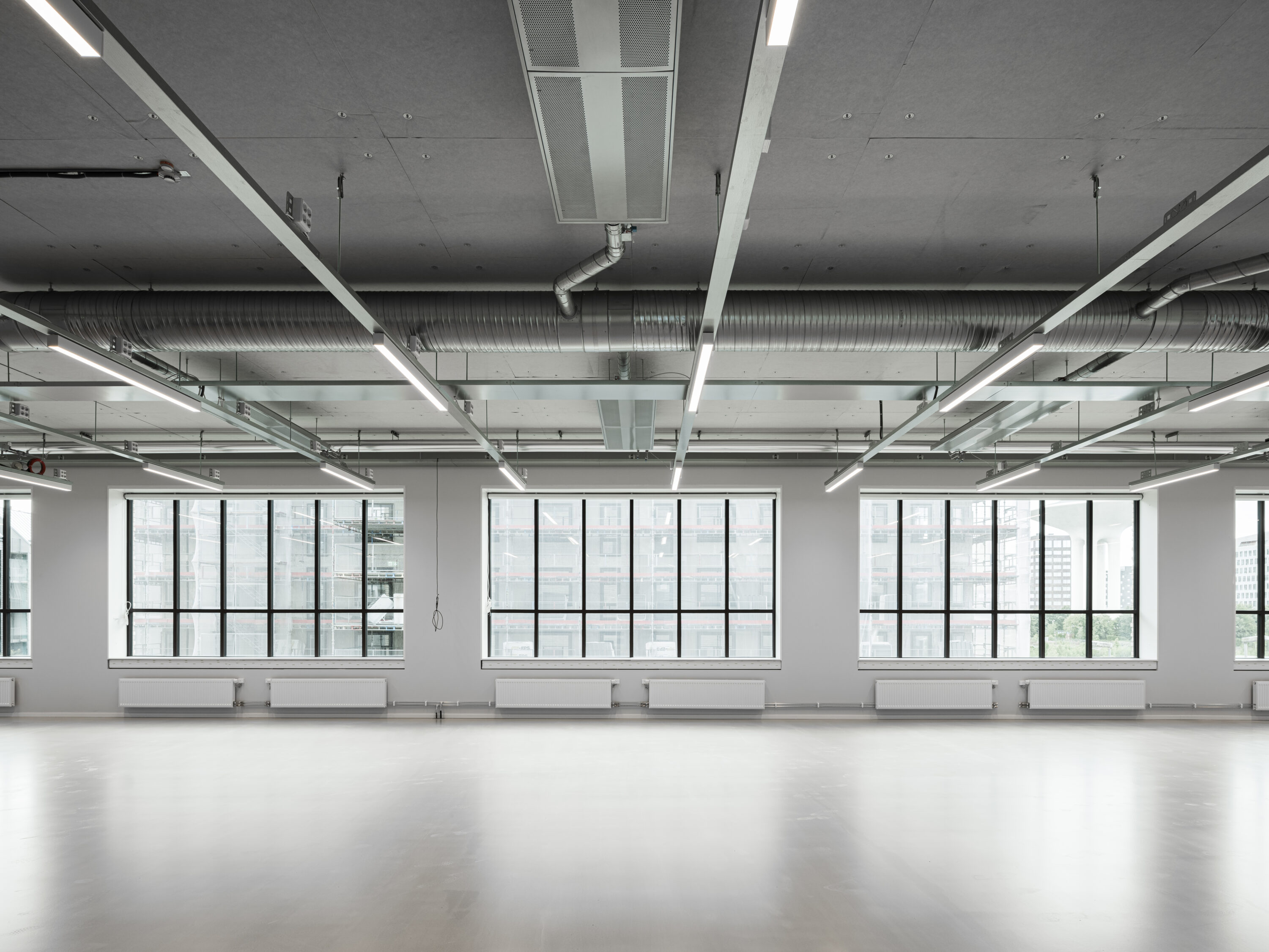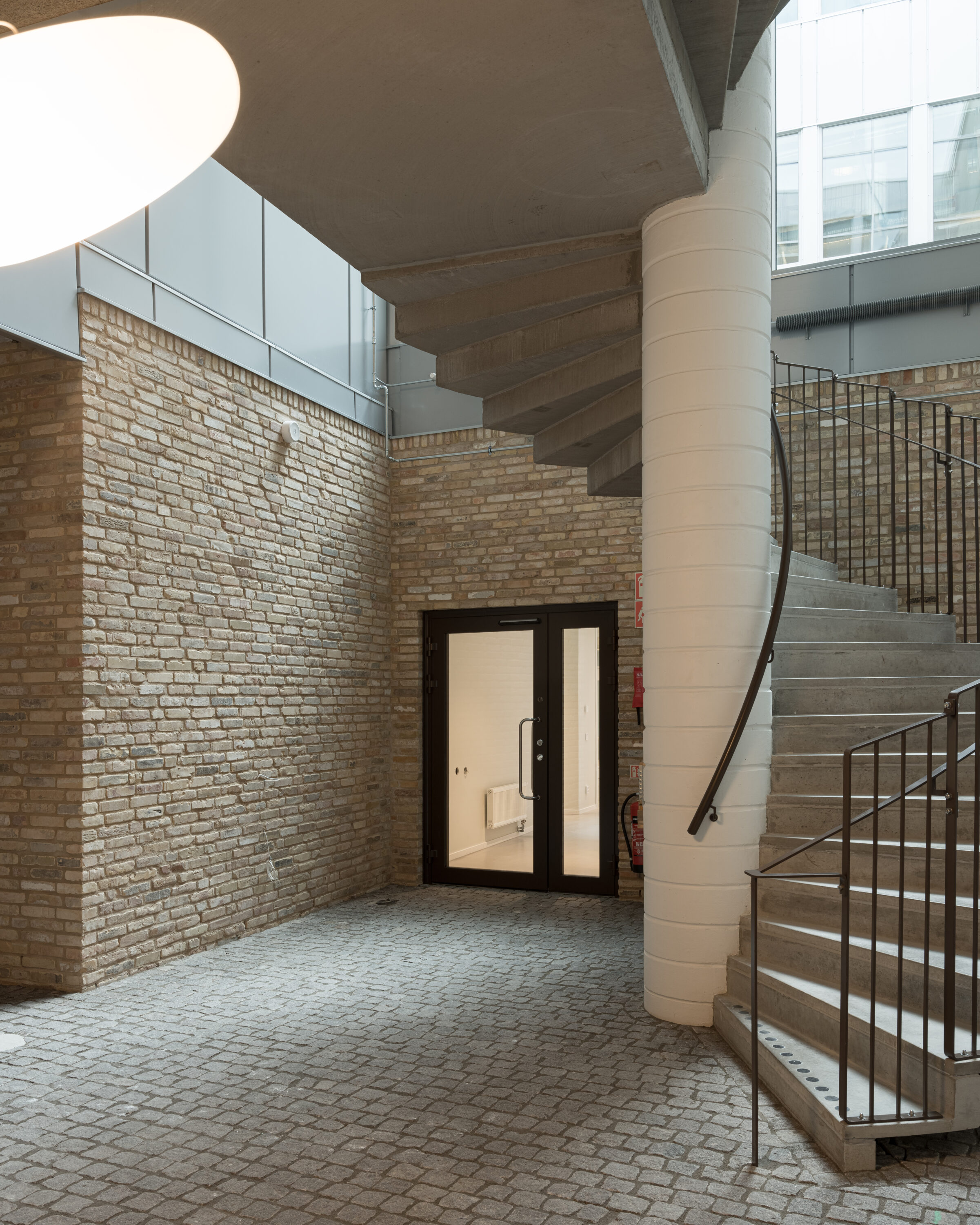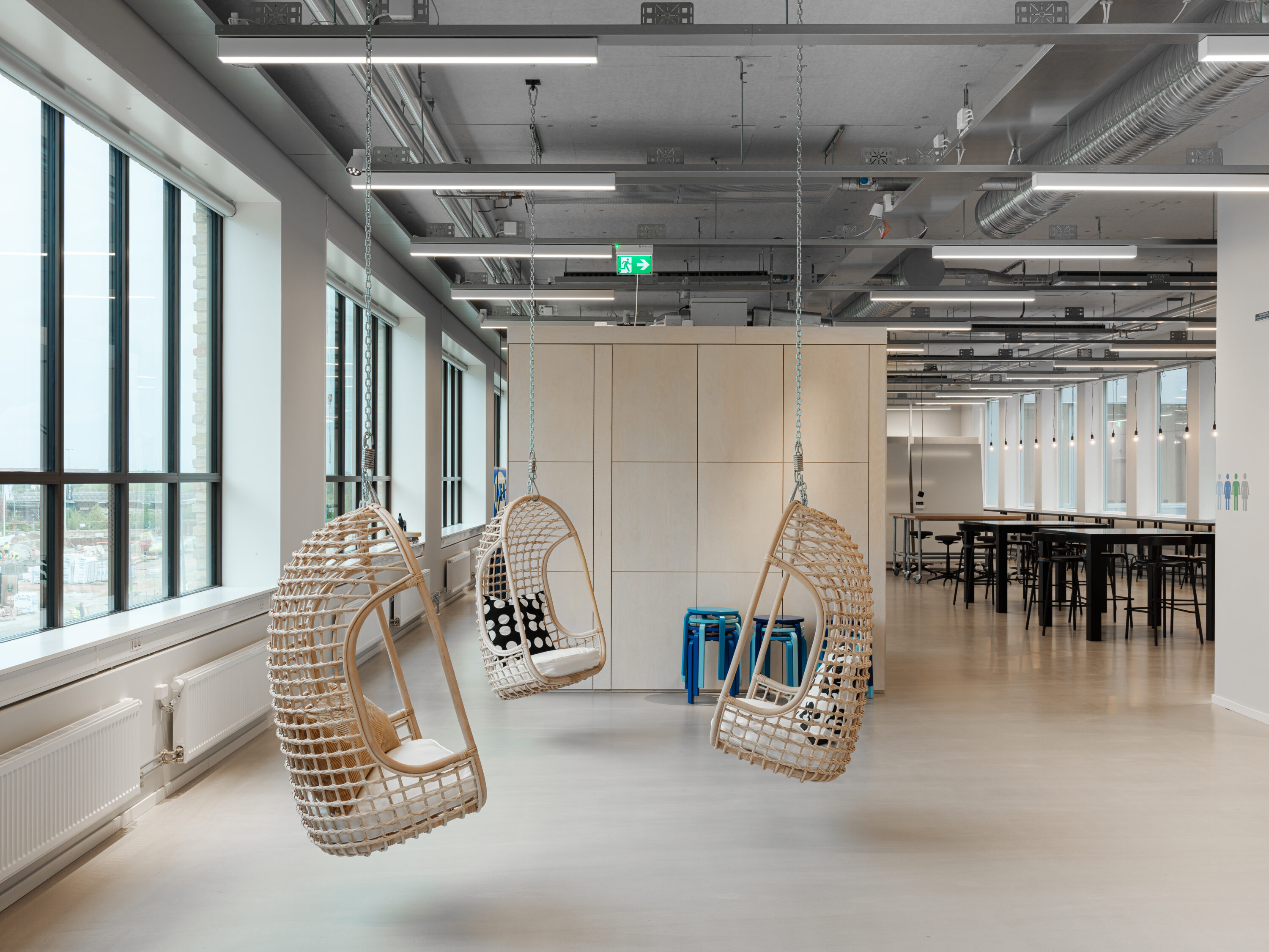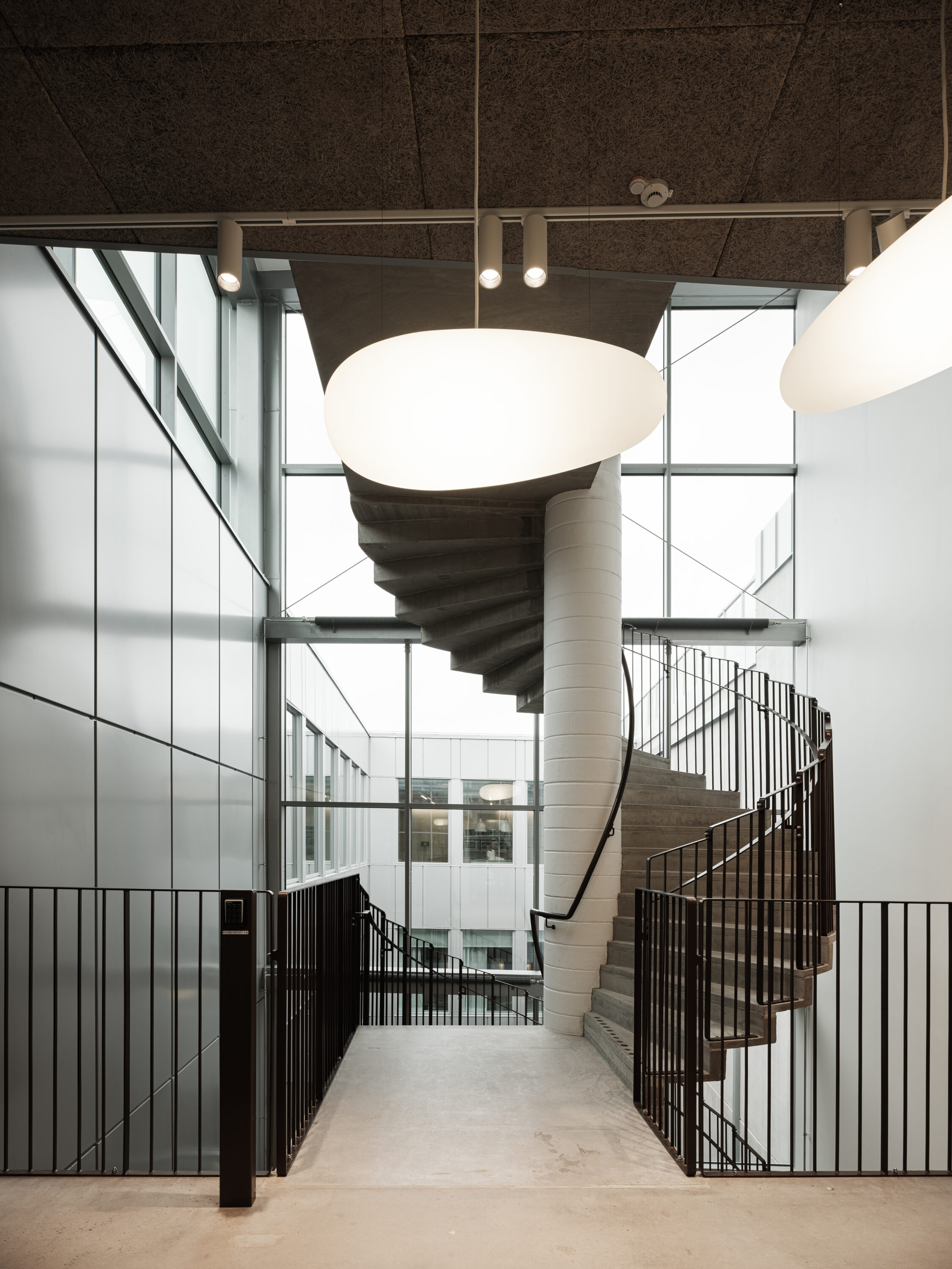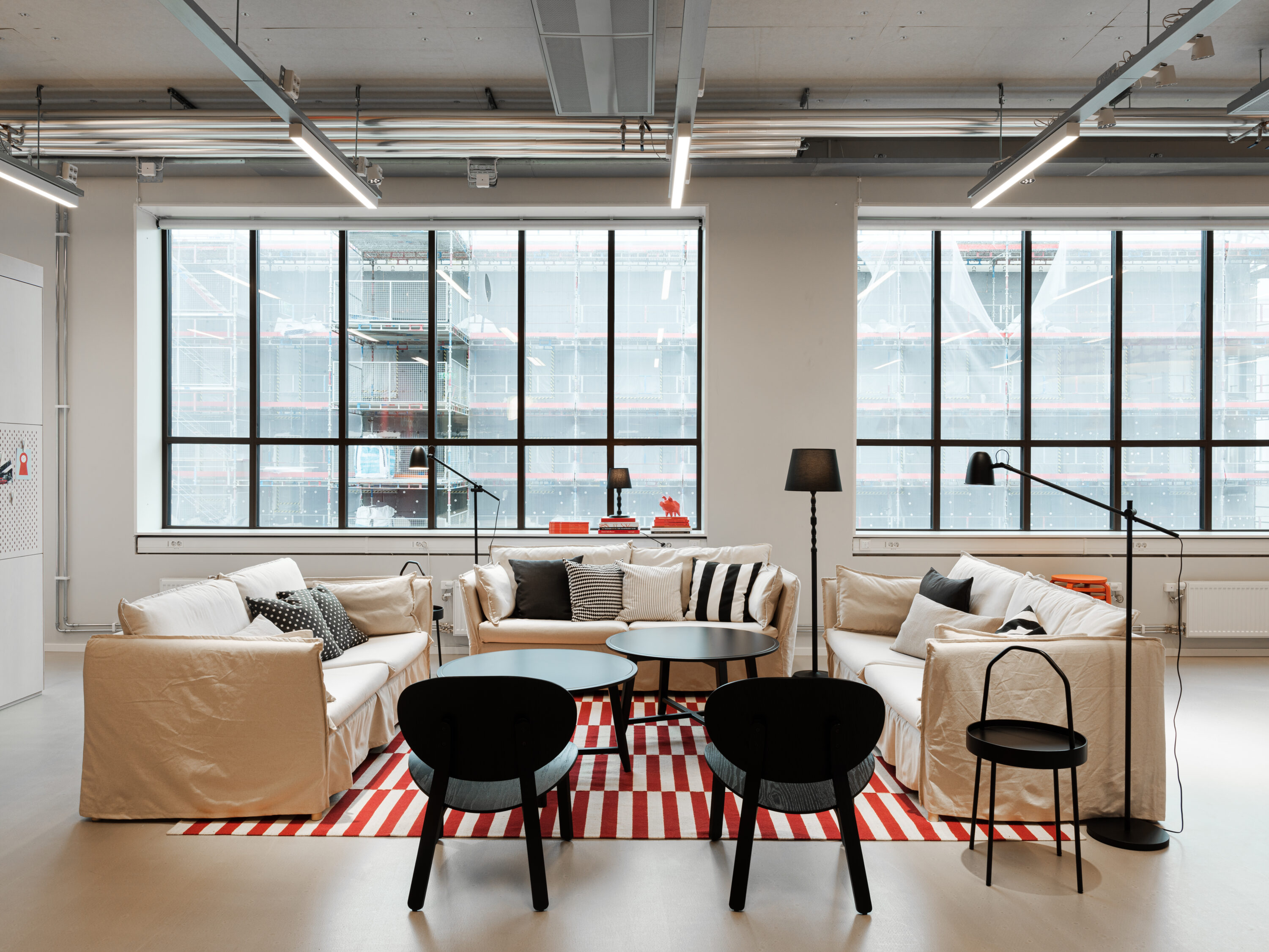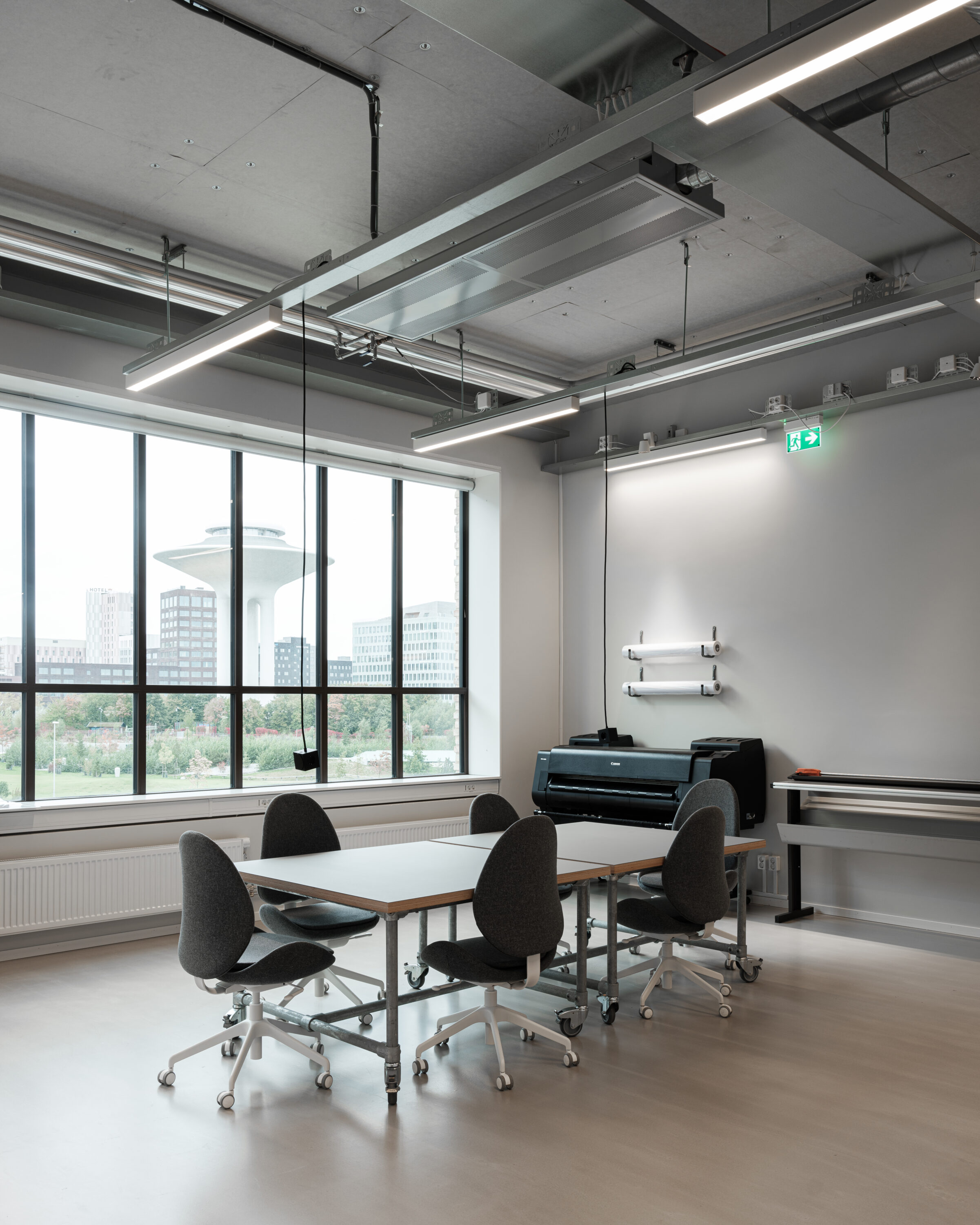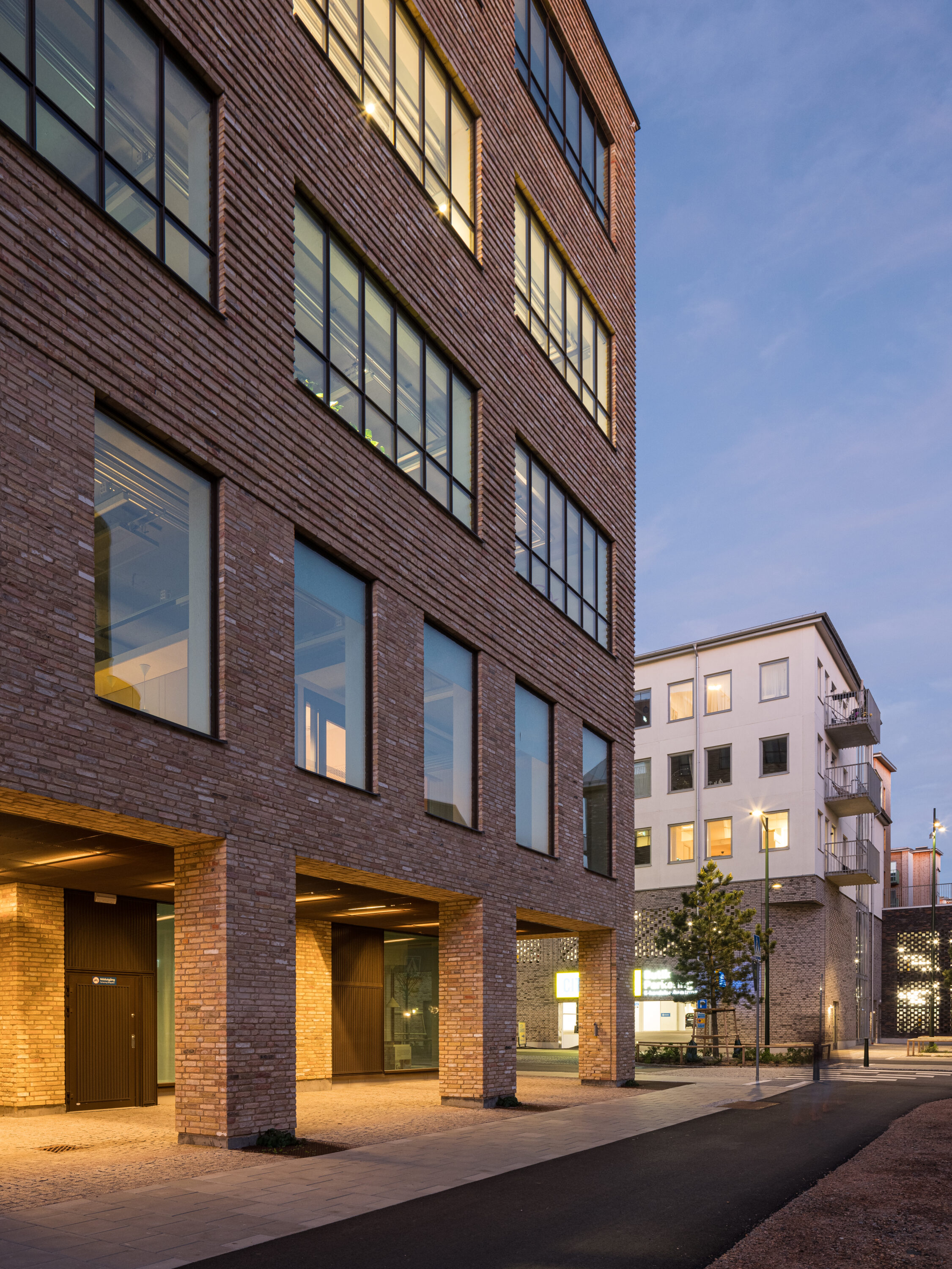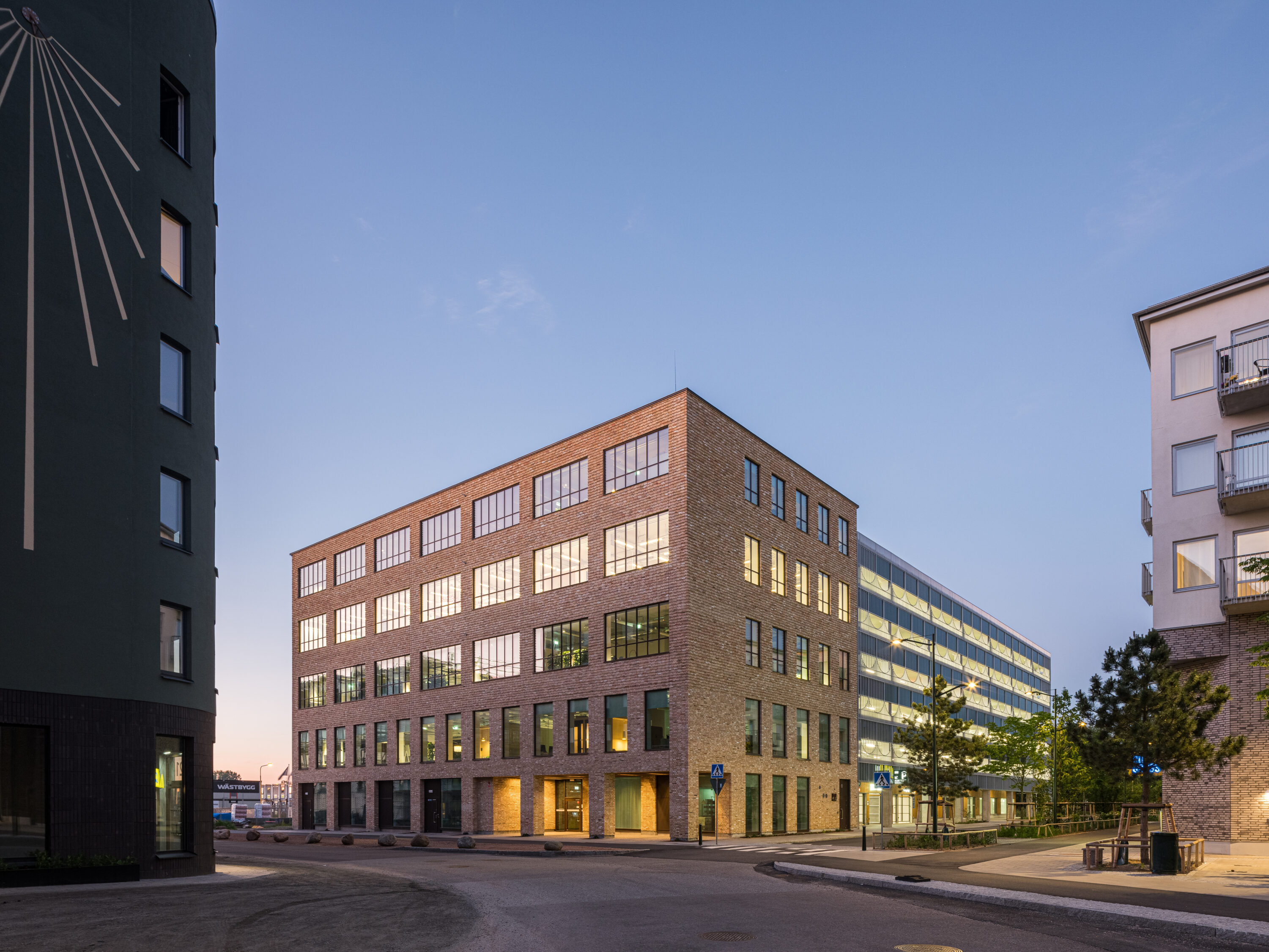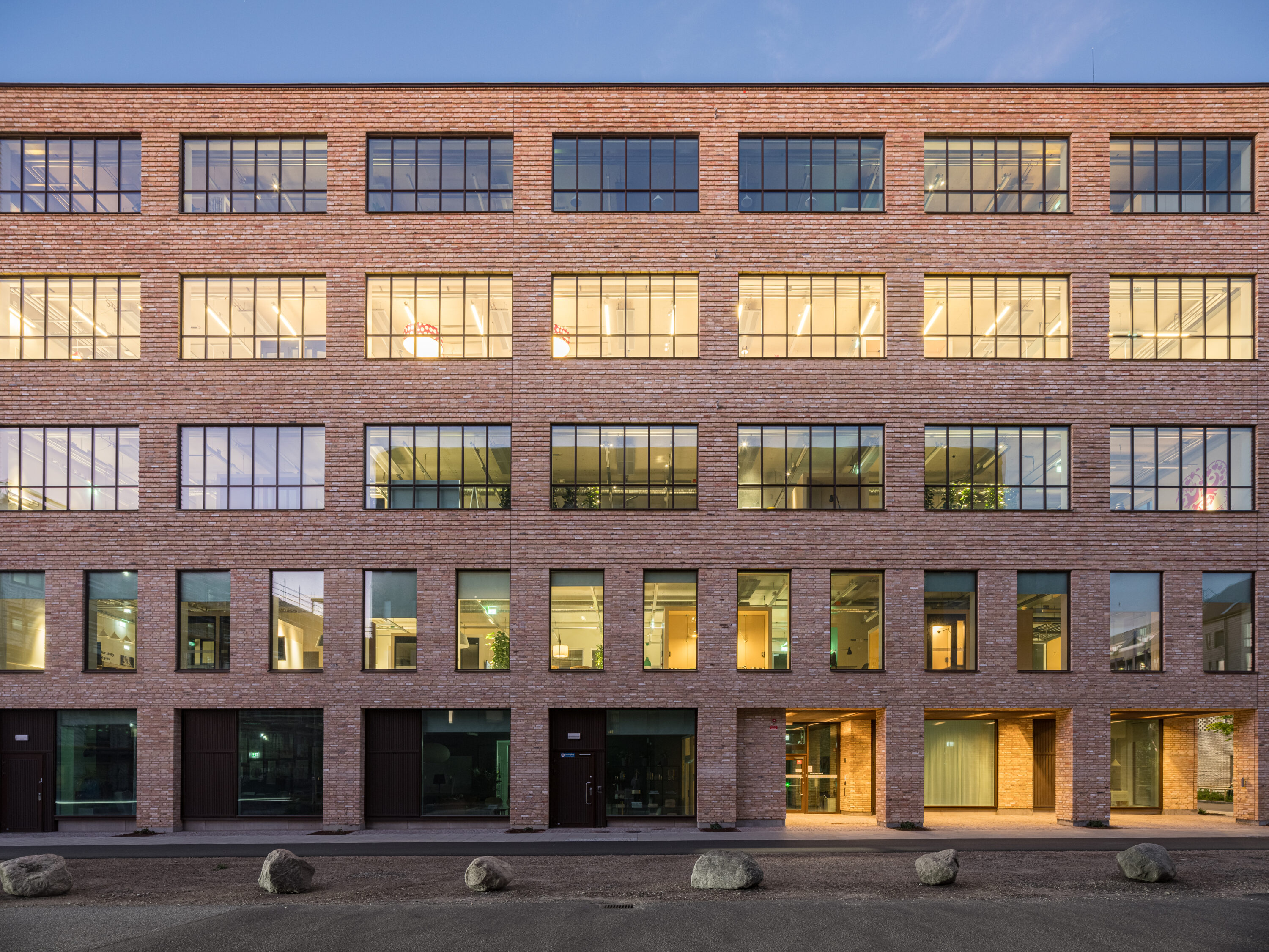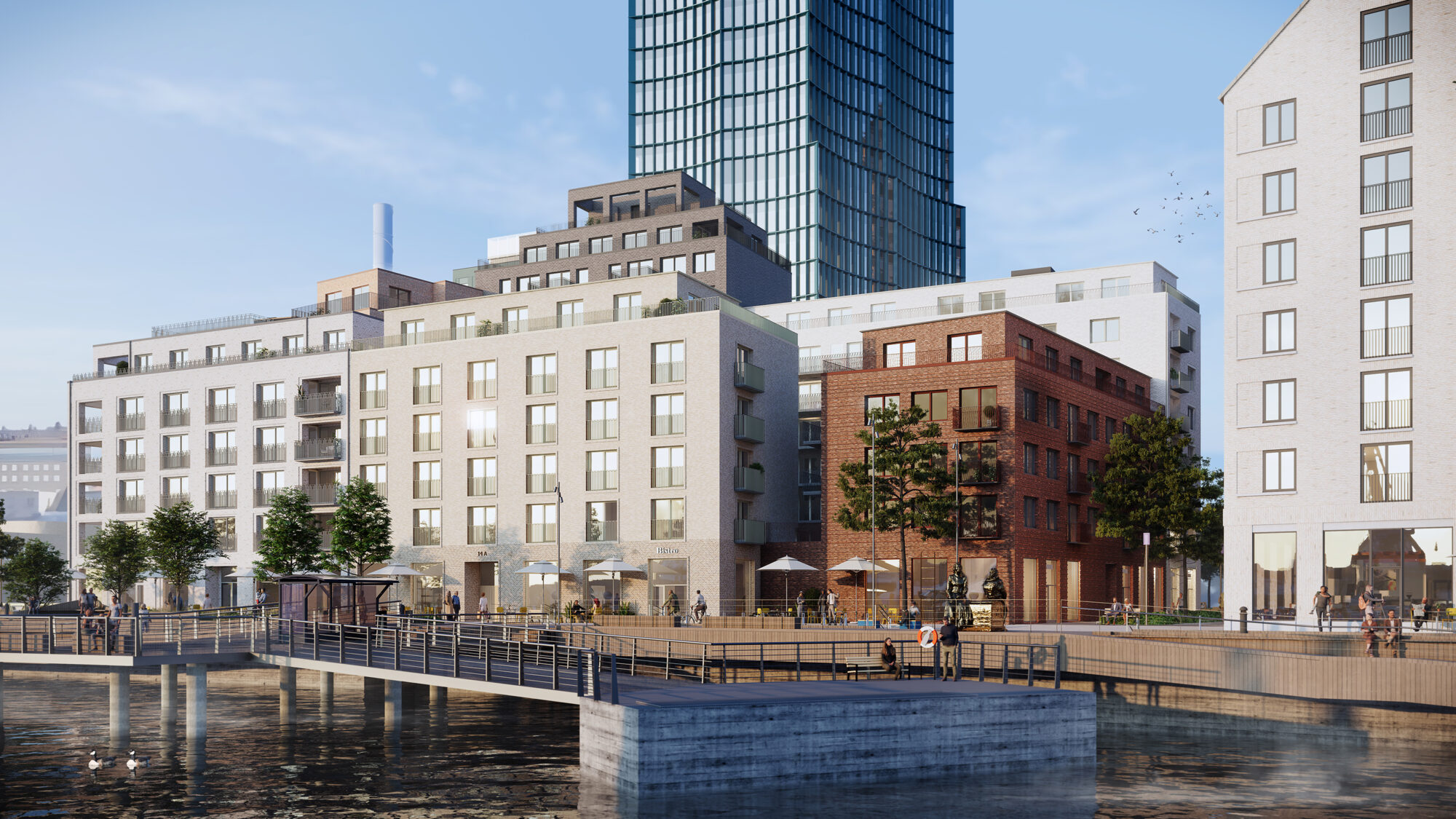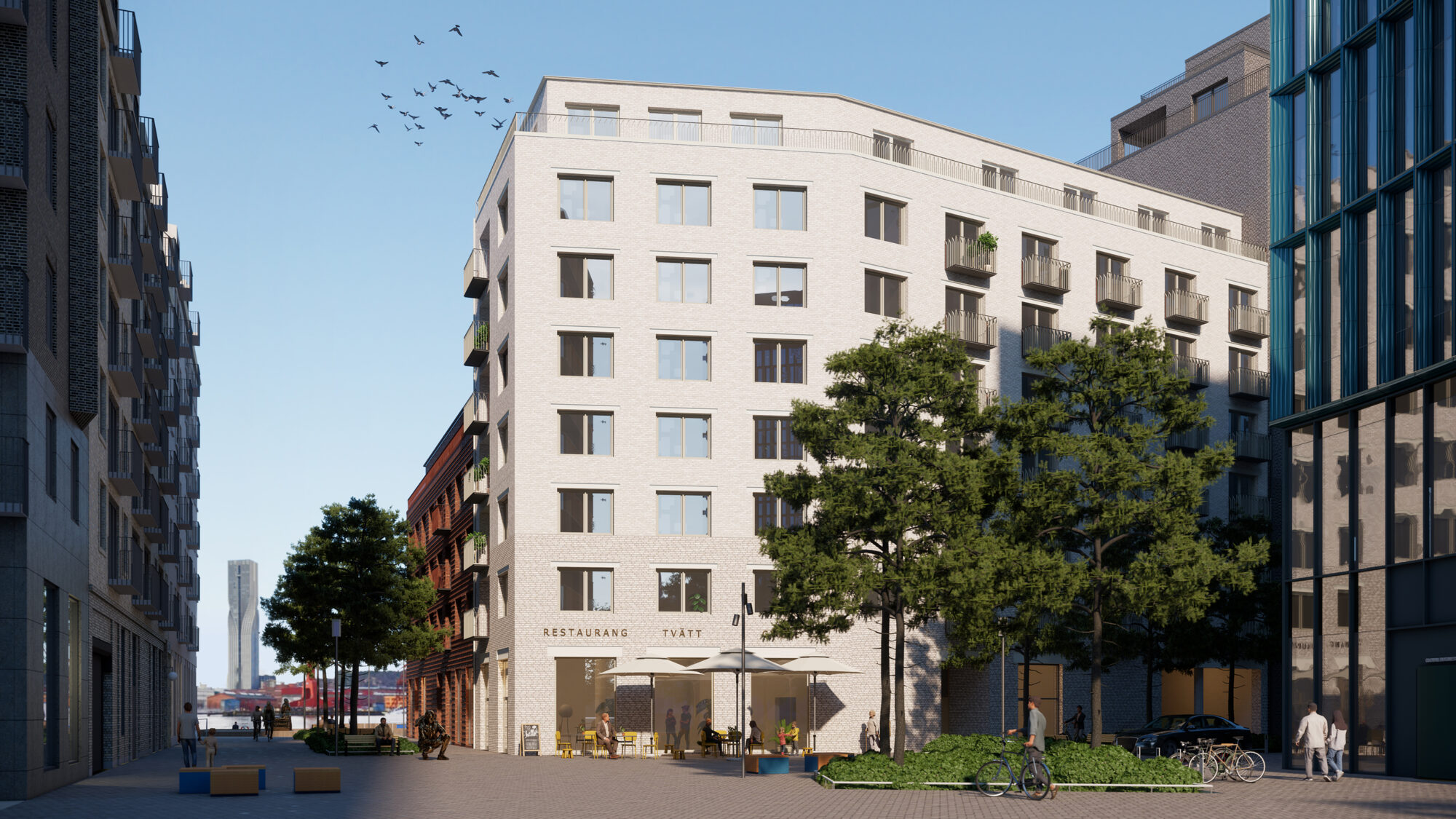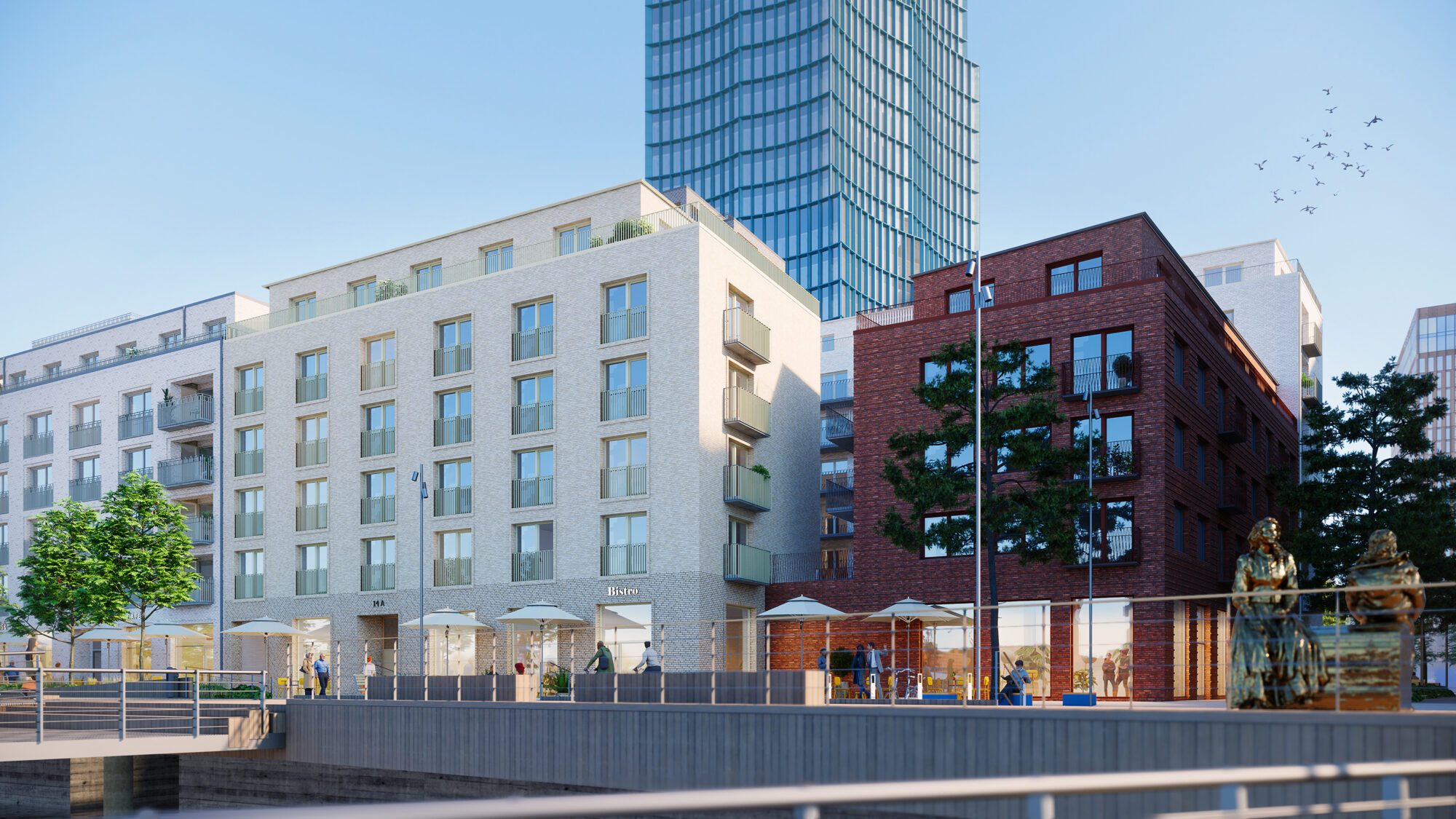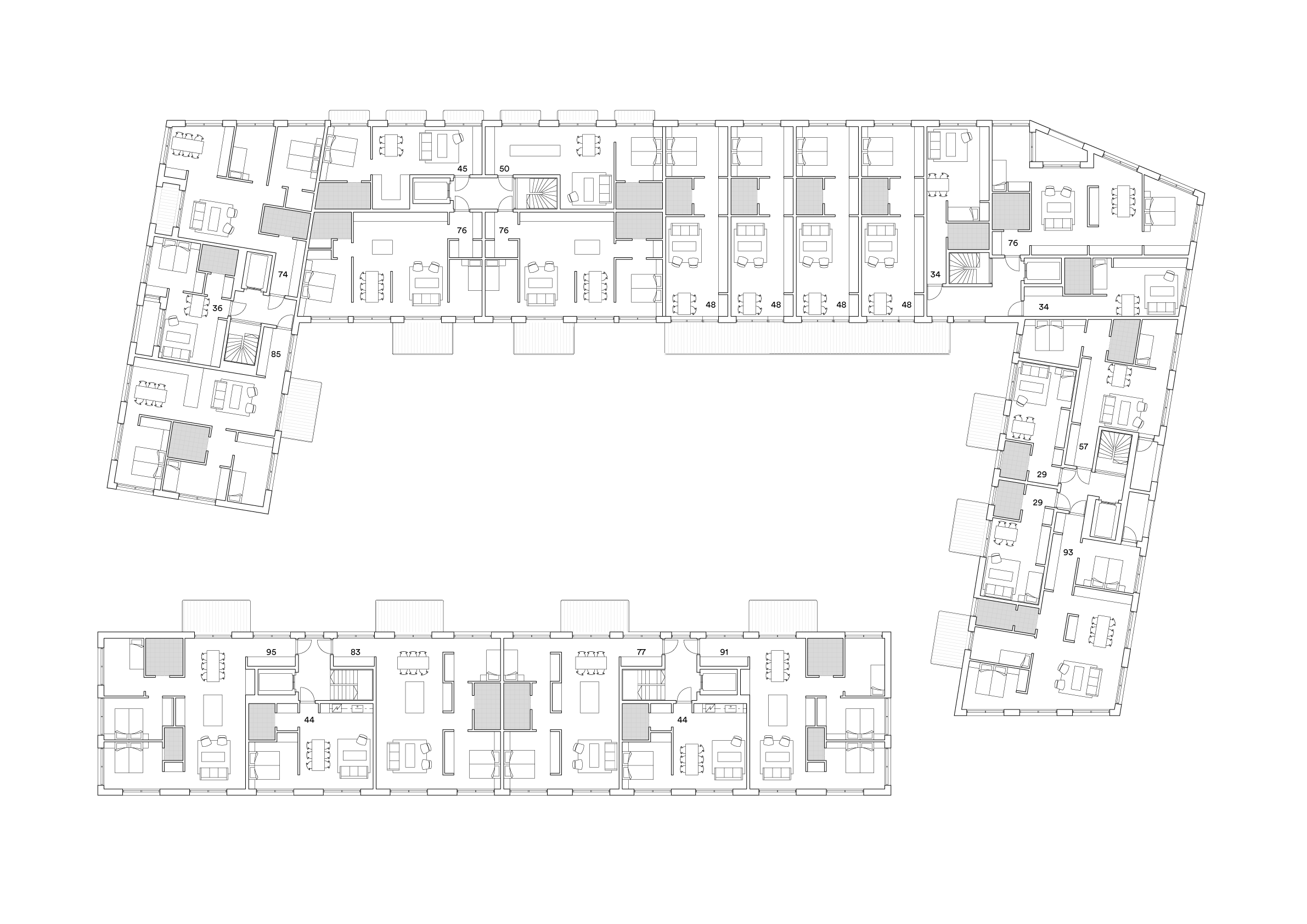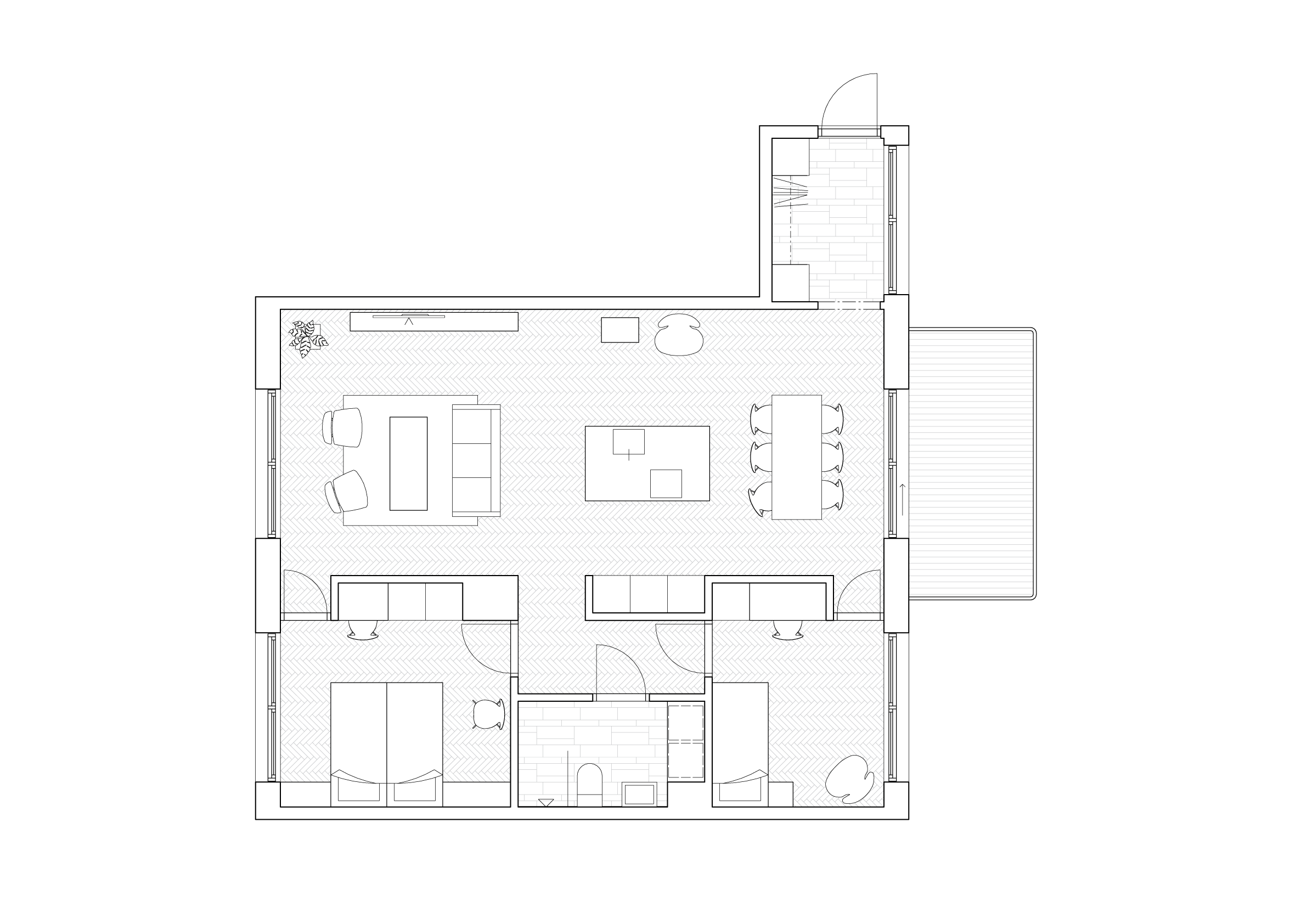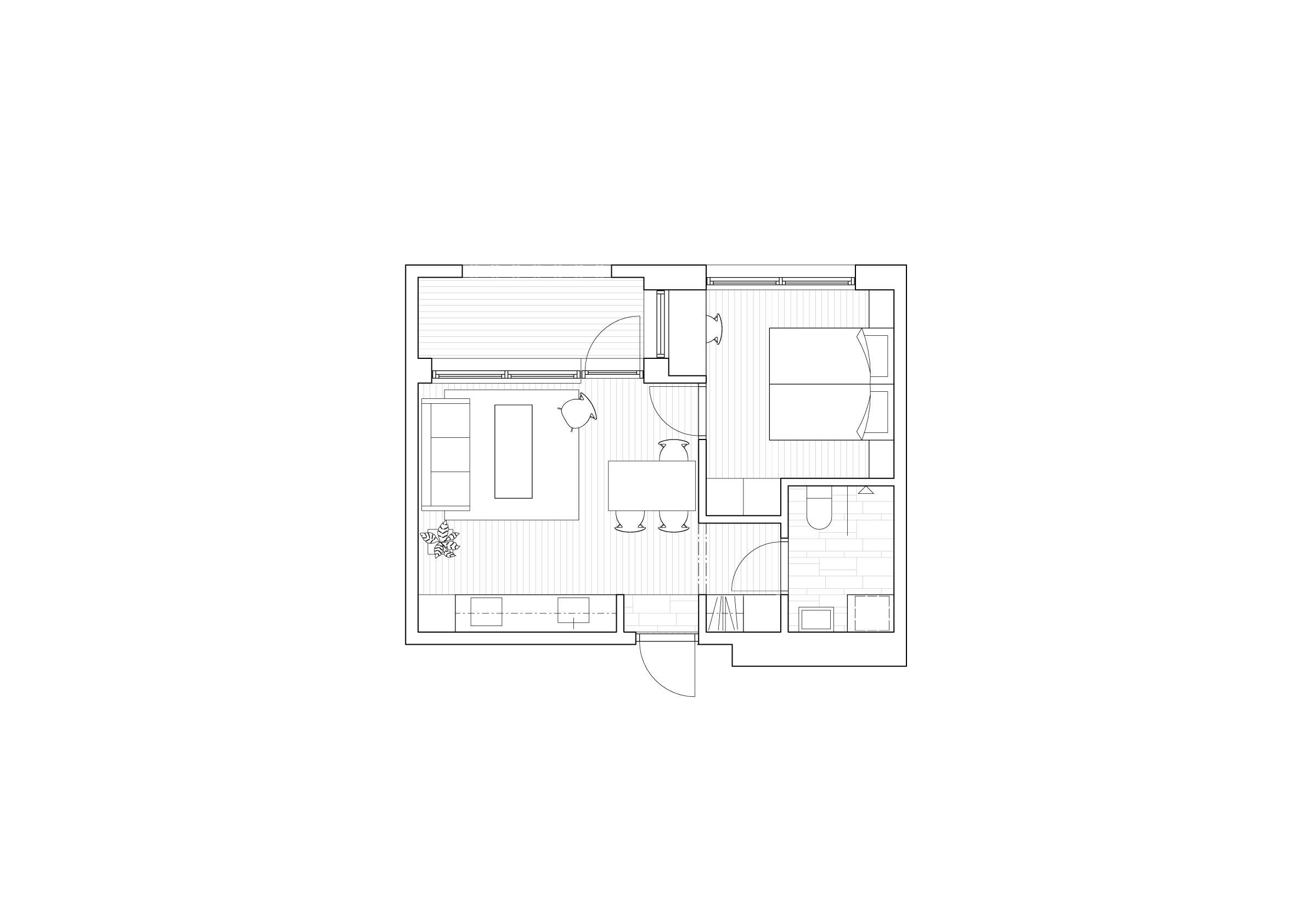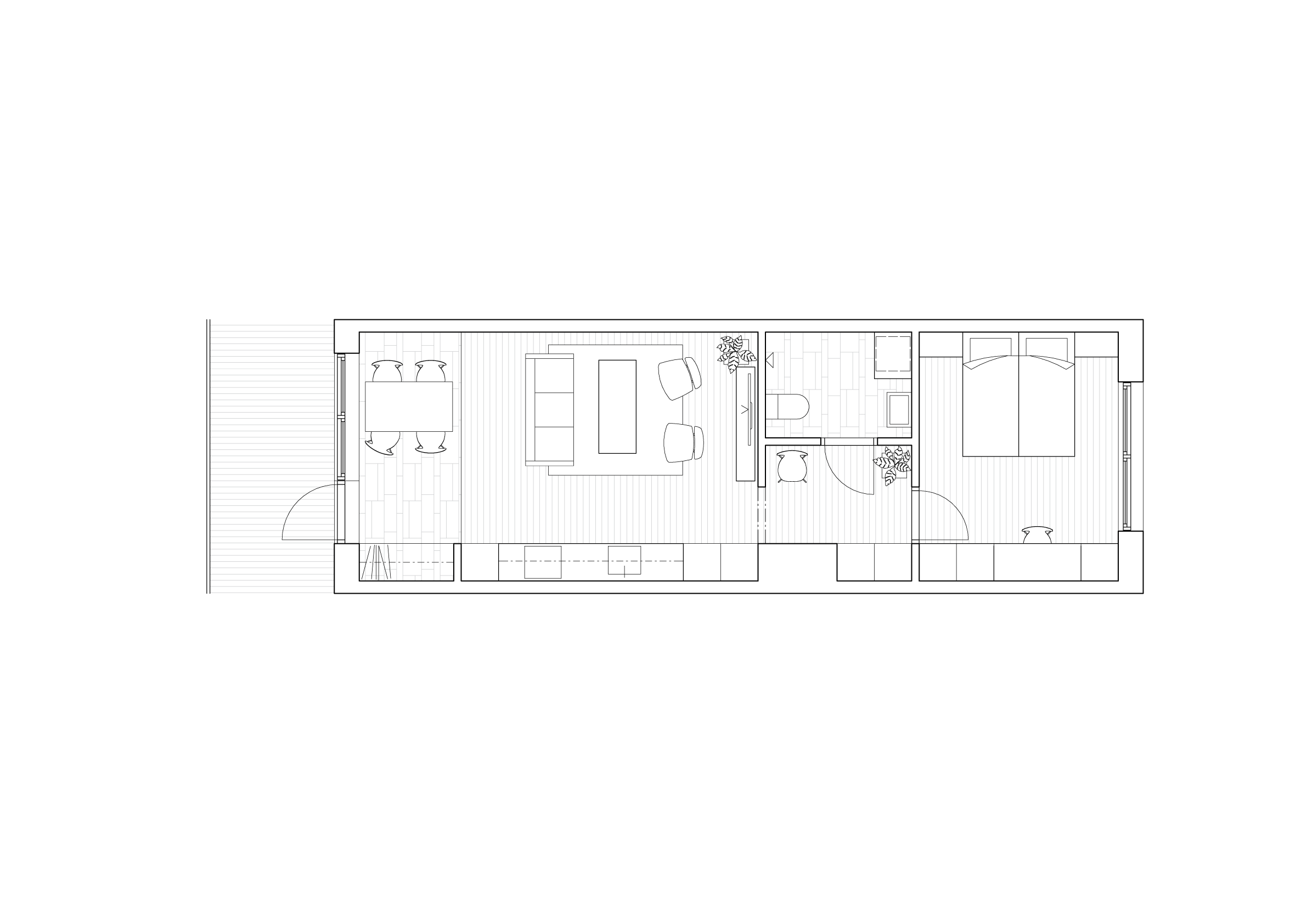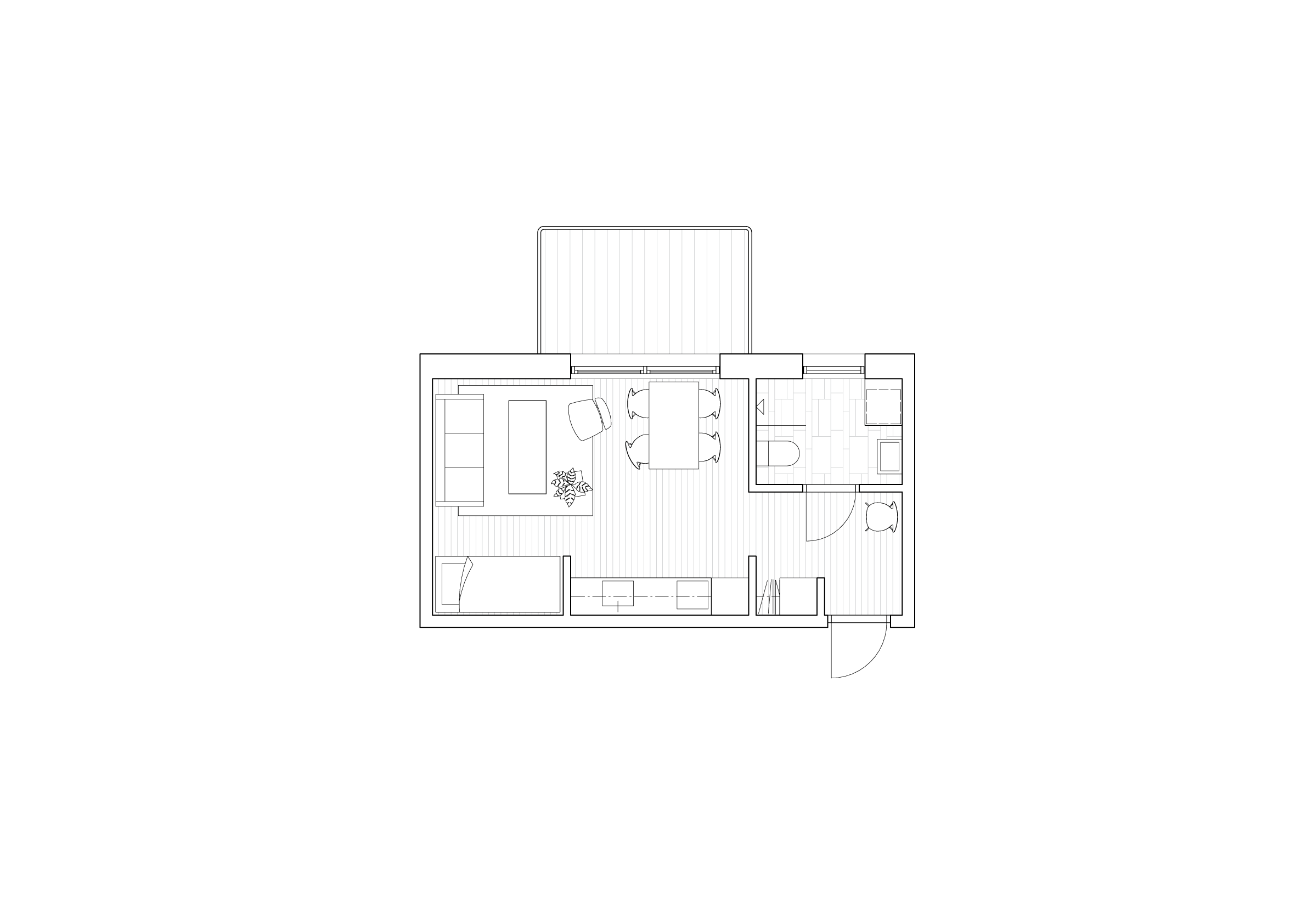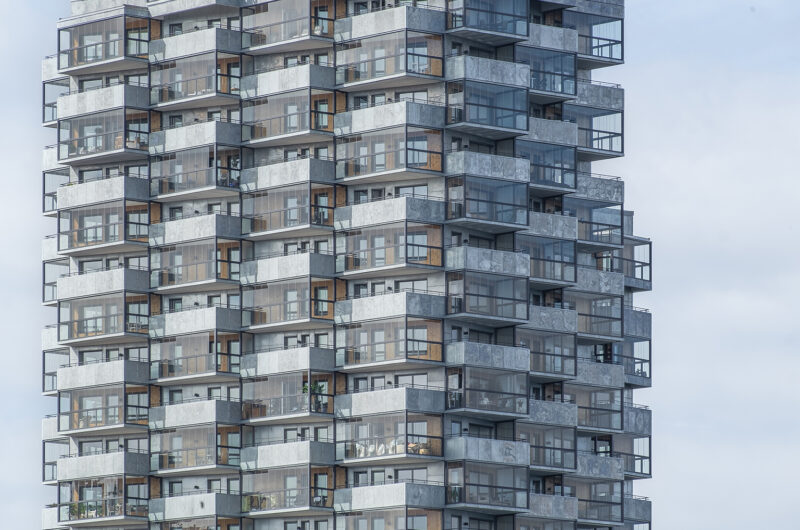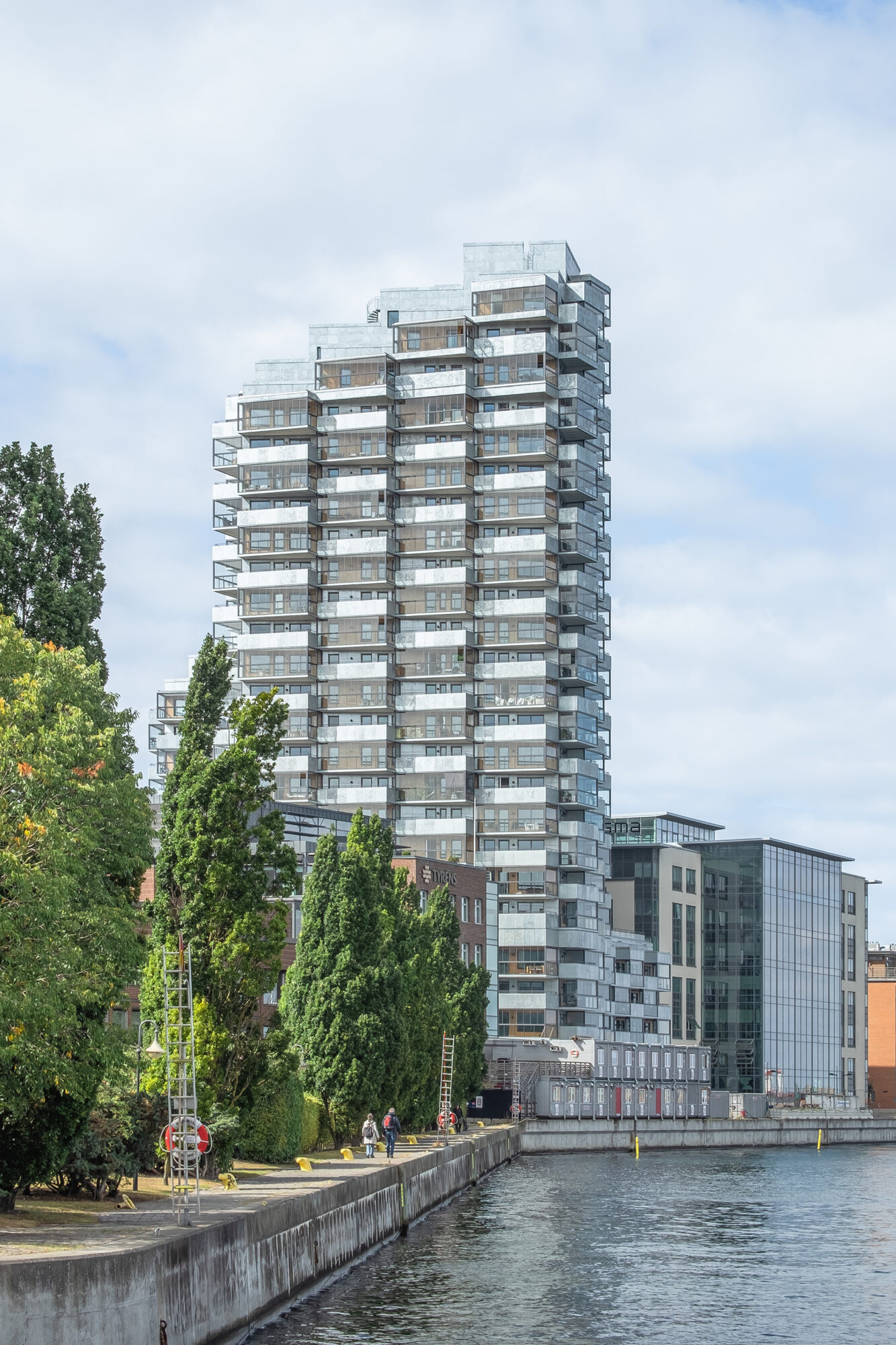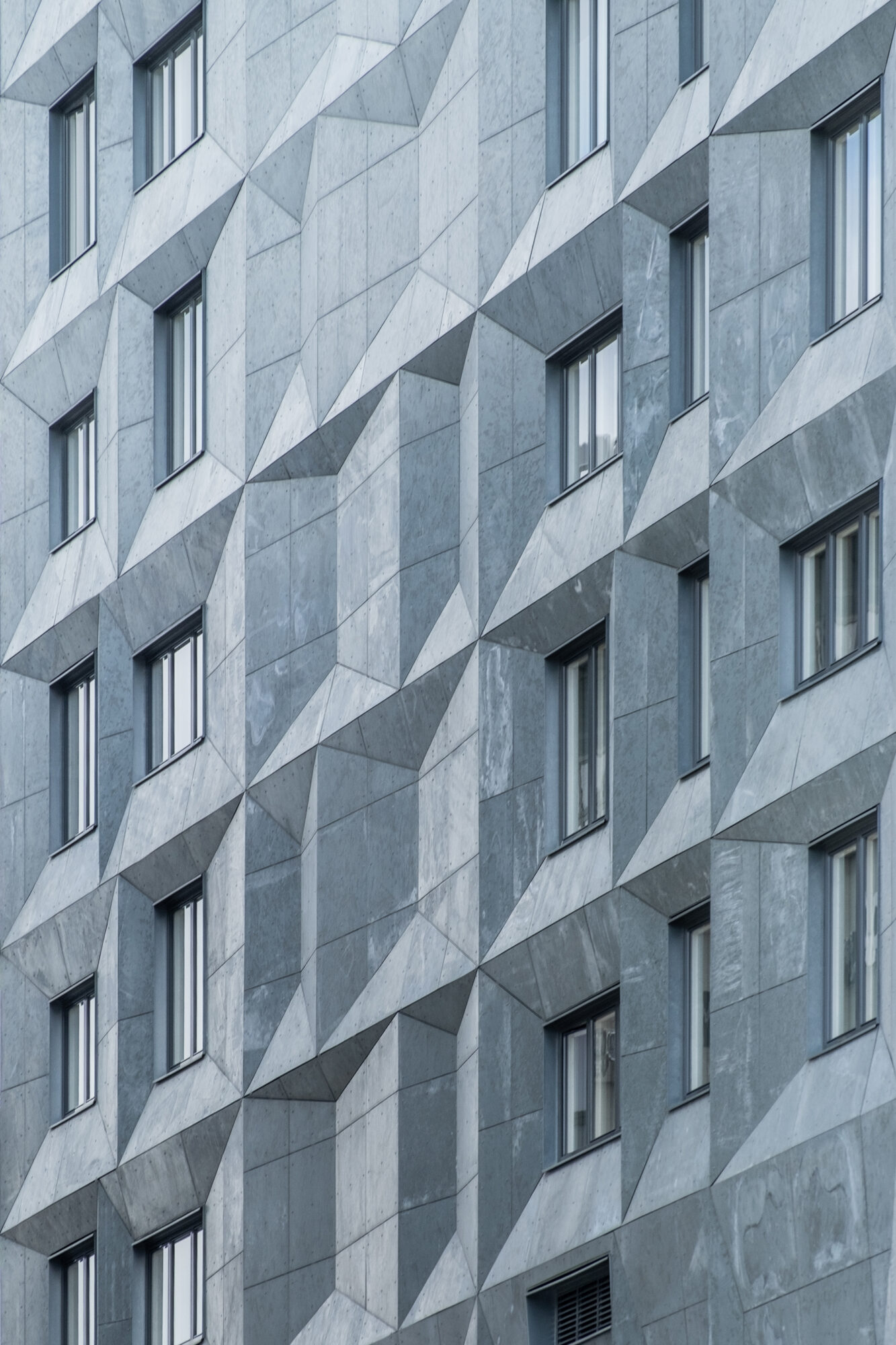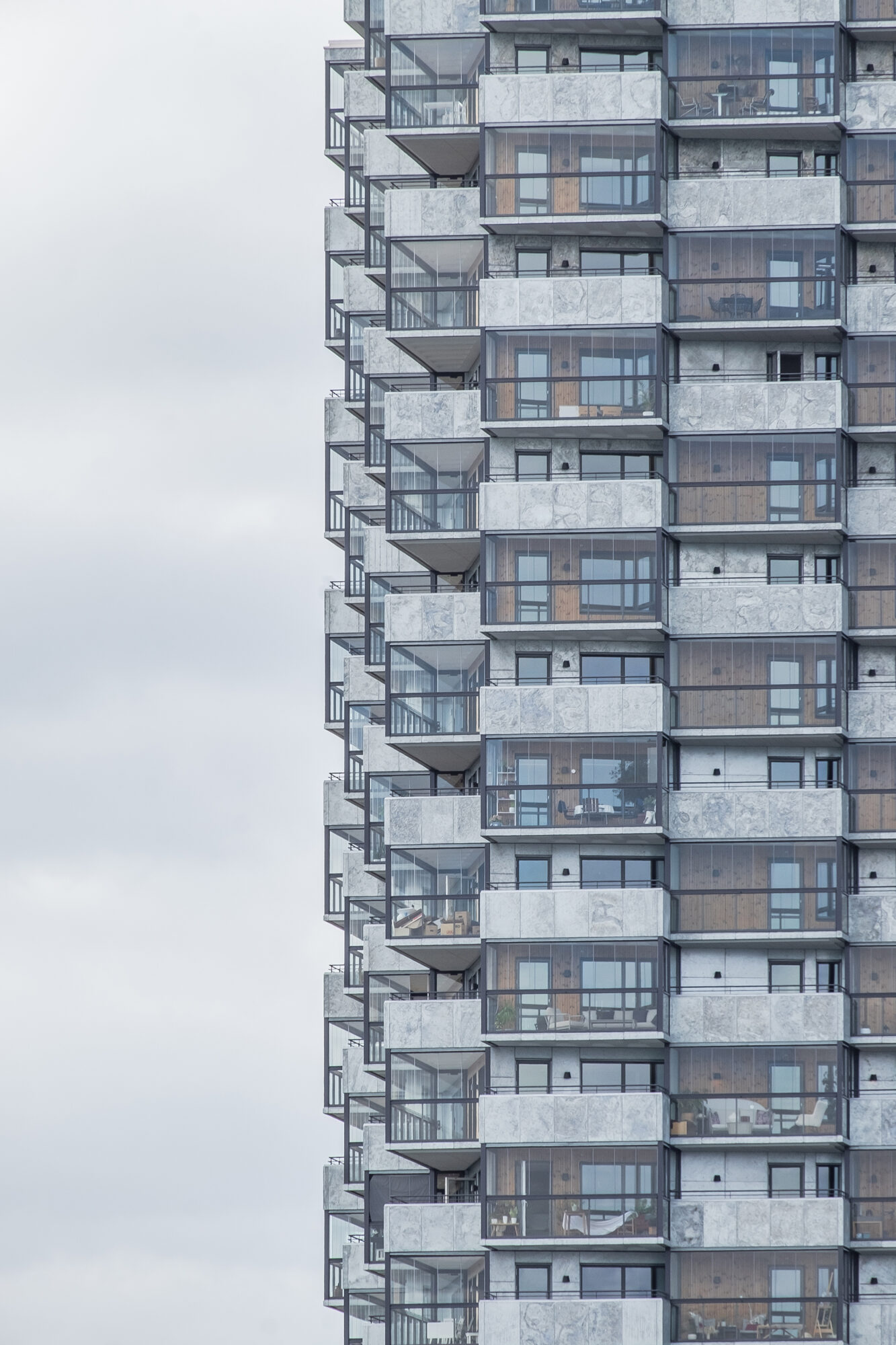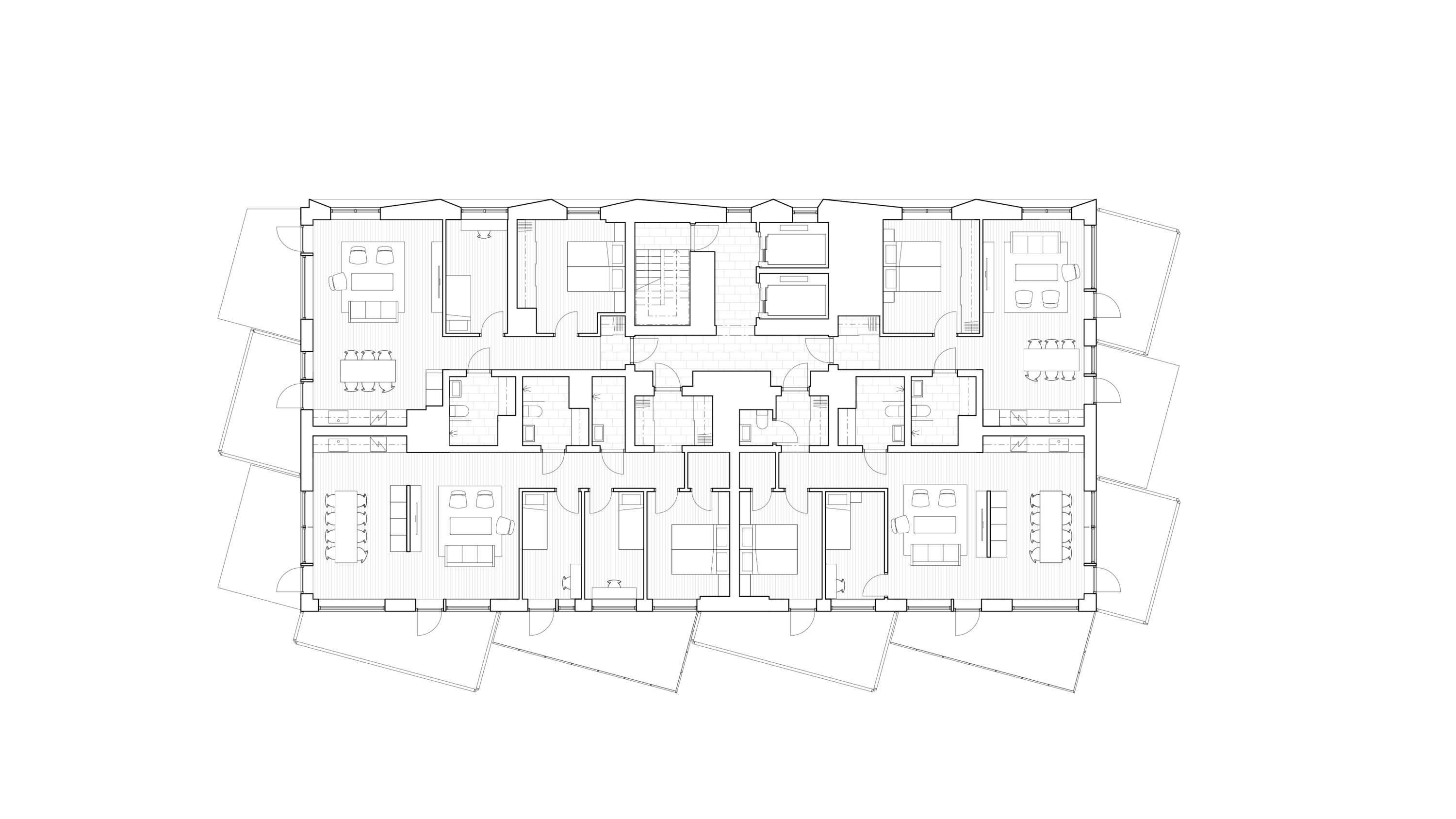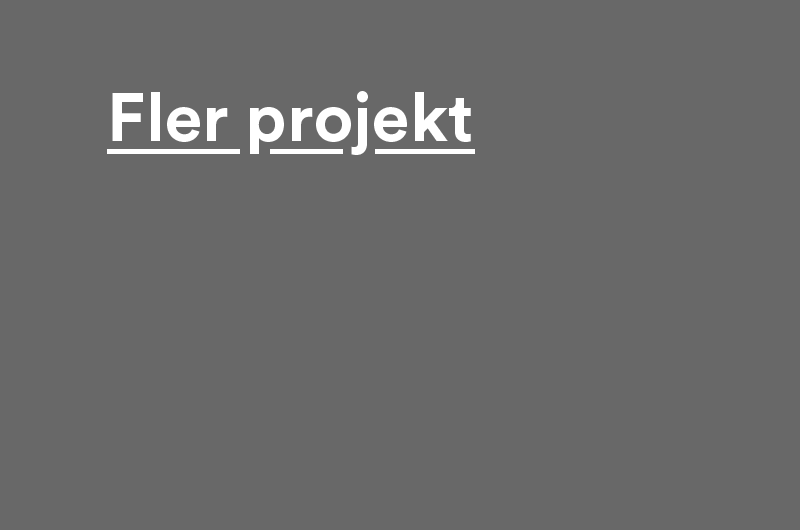Karlskrona Cultural School
Like the sea, culture is a gateway to the outside world and adventure - a path to something wonderful. The design of Karlskrona's new school of culture aims to meet and activate the city, to allow the journey and adventure of culture to take place in the new and varied urban spaces that the new buildings create.
Karlskrona's cultural school is a new layer in the city's fabric, but the secret kinship with the sea and shipping can still be sensed. Visitors are welcomed in through the old Dolphin Gate, where wild, imaginatively scaled dolphins show the way to a strange world.
The cultural school is integrated into the existing urban structure of Kalvhagen and forms an ensemble together with Palanderska gården and the office building. The building is designed as four clearly readable volumes with a fifth "space" between them. The four volumes vary in scale, height and width depending on their respective program content and relate to their specific location on the site. The volumes are highest to the west, towards Trossö, and step down to the east to meet Palanderska gården and the office building.
The main entrance is located to the east, centered in the axis towards the Palanderska courtyard and the space formed inside the Dolphin Gate becomes the School of Culture's courtyard and unifying front. Here there are opportunities for rest and play, but also teaching and events. Towards Thore Christoffersongatan there is a secondary entrance for staff and loading.
Towards the south, where the Spårgatan street opens out from the west, a square is created in the city. Here, the base of the building becomes a staircase where you can sit down in the sun. The square also has bicycle parking, a pick-up and drop-off function and stormwater management.
Hornsberg
In Hornsbergskvarteren on western Kungsholmen, plans are underway for around 890 new homes, sports halls and office premises. A significant part of block 1 consists of a new office building, integrated into the neighborhood town.
The building stretches along the entire length of Nordenflychtsvägen and forms a powerful and imposing front to the street. The design is contemporary but rooted in the older industrial architecture that existed on the site, and which to some extent remains, while adapting to the classic stone city.
The ground floor has a high degree of transparency with several entrances and is planned for outward-looking activities such as a restaurant and café. These are directly connected to the office building's main entrance, which provides the conditions for life and movement throughout the street level.
The top two floors are stepped, creating a classical tripartite base, body and crown that is connected to the surrounding blocks. The top penthouse is significantly recessed from the gables to make the corners of the block more flexible. The recess also allows for living roofs in the form of roof terraces.
The façade design is based on order, proportion and rhythm. The ambition is to create harmony with few elements and well-studied details. The design is linked to the industrial history of the site, but also to classic office buildings in Stockholm's inner city that relate elegantly to the urban space, such as Centrumhuset at the intersection of Sveavägen and Kungsgatan and the SLT building on Vasagatan.
The office building's consistent and strong design meets the parts of western Kungsholmen that still have industrial activities and thus creates a new context around Nordenflychtsvägen. The building connects in scale to the underlying residential neighborhoods and together with these creates a new cohesive whole.
The building is planned to be constructed predominantly with a load-bearing wooden frame. The wooden frame will be visible and readable even from the outside and can thus be said to contribute to the exterior experience of the building. Easily accessible bicycle parking and changing facilities on a separate floor with a separate bicycle entrance promote sustainable modes of transportation.
Olivin office building
Like a shimmering green rock, Olivin will shine as one of Stockholm's most attractive office buildings. After parallel assignments, FOJAB was commissioned to design the office building together with Skanska.
The Lindhagenskvarteren district in north-west Kungsholmen is one of the last major developments in the inner city of Stockholm. The development of Hornsberg involves over 5,000 new homes and 350,000 square meters of commercial space. The area will be linked to the urban structure of eastern Kungsholmen and previously separated islands of buildings will be brought closer together.
This is where the new Olivin office building plays an important role. When the triangular plot with Essingeleden on one side, Lindhagensgatan on the other and residential buildings on the third side is now being developed, a missing piece of the puzzle is finally in place. Olivin repairs the street space and strengthens the esplanade character of Lindhagensgatan with living facades on both sides.
Olivin will be a clear target point with content that attracts both professionals and visitors and creates new flows in the city. Olivin is a building for work, socializing and recreation with workplaces, social areas, a sauna and roof terraces. The entrance floor invites people along Lindhagensgatan with public spaces on the ground floor. The offices start one level up but trickle down to the ground floor with shared spaces and activities that create an active building and a safer street space.
The building's design is inspired by the green stone olivine and its angular, slightly sharp shape. The prism as a geometric figure recurs in all scales, in folds and reliefs on the facade and in the division of the 23,000 square meter volume into several smaller units. The building is higher towards Essingeleden, while stepping down towards the small-scale development to the southeast. The corners are cut to create a more inviting form that better relates to Stockholm's classical building order. The facade of shimmering green zinc and the glazed ceramics of the plinth floor catch the light and create a variation over the day and contribute to the overall image of a monolith. A green rock.
Olivin will be environmentally certified according to LEED Platinum. Parts of the frame are planned to be built in wood. The building will be ready for occupation in 2026.
Hyllie hybrids
The Hyllie Hybrid is a pilot project that pushes the boundaries of flexibility and multi-use to increase the lifespan of the building.
Today, our buildings basically serve a single function. A residential building is a residential building. An office building is an office building. Planning legislation and building regulations make it difficult to mix functions in the same property. As needs shift and the market changes, property owners find it difficult to adapt their building - with the climate being the big loser.
Hylliehybriden is a pilot project that challenges current regulations, economic models and the detailed planning process in order to increase the life of the building and thus its sustainability. The multifunctional building is the result of research and development work between the architectural offices FOJAB and smogstudio and the real estate developer Fler bostäder.
The building is exceptionally flexible thanks to a simple modular structure and rooms that meet all the requirements for housing, offices and hotels. The building can have multiple functions - simultaneously. Rooms can be assembled into larger or smaller units and easily changed over time and as needed. When the children have moved out, part of the apartment can be split off and rented out as an office, for example.
The building's framework is a strict and repetitive modular division for residential units of 55 sqm or office use with one or more merged modules. The dynamic of the hybrid concept lies in the interaction and variation over time between these functions. The idea is based on a more sustainable and flexible use of building structures both in new construction and in existing structures. The units are accessed from the attic corridor and can be joined together through prepared openings in the partition walls. In this way, the change of function between residential and office can be done in a controlled and predetermined way, always following the same principle.
At the same time, the Hyllie Hybrid adds new qualities to the site. The ground floor has high transparency with premises for trade and gastronomy. It also accommodates passage from Hyllie Boulevard through the building volume to more clearly connect to the city's neighborhood alleys, promote the flow of movement and counteract a closed neighborhood character.
The mix of activities provides good conditions for a vibrant neighborhood and meetings between people. The corner space has been designed as a public meeting place, a node in the city that creates identity and can be used by everyone. The ground floors have been designed to support a living city, sight lines and levels open up and create curiosity. The urban dimension of the building contributes to a robust and multifaceted community building.
Keldur
The City of Reykjavik wants to set a new standard in urban development with the Keldur district. FOJAB and Ramböll won the open international competition with their proposal. Crafting Keldur - Where Art, Science & Recreation Unite.
The competition brief was to produce a development strategy for the Keldur district in eastern Reykjavik. Within a few years, Keldur will be served by a high-quality bus transport system connecting the district with Reykjavik city centre and other important locations in the capital area. According to the city, the new district will be characterized by sustainable mobility, circularity, energy transition and climate-neutral construction.
The proposal is based on climate neutrality and climate considerations. This places special demands on urban planning and dense mixed-use development, of which there is very little in Iceland today. The buildings keep to a human scale - three to five floors - but are sufficiently dense and cohesive to create a vibrant and dynamic city.
The jury for the competition was particularly attracted by the fact that FOJAB's proposal was clearly rooted in the site and that the conditions of the landscape with greenery and water have been taken advantage of, and that the land is used efficiently. As well as forward-looking ideas about mobility and a flexible block structure. The strategies for achieving a social mix were also considered convincing.
The jury said that FOJAB's proposal responds very well to the needs and requirements of the new urban neighborhood in Reykjavik. An urban district close to nature, where the three stops of the Borgarlín express bus will be the backbone of sustainable urban transportation.
FOJAB now continues to further develop the proposal in a future planning process, with physical plans and Urban Development Programs.
Vänersborg District Court
FOJAB is designing a new court building in Vänersborg - a sharply cut volume that has been processed in relation to its program content and at the same time relates to its urban situation.
THE PLACE
The new court is located directly adjacent to one of Vänersborg's most important entrances and clearly advertises itself as you move along Edsvägen towards the city center. The court will be part of a context of solitary institutional buildings such as Gamla Lasarettet with, among other things, Vänerparkens skola and Habiliteringsmottagningen and Trons kapell.
The new court building contributes to the transition between the block structure of the city center and the green park environment. The three-storey building opens up to the south and interacts with the park. New trees and plantings further strengthen the connection. The building's entrances for the various needs of the business are oriented in relation to safety, function and flows.
HUMANITY
By withdrawing the building from the property line, surfaces are created that meet people's need to stay and move around the new court building. The base will be terraced to manage height differences and to increase the quality of the streetscape. We establish plantings with terraced seating-friendly retaining walls that also enhance orientation.
The main entrance is marked by a large tree and three-storey glazing and the recessed volume. A successive sequence of entrances and a respectful entrance square allow people to enter, stay and leave the building in a dignified manner. The court's generous waiting room is located one floor up. The facade opens up with large areas of glass, exposing the interior of the building, and the public spaces interact with the park space on the opposite side of the street. The fact that the public areas are located one floor above street level provides a distance and a respectful distance that creates integrity for the sensitive situation that visitors to the building may find themselves in.
The court building houses around 130 workplaces, 11 courtrooms, including two security rooms, security control with an adjoining reception area, public areas, staff offices, transport and rooms for detainees. The district court will have separate entrances to all rooms and separate flows throughout the building, with separate escape routes.
FORMS
The building's design language is basically simple, where the volume is processed with a few character-creating touches. This without losing the weight and authority required to be an important representative of a sound legal system.
A green ceramic façade defines the identity of the court building and its relationship to the city, with its green copper roofs and the greenery of the surrounding parkland. The ceramic panels are slightly curved, creating effective shadows on the facade - a bit like the ripple of water on Lake Vänern. Beauty is combined with durability and efficient construction.
The facade is designed with horizontal bands that give a clear presentation of the room volumes inside. Vertical profiles that create a rhythm in relation to the underlying program and between these alternate glass and dense areas, well balanced to handle views, daylight and the high environmental ambitions. The desired degree of transparency and privacy is also regulated here. With a rational modular system and a high degree of prefabrication in the facade and frame, the building's complex program and volumes are managed.
Gränden
Offerkällan is a popular Million Program area in northern Lund with two-story apartments designed by Sten Samuelsson and Fritz Jaeneke. FOJAB has been commissioned by Lund's municipal real estate company, LKF, to develop Offerkällan with eight new buildings called Gränden.
It has been important to take advantage of the fine qualities of the area and at the same time improve what does not work as well. With well-balanced placement, strong form and high quality materials and detailing, the new houses have become a boost for the whole area.
In classic sixties fashion, the road through Offerkällan was lowered into a ditch. Traffic was kept separate from the residents, but it also meant that the area was effectively split in two. To heal the two parts, six of the new houses have been placed along the previously submerged road. What used to be a desolate asphalt ditch with garage entrances for cars has been transformed into a safe and pleasant urban street for pedestrians and multiple modes of transport with more and different types of entrances, windows and porticos.
The new development is higher than the existing one, but connects to the lower buildings through a two-storey arm at one end of the street. Townhouses on the ground floor provide nice micro-environments and an increased variety of housing qualities. Porticos across the buildings create new sight lines, increase transparency and open up the area.
The houses are built with solid, genuine materials that will age beautifully and last a long time. The level of detailing is consistently high, for example with roll changes on the cold walls, which means that no sheet metal coverings are needed. The high quality can be seen and felt, these are houses that can be approached.
Named the best new construction project in the public sector in 2023.
Finalist for the CBA Housing Award 2023
Hofs park preschool
Hofs park preschool in Växjö is a stylish, fun and playful little gem. Completely unique in its expression and with a strong focus on children.
The environments are rich in experiences, even for younger children. The facade with its large dens can be partially climbed, and indoors there are lofts and huts to play in. At the same time, the preschool is a safe place and a work-friendly environment with good light and surfaces that are easy to monitor.
The preschool with five departments is built in solid wood, which gives a warm, cozy and genuine feeling with a pleasant sound environment. The level of detail is high with fine material encounters.
The preschool is part of a larger development area that also includes sheltered housing and housing. The buildings form a ring around a communal park. FOJAB is responsible for the design of both buildings and landscape as a result of a land allocation competition.
Factories
The idea for The Factory was born out of a desire to recreate the qualities of old factory environments converted into offices.
High ceilings, robust and hard-wearing materials, visible installations and large, mullioned glass sections give Fabriken both a retro feel and make the building well equipped for the changing needs and new demands that will be placed on attractive premises in the future.
The façade is characterized by simplicity and the dominant material is recycled brick. It is almost as if an old factory has been dismantled and rebuilt. The building is climate calculated according to the LFM30 methodology and has been certified according to Miljöbyggnad.
The Fabriken office building has been built together with The Sun Quarter Mobility House.
Masthead quay
The formerly closed harbor environment at Masthuggskajen is being transformed and Järntorget's role as Gothenburg's creative heart is being consolidated. With a new peninsula in the Göta River Sheep Linnaeus City finally direct contact with the river and the city a new quayside. At the end of the peninsulan two residential blocks will be built, where we design the eastern after winning the competition.
Six distinctive volumes with a stepped form create a strong shape towards the river and meet Masthuggskajen's new skyscrapers. Closest to the river, a free-standing harbor palace is formed within the block, whose release from the rest of the building creates exciting urban spaces, a square facing the moat and exceptional premises for restaurant and café activities. The block consists of two properties, and houses both condominiums and rental apartments - penthouses as well as well-arranged studios. The neighborhood stages the meeting between city and river, and becomes a natural part of the southern riverside's new cityscape.
The site is Gothenburg's historic outskirts, where visitors once encountered customs and fortifications. The last remaining bastion of Gothenburg can still be seen from the district's roof terraces. Just off the peninsula used to be Gothenburg's iron scale, and in the moat, ships carrying building materials arrived at Röda Bryggan - named after the sand and red bricks stacked there waiting to be laid. The rich material history of the site colors the block, combining wrought iron details with red brick and brick in varying tones of straw and sand. The stone floor of the quay plays into the block in varied patterns and designs.
The block's cross-section is a stylized archipelago cliff. As the peninsula is extended into the river, it is easy to create areas below ground level - and the courtyard can accommodate generous spaces for public or neighborhood functions. At ground level, the courtyard is surrounded by an arcade - a sheltered space that links housing with a laundry lounge, bicycle room and other common functions of the neighborhood.
The Masthuggskajen neighborhood is a love letter to Gothenburg. In places where it blows and rains, intimate urban spaces become particularly important, and here several are created. It is an urban, generous neighborhood, in a new hub between river, city and port.
Docks
At the entrance to the harbor stands Docks, Malmö's new landmark. Two slender buildings that from certain angles seem to merge. Glazed balconies hover over the dock like the control cabins of the cranes that once appeared at the Kockum shipyard.
The characteristic feature of the Docks is the two tapered towers that relate to their surroundings in shape and height. In the east towards the harbor basin, the building is at its highest, 26 floors. Towards Dockplatsen and the guest harbor, it steps down to 18 floors, ending in a 5-story base that connects to the surrounding buildings and Isberg Street.
The new building closes the Dock Square to the east, creating a sheltered space where the folded and stepped shape of the Dock dampens the winds from the sea. The towers angle themselves to meet different urban spaces, and at the same time mark the eastern and western gates of the block.
On the ground floor there are public spaces for services, shops and restaurants. An atrium, accessible from all commercial spaces, is the heart and focal point of the building. The upper part houses wood-clad galleries leading to residential units, guest apartments and community rooms.
The building bodies are clad with balconies with a weather-resistant and robust façade of hot-dip galvanized sheet metal. Galvanization provides a crystalline coating that protects the metal while providing subtle shifts in tone and sheen. The joints of the sheet metal play with the rhythm of the balcony edges and on the northern facades the sheet metal folds like salt crystals. The expression is sharp, nuanced and rooted in the history of the site.
There are a total of 157 apartments in the building and a garden has been created on the roof of the base with terraces that are shared by the residents. Facing southwest, there is a sun shelf with plenty of shelter and a lush beach landscape. Seating areas, winding paths and wooden bridges link the terraces.
The exterior and interior of Docks are very different. Inside the cool sheet metal facade, you are greeted by warm lighting and wood. Here too, there is an association with shipping and the many ships once built at the Kockum shipyard, whose metal hulls concealed cozy wooden cabins.
